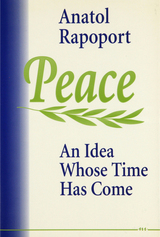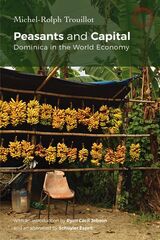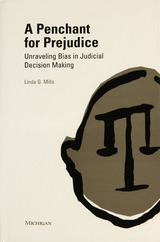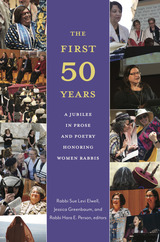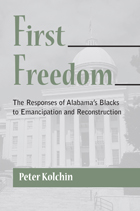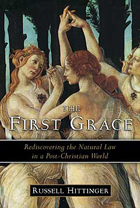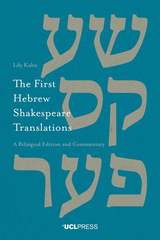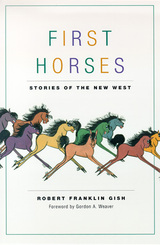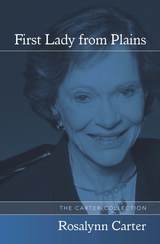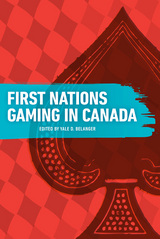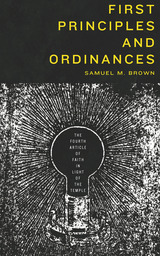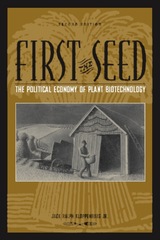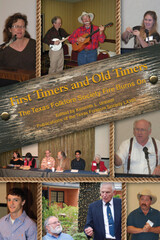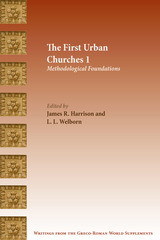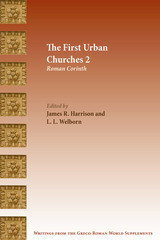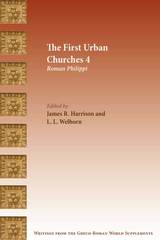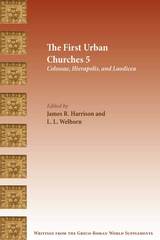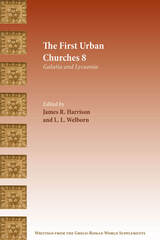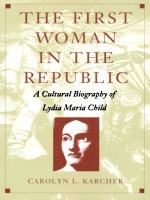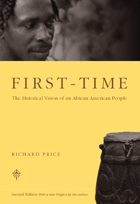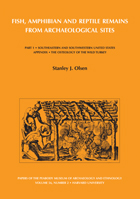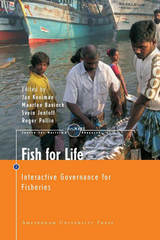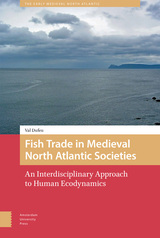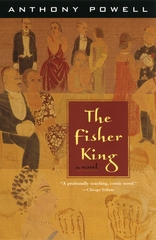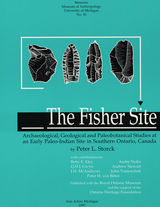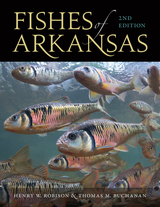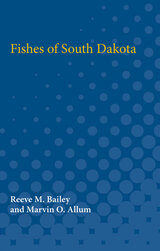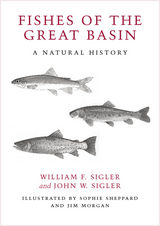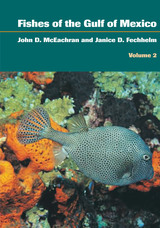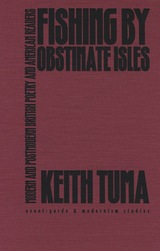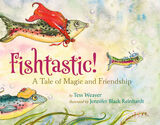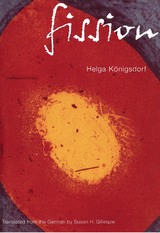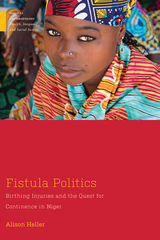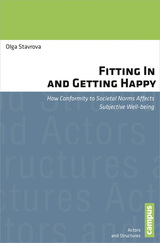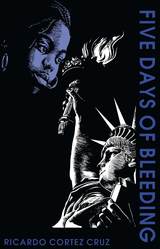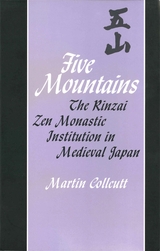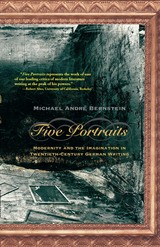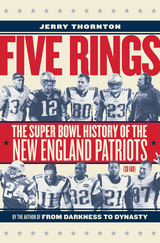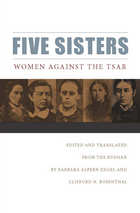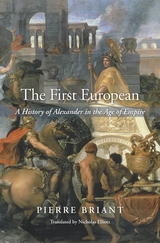 The First European: A History of Alexander in the Age of Empire
Pierre Briant
Harvard University Press, 2017 The exploits of Alexander the Great were so remarkable that for centuries after his death the Macedonian ruler seemed a figure more of legend than of history. Thinkers of the European Enlightenment, searching for ancient models to understand contemporary affairs, were the first to critically interpret Alexander’s achievements. As Pierre Briant shows, in the minds of eighteenth-century intellectuals and philosophes, Alexander was the first European: a successful creator of empire who opened the door to new sources of trade and scientific knowledge, and an enlightened leader who brought the fruits of Western civilization to an oppressed and backward “Orient.”
In France, Scotland, England, and Germany, Alexander the Great became an important point of reference in discourses from philosophy and history to political economy and geography. Voltaire, Montesquieu, and Robertson asked what lessons Alexander’s empire-building had to teach modern Europeans. They saw the ancient Macedonian as the embodiment of the rational and benevolent Western ruler, a historical model to be emulated as Western powers accelerated their colonial expansion into Asia, India, and the Middle East.
For a Europe that had to contend with the formidable Ottoman Empire, Alexander provided an important precedent as the conqueror who had brought great tyrants of the “Orient” to heel. As The First European makes clear, in the minds of Europe’s leading thinkers, Alexander was not an aggressive militarist but a civilizing force whose conquests revitalized Asian lands that had lain stagnant for centuries under the lash of despotic rulers.
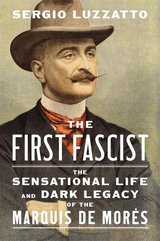 The First Fascist: The Sensational Life and Dark Legacy of the Marquis de Morès
Sergio Luzzatto
Harvard University Press A vivid biography of the nineteenth-century French-Italian aristocrat Marquis de Morès, the first political leader to master the blend of racialized hatred, cross-class solidarity, and paramilitary violence that Benito Mussolini would call “fascism.”
The Marquis de Morès was the first populist, white supremacist, and openly antisemitic leader in the Western world. A key figure behind the Dreyfus affair, he took France by storm with his inflammatory rhetoric, media savvy, and violent stunts. Decades before Mussolini, Morès invoked the fasces—the ancient Roman bundle of wooden rods—to symbolize the society he wished to create: a union of all social classes against their enemy, the Jews.
Animated from his early years by personal ambition and the loss of aristocratic status in modern, democratic France, Morès embarked on an extraordinary career spanning four continents. He ventured to the American frontier and became a cattle rancher in the Dakotas; he set out to build a railway in the jungles of Indochina. But his efforts were dogged by failure—and he blamed Jewish machinations for his defeats. Embittered, he returned to France to pursue what he saw as the mission of an upper-class Frenchman: to fight Jews and other minorities on behalf of the white proletariat. Soon he controlled a large, violent militia of disgruntled workers.
As Sergio Luzzatto makes clear, Morès both anticipated and propelled the fascist politics that erupted in the twentieth century and still resonate powerfully in our own time. Morès’s rapid political rise was halted by financial scandal, but his shadow continued to loom. In Vichy France, as Jews were being deported to Auschwitz, officials would gather to celebrate Morès’s memory.
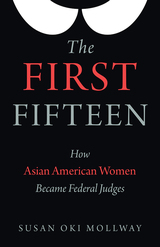 The First Fifteen: How Asian American Women Became Federal Judges
Susan Oki Mollway
Rutgers University Press, 2022 In 1998, an Asian woman first joined the ranks of federal judges with lifetime appointments. It took ten years for the second Asian woman to be appointed. Since then, however, over a dozen more Asian women have received lifetime federal judicial appointments.
This book tells the stories of the first fifteen. In the process, it recounts remarkable tales of Asian women overcoming adversity and achieving the American dream, despite being the daughters of a Chinese garment worker, Japanese Americans held in internment camps during World War II, Vietnamese refugees, and penniless Indian immigrants. Yet The First Fifteen also explores how far Asian Americans and women still have to go before the federal judiciary reflects America as a whole.
In a candid series of interviews, these judges reflect upon the personal and professional experiences that led them to this distinguished position, as well as the nerve-wracking political process of being nominated and confirmed for an Article III judgeship. By sharing their diverse stories, The First Fifteen paints a nuanced portrait of how Asian American women are beginning to have a voice in determining American justice.
The First Fifty Years: A Jubilee in Prose and Poetry Honoring Women Rabbis
Rabbi Sue Levi Elwell, Jessica Greenbaum, Rabbi Hara E. Person
Central Conference of American Rabbis, 2023 The ordination of Rabbi Sally J. Priesand in 1972 was a watershed moment in Jewish history. In The First Fifty Years, contributors from across the Jewish and gender
spectrums reflect on the meaning of this moment and the ensuing decades, both personally and for the Jewish community. In short pieces of new prose, authors—
many of them pioneering rabbis—share stories, insights, analysis, and celebrations of women in the rabbinate. These are intertwined with a wealth of poetry that
poignantly captures the spirit of this anniversary. The volume is a deep, heartfelt tribute to women rabbis and their indelible impact on all of us.
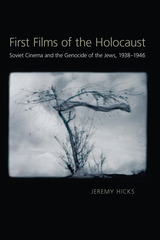 First Films of the Holocaust: Soviet Cinema and the Genocide of the Jews, 1938–1946
Jeremy Hicks
University of Pittsburgh Press, 2012 Most early Western perceptions of the Holocaust were based on newsreels filmed during the Allied liberation of Germany in 1945. Little, however, was reported of the initial wave of material from Soviet filmmakers, who were in fact the first to document these horrors. In First Films of the Holocaust, Jeremy Hicks presents a pioneering study of Soviet contributions to the growing public awareness of the horrors of Nazi rule.
Even before the war, the Soviet film Professor Mamlock, which premiered in the United States in 1938 and coincided with the Kristallnacht pogrom, helped reinforce anti-Nazi sentiment. Yet, Soviet films were often dismissed or even banned in the West as Communist propaganda. Ironically, in the brief 1939–1941 period of Nazi and Soviet alliance, such films were also banned in the Soviet Union, only to be reclaimed after the Nazi attack on the Soviet Union in 1941, and suppressed yet again during the Cold War.
Jeremy Hicks recovers much of the major film work in Soviet depictions of the Holocaust and views them within their political context, both locally and internationally. Overwhelmingly, wartime films were skewed to depict Soviet resistance, “Red funerals,” and calls for vengeance, rather than the singling out of Jewish victims by the Nazis. Almost no personal testimony of victims or synchronous sound was recorded, furthering the disconnection of the viewer to the victims.
Hicks examines correspondence, scripts, reviews, and compares edited with unedited film to unearth the deliberately hidden Jewish aspects of Soviet depictions of the German invasion and occupation. To Hicks, it’s in the silences, gaps, and ellipses that the films speak most clearly. Additionally, he details the reasons why Soviet Holocaust films have been subsequently erased from collective memory in the West and the Soviet Union: their graphic horror, their use as propaganda tools, and the postwar rise of the Red Scare in the United States and anti-Semitic campaigns in the Soviet Union.
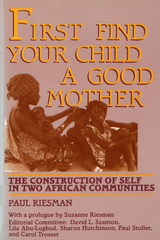 First Find Your Child a Good Mother: The Construction of Self in Two African Communities
Riesman, Paul
Rutgers University Press, 1992 Through a systematic comparison of the life circumstances, child-rearing practices, and personalities of the FulBe and their former slaves, the RiimaayBe, this book develops an alternative theory of the way personality is formed in the Fulani society of West Africa. Riesman discusses the different characters, economies, and life plans of adult men and women of both groups, focusing on their ideas about the value of relatives. He further presents detailed observations of child-rearing practices, and concludes that the FulBe and RiimaayBe do not differ in these practices. Contrasting Fulani and Western notions of parenting, he suggests that child-rearing practices are themselves irrelevant to the formation of adult personality, but that a people's ideas about the meaning of life, social relations, and the development of character are very important. Finally, Riesman outlines a sociocultural theory of personality and its formation, and uses this theory to make sense of the differences between FulBe and RiimaayBe.
 The First Fleets: Colonial Navies of the British Atlantic World, 1630–1775
Benjamin C. Schaffer
University of Alabama Press, 2025 A revealing study on the little-known and misunderstood provincial navies established by North American British colonists In The First Fleets, Benjamin C. Schaffer reveals how, contrary to widespread beliefs, the American colonies had a long tradition of independent naval defense decades before the Revolution. He demonstrates that Anglo-American governments established and maintained significant provincial naval forces and that the history of provincial navies illuminates broader aspects of colonial history and the colonies’ ultimate break with the British Crown. Based on meticulous research, Schaffer recounts the sea-borne threats that American colonies faced from the French, Spanish, pirates, and others. He reviews colonial governance and the relationships between colonial governments and Great Britain. Highlighting Britain’s scant naval power in North America, Schaffer demonstrates how the vulnerable coastal colonies undertook their own self-defense. Schaffer’s readable study offers many fascinating episodes from colonial history. Establishing a navy was controversial in pacifist-minded, Quaker-dominated Pennsylvania. South Carolina deployed its scout-boat navy to pursue enslaved Africans who fled colonial capture. The first paper money issued in North America was an initiative to pay for a naval expedition against French Quebec in 1690. These and other episodes show the intimate connection between these little-known provincial navies and the major sociopolitical developments of their day. The First Fleets will be of great interest to historians and readers of early American history, particularly colonial maritime and naval activities. Readers interested in the political and military dynamics of pre-Revolutionary America, as well as enthusiasts of naval history and maritime trade, will find The First Fleets both a valuable resource and an engrossing narrative.
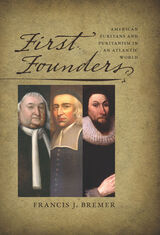 First Founders: American Puritans and Puritanism in an Atlantic World
Francis J. Bremer
University of New Hampshire Press, 2012 Francis J. Bremer has spent his entire career broadening our understanding of America’s colonial founders. Now, in this eminently readable collection of biographies, Bremer brings us a surprisingly varied and dynamic group of characters who continue to guide and influence America today. With its cast of magistrates, women, clergy, merchants, and Native Americans, First Founders underscores the breadth of early American experience and the profound transatlantic roots of our country’s forebears. Bremer succeeds in bringing little-known figures out of the shadows, while allowing us to appreciate better known figures in an entirely new light.
This is a truly fascinating look at the Puritans with keenly drawn portraits and the insight that only a lifetime of scholarship can achieve. It should become the standard introduction to the field. Written in the mold of Joseph Ellis’s Founding Brothers and Gordon Wood’s Revolutionary Characters, the book will appeal to general readers, students, and scholars alike.
First Freedom: The Responses of Alabama's Blacks to Emancipation and Reconstruction
Peter Kolchin
University of Alabama Press, 2008 Crucial changes occurred during the years following the Civil War as blacks manifested their desire to live as independently as possible and to reject every social relation reminiscent of slavery. This classic study of the history of post-slave societies helped to initiate historiographic trends that remain central to the study of emancipation.
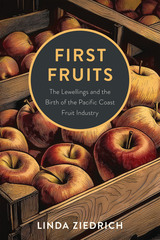 First Fruits: The Lewellings and the Birth of the Pacific Coast Fruit Industry
Linda Ziedrich
Oregon State University Press, 2025 First Fruits offers a fascinating look at the lives of Pacific Coast horticulturists Henderson, Jonathan, and Seth Lewelling. Traveling across the Overland Trail—Henderson to Oregon in 1847, with a wagonload of fruit trees, and Seth and John to California three years later—the brothers would establish themselves as pioneers in the West’s growing fruit industry. By recounting how Henderson planted the first orchard of grafted fruit trees in Oregon, how Seth originated the Black Republican and Bing cherries, and how John led the development of the Napa Valley wine industry, First Fruits preserves the Lewellings’ place in history. However, the Lewellings were not simply planters, grafters, and breeders. They were also adventurers, colonists, gold seekers, reformists, and explorers—experiencing firsthand the westward expansion of the nation. Their stories provide a unique glimpse into the social, economic, and political history of the day. From their Quaker upbringing in North Carolina and Indiana to Henderson’s attempt to start a utopian colony in Honduras, John’s efforts to grow the Grange in California, and Seth’s contribution to democratic reforms in Oregon, the Lewellings’ legacy extends far beyond their agricultural endeavors. In the first biography to reclaim the brothers’ histories, Linda Ziedrich splendidly captures their dedicated support of one another and their communities, their contributions to the development of the modern fruit industry, and their lasting influence on the cultivation of fruits synonymous with the Pacific Coast region.
 A First Glance at St. Thomas Aquinas: A Handbook for Peeping Thomists
Ralph McInerny
University of Notre Dame Press, 1989 Thomism is solidly based on the assumption that we know the world first through our senses and then through concepts formed on the basis of our sense experience. In this informally discursive introduction to St. Thomas Aquinas, Ralph McInerny shows how this basic assumption contrasts with dominant modern alternative views and is developed by Thomas into a coherent view of ourselves, of knowledge, and of God.
McInerny first places Thomism in context within philosophical inquiry, discussing the relationship between philosophy and theology, and between modern and classical views of philosophy. He then describes the challenges Thomas faced with the introduction of Aristotle’s works into the Christian West. The reader is subsequently guided through such key concepts as art, nature, causes, and motion and shown how Thomas used these concepts to resolve the problems presented by Aristotle.
Each chapter is tied to a specific Thomistic text, providing a sample from a number of Thomas’s works. In addition to articles from both Summas, there are sections from the Disputed Questions and the Commentaries, among others. McInerny also provides an annotated list of the writings of Thomas available in English. Bibliographical notes provided by the author, grouped by subject and following his general chapter divisions, will be particularly helpful for further reading.
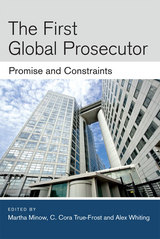 The First Global Prosecutor: Promise and Constraints
Martha Minow, C. Cora True-Frost, and Alex Whiting, editors
University of Michigan Press, 2015 The establishment of the International Criminal Court (ICC) gave rise to the first permanent Office of the Prosecutor (OTP), with independent powers of investigation and prosecution. Elected in 2003 for a nine-year term as the ICC’s first Prosecutor, Luis Moreno Ocampo established policies and practices for when and how to investigate, when to pursue prosecution, and how to obtain the cooperation of sovereign nations. He laid a foundation for the OTP’s involvement with the United Nations Security Council, state parties, nongovernmental organizations, victims, the accused, witnesses, and the media. This volume of essays presents the first sustained examination of this unique office and offers a rare look into international justice. The contributors, ranging from legal scholars to practitioners of international law, explore the spectrum of options available to the OTP, the particular choices Moreno Ocampo made, and issues ripe for consideration as his successor, Fatou B. Bensouda, assumes her duties. The beginning of Bensouda’s term thus offers the perfect opportunity to examine the first Prosecutor’s singular efforts to strengthen international justice, in all its facets.
The First Grace: Rediscovering the Natural Law in a Post-Christian World
Russell Hittinger
Intercollegiate Studies Institute, 2007 Whether discussing the nature of liberalism, the constitutional and moral problems posed by judicial usurpation, or the dangers of technology, Russell Hittinger convincingly argues in The First Grace that in our post-Christian world it is more crucial than ever that we recover older, wiser notions of the concepts of freedom and law.
First Hebrew Shakespeare Translations: A Bilingual Edition and Commentary
Lily Kahn
University College London, 2017 This pioneering book is the first bilingual analysis of Isaac Edward Salkinson’s nineteenth-century translations into Hebrew of Shakespeare’s Othello and Romeo and Juliet. Lily Kahn shows how Salkinson’s translations are replete with biblical, rabbinic, and medieval Hebrew textual references. The volume includes the full Hebrew texts of both plays alongside a complete English back-translation and paired with Kahn’s commentary examining the array of Hebrew sources and allusions that Salkinson incorporates. The edition also contains an introduction to Jewish reception of Shakespeare in Central and Eastern Europe and a survey of Salkinson’s biography and his translation strategies.
First Horses: Stories Of The West
Robert Franklin Gish
University of Nevada Press, 1993 The fourteen stories in this collection are set in the sometimes magical, sometimes brutal Southwest: a multi-ethnic, contemporary West that encourages the reader to see beyond the stereotypes of the Old West. All of the stories depict the emotional and psychological costs of the prejudices and injustices of the Old West that have carried over into the present. Gish’s vivid storytelling utilizes compelling voices and gritty characters, tracing the recognition of remnant violence, racism, sexism, and environmental pollution carried over from earlier generations. Cutting through class and ethnicity, each story illustrates how a land and its history both determine and are determined by the people who live there.
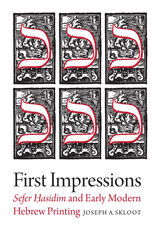 First Impressions: Sefer Hasidim and Early Modern Hebrew Printing
Joseph A. Skloot
Brandeis University Press, 2023 Uncovers the history of creative adaptation and transformation through a close analysis of the creation of the Sefer Hasidim book.
In 1538, a partnership of Jewish silk makers in the city of Bologna published a book entitled Sefer Hasidim, a compendium of rituals, stories, and religious instruction that primarily originated in medieval Franco-Germany. How these men, of Italian and Spanish descent, came to produce a book that would come to shape Ashkenazic culture, and Jewish culture more broadly, over the next four centuries is the basis of this kaleidoscopic study of the history of Hebrew printing in the sixteenth century.
During these early years of printing, the classic works of ancient and medieval Hebrew and Jewish literature became widely available to Jewish (and non-Jewish) readers for the first time. Printing, though, was not merely the duplication and distribution of pre-existing manuscripts, it was the creative adaptation and transformation of those manuscripts by printers. Ranging from Catholic Bologna to Protestant Basel to the Jewish heartland of the Polish-Lithuanian Commonwealth, Joseph A. Skloot uncovers the history of that creativity by examining the first two print editions of Sefer Hasidim. Along the way, he demonstrates how volumes that were long thought to be eternal and unchanging were in fact artifacts of historical agency and contingency, created by and for human beings.
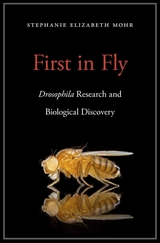 First in Fly: Drosophila Research and Biological Discovery
Stephanie Elizabeth Mohr
Harvard University Press, 2018 A single species of fly, Drosophila melanogaster, has been the subject of scientific research for more than one hundred years. Why does this tiny insect merit such intense scrutiny?
Drosophila’s importance as a research organism began with its short life cycle, ability to reproduce in large numbers, and easy-to-see mutant phenotypes. Over time, laboratory investigation revealed surprising similarities between flies and other animals at the level of genes, gene networks, cell interactions, physiology, immunity, and behavior. Like humans, flies learn and remember, fight microbial infection, and slow down as they age. Scientists use Drosophila to investigate complex biological activities in a simple but intact living system. Fly research provides answers to some of the most challenging questions in biology and biomedicine, including how cells transmit signals and form ordered structures, how we can interpret the wealth of human genome data now available, and how we can develop effective treatments for cancer, diabetes, and neurodegenerative diseases.
Written by a leader in the Drosophila research community, First in Fly celebrates key insights uncovered by investigators using this model organism. Stephanie Elizabeth Mohr draws on these “first in fly” findings to introduce fundamental biological concepts gained over the last century and explore how research in the common fruit fly has expanded our understanding of human health and disease.
 First in Violence, Deepest in Dirt: Homicide in Chicago, 1875-1920
Jeffrey S. Adler
Harvard University Press, 2006 Between 1875 and 1920, Chicago's homicide rate more than quadrupled, making it the most violent major urban center in the United States--or, in the words of Lincoln Steffens, "first in violence, deepest in dirt." In many ways, however, Chicago became more orderly as it grew. Hundreds of thousands of newcomers poured into the city, yet levels of disorder fell and rates of drunkenness, brawling, and accidental death dropped. But if Chicagoans became less volatile and less impulsive, they also became more homicidal.
Based on an analysis of nearly six thousand homicide cases, First in Violence, Deepest in Dirt examines the ways in which industrialization, immigration, poverty, ethnic and racial conflict, and powerful cultural forces reshaped city life and generated soaring levels of lethal violence. Drawing on suicide notes, deathbed declarations, courtroom testimony, and commutation petitions, Jeffrey Adler reveals the pressures fueling murders in turn-of-the-century Chicago. During this era Chicagoans confronted social and cultural pressures powerful enough to trigger surging levels of spouse killing and fatal robberies. Homicide shifted from the swaggering rituals of plebeian masculinity into family life and then into street life.
From rage killers to the "Baby Bandit Quartet," Adler offers a dramatic portrait of Chicago during a period in which the characteristic elements of modern homicide in America emerged.
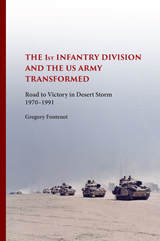 The First Infantry Division and the U.S. Army Transformed: Road to Victory in Desert Storm, 1970-1991
Gregory Fontenot
University of Missouri Press, 2017 This fast-paced and compelling read closes a significant gap in the historiography of the late Cold War U.S. Army and is crucial for understanding the current situation in the Middle East.
From the author's introduction:
“My purpose is a narrative history of the 1st Infantry Division from 1970 through the Operation Desert Storm celebration held 4th of July 1991. This story is an account of the revolutionary changes in the late Cold War. The Army that overran Saddam Hussein’s Legions in four days was the product of important changes stimulated both by social changes and institutional reform. The 1st Infantry Division reflected benefits of those changes, despite its low priority for troops and material. The Division was not an elite formation, but rather excelled in the context of the Army as an institution.”
This book begins with a preface by Gordon R. Sullivan, General, USA, Retired. In twelve chapters, author Gregory Fontenot explains the history of the 1st infantry Division from 1970 to 1991. In doing so, his fast-paced narrative includes elements to expand the knowledge of non-military readers. These elements include a glossary, a key to abbreviations, maps, nearly two dozen photographs, and thorough bibliography.
The First infantry Division and the U.S. Army Transformed: Road to Victory in Desert Storm is published with support from the First Division Museum at Cantigny.
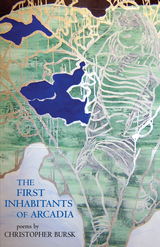 The First Inhabitants of Arcadia: Poems
Christopher Bursk
University of Arkansas Press, 2006 Herman Melville, Matthew Arnold, Sarah Orne Jewett, Dusty Rhodes, and Hoyt Wilhelm skinny-dip and pick up gondoliers and cut figure eights into the ice in Christopher Bursk’s new collection. But the main cast of characters for these poems is the alphabet itself, “the first inhabitants of Arcadia, / now homesick, curious exiles from Eden.” Here are a boy’s first investigations into the nature of language as he studies the backs of baseball cards, and a young man’s infatuation with the “F-word.” The titles sing their lettered songs: “An Ode to j,” “M-m-m Good!” and “O in Trouble.” Here are “reading lessons,” the author’s exploration of the curses and blessings of the word. It is about the fall from paradise and the gifts that fall makes possible. And over the whole book broods the great lexicographer, Samuel Johnson, that deeply troubled caretaker of the mother tongue. More than an ABC book, this collection asks questions at the very heart of how we understand the world and shows us the glory and silliness at the heart of human life.
The First Jesuits
John W. O'Malley
Harvard University Press, 1993 John W. O’Malley gives us the most comprehensive account ever written of the Society of Jesus in its founding years, one that heightens and transforms our understanding of the Jesuits in history and today. Following the Society from 1540 through 1565, O’Malley shows how this sense of mission evolved. He looks at everything—the Jesuits’ teaching, their preaching, their casuistry, their work with orphans and prostitutes, their attitudes toward Jews and “New Christians,” and their relationship to the Reformation. All are taken in by the sweep of O’Malley’s story as he details the Society’s manifold activities in Europe, Brazil, and India.
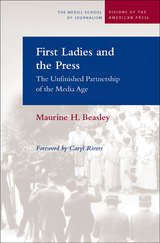 First Ladies and the Press: The Unfinished Partnership of the Media Age
Maurine H. Beasley
Northwestern University Press, 2005 At her first press conference, Eleanor Roosevelt, uncertain of her role as hostess or leader, passed a box of candied grapefruit peel to the thirty-five women journalists. Nearly sixty years later, Hillary Clinton, an accomplished professional woman and lawyer, tried to mollify her critics by handing out her chocolate-chip cookie recipe. These exchanges tells us as much about the social—and political—roles of women in America as they do about the relation of the first lady to the press and the public. Looking at the personal interaction between each first lady from Martha Washington to Laura Bush and the mass media of her day, Maurine H. Beasley traces the growth of the institution of the first lady as a part of the American political system. Her work shows how media coverage of first ladies, often limited to stereotypical ideas about women, has not adequately reflected the importance of their role.
First Lady from Plains
Rosalynn Carter
University of Arkansas Press, 1994 First Lady from Plains, first published in 1984, is Rosalynn’s Carter’s autobiography, covering her life from her childhood in Plains, Georgia, through her time as First Lady. It is “a readable, lively and revealing account of the Carters and their remarkable journey from rural Georgia to the White House in a span of ten years” (The New York Times).
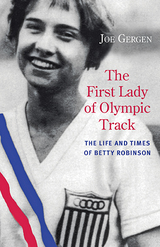 The First Lady of Olympic Track: The Life and Times of Betty Robinson
Joe Gergen
Northwestern University Press, 2014 The 1928 Olympic Games in Amsterdam were the first in which women—over the objections of many, including Pope Pius XI and the founder of the modern Olympics, Baron Pierre de Coubertin—were allowed to run in the marquee track events. Equally remarkable is the story behind the first female gold medal winner in the 100-meter dash, sixteen-year-old American Betty Robinson. A prodigy running in just her fourth organized meet, Robinson stunned the world, earning special praise from the president of the 1928 American Olympic Committee, General Douglas MacArthur. But Robinson’s triumph soon became tragedy when in 1931 she was involved in a life-threatening plane crash. Unable to assume a sprinter’s crouch, she nevertheless joined fellow pioneer Jesse Owens at the infamous 1936 Berlin Olympics, and achieved further glory on the relay team. Journalist Joe Gergen’s The First Lady of Olympic Track rescues an exceptional figure from obscurity.
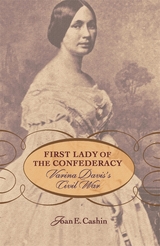 First Lady of the Confederacy: Varina Davis’s Civil War
Joan E. Cashin
Harvard University Press, 2008 When Jefferson Davis became president of the Confederacy, his wife, Varina Howell Davis, reluctantly became the First Lady. For this highly intelligent, acutely observant woman, loyalty did not come easily: she spent long years struggling to reconcile her societal duties to her personal beliefs. Raised in Mississippi but educated in Philadelphia, and a long-time resident of Washington, D.C., Mrs. Davis never felt at ease in Richmond. During the war she nursed Union prisoners and secretly corresponded with friends in the North. Though she publicly supported the South, her term as First Lady was plagued by rumors of her disaffection.
After the war, Varina Davis endured financial woes and the loss of several children, but following her husband's death in 1889, she moved to New York and began a career in journalism. Here she advocated reconciliation between the North and South and became friends with Julia Grant, the widow of Ulysses S. Grant. She shocked many by declaring in a newspaper that it was God's will that the North won the war.
A century after Varina Davis's death in 1906, Joan E. Cashin has written a masterly work, the first definitive biography of this truly modern, but deeply conflicted, woman. Pro-slavery but also pro-Union, Varina Davis was inhibited by her role as Confederate First Lady and unable to reveal her true convictions. In this pathbreaking book, Cashin offers a splendid portrait of a fascinating woman who struggled with the constraints of her time and place.
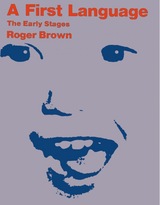 A First Language: The Early Stages
Roger Brown
Harvard University Press, 1973 For many years, Roger Brown and his colleagues have studied the developing language of pre-school children--the language that ultimately will permit them to understand themselves and the world around them. This longitudinal research project records the conversational performances of three children, studying both semantic and grammatical aspects of their language development.
These core findings are related to recent work in psychology and linguistics--and especially to studies of the acquisition of languages other than English, including Finnish, German, Korean, and Samoan. Roger Brown has written the most exhaustive and searching analysis yet undertaken of the early stages of grammatical constructions and the meanings they convey.
The five stages of linguistic development Brown establishes are measured not by chronological age-since children vary greatly in the speed at which their speech develops--but by mean length of utterance. This volume treats the first two stages.
Stage I is the threshold of syntax, when children begin to combine words to make sentences. These sentences, Brown shows, are always limited to the same small set of semantic relations: nomination, recurrence, disappearance, attribution, possession, agency, and a few others.
Stage II is concerned with the modulations of basic structural meanings--modulations for number, time, aspect, specificity--through the gradual acquisition of grammatical morphemes such as inflections, prepositions, articles, and case markers. Fourteen morphemes are studied in depth and it is shown that the order of their acquisition is almost identical across children and is predicted by their relative semantic and grammatical complexity.
It is, ultimately, the intent of this work to focus on the nature and development of knowledge: knowledge concerning grammar and the meanings coded by grammar; knowledge inferred from performance, from sentences and the settings in which they are spoken, and from signs of comprehension or incomprehension of sentences.
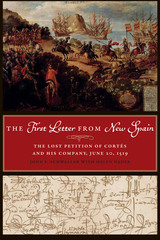 The First Letter from New Spain: The Lost Petition of Cortés and His Company, June 20, 1519
By John Schwaller and Helen Nader
University of Texas Press, 2014 The founding of la Villa Rica de la Veracruz (the rich town of the True Cross) is prominently mentioned in histories of the conquest of Mexico, but scant primary documentation of the provocative act exists. During a research session at the Spanish archives, when John Schwaller discovered an early-sixteenth-century letter from Veracruz signed by the members of Cortés’s company, he knew he had found a trove of historical details. Providing an accessible, accurate translation of this pivotal correspondence, along with in-depth examinations of its context and significance, The First Letter from New Spain gives all readers access to the first document written from the mainland of North America by any European, and the only surviving original document from the first months of the conquest. The timing of Cortés’s Good Friday landing, immediately before the initial assault on the Aztec Empire, enhances the significance of this work. Though the expedition was conducted under the authority of Diego Velázquez, governor of Cuba, the letter reflects an attempt to break ties with Velázquez and form a strategic alliance with Carlos V, the Holy Roman Emperor and King of Spain. Brimming with details about the events surrounding Veracruz’s inception and accompanied by mini-biographies of 318 signers of the document—socially competitive men who risked charges of treason by renouncing Velázquez—The First Letter from New Spain gives evidence of entrepreneurship and other overlooked traits that fueled the conquest.
 The First Liberty: America's Foundation in Religious Freedom, Expanded and Updated
William Lee Miller
Georgetown University Press, 2003 At a time when the concept of religion-based politics has taken on new and sometimes ominous tones—even within the United States—it is not only right, but also urgently necessary that William Lee Miller revisit his profound exploration of the place of religious liberty and church and state in America. For this revised edition of The First Liberty, Miller has written a pointed new introduction, discussing how religious liberty has taken on deeper dimensions in a post-9/11 world. With new material on recent Supreme Court cases involving church-state relations and a new concluding chapter on America's religious and political landscape, this volume is an eloquent and thorough interpretation of how religious faith and political freedom have blended and fused to form part of our collective history-and most importantly, how each concept must respect the boundaries of the other. Though many claim the United States to be a "Christian Nation," Miller provides a fascinatingly vivid account of the philosophical skirmishes and political machinations that led to the "wall of separation" between church and state. That famous phrase is Jefferson's, though it does not appear in the Declaration of Independence nor in the Constitution. But Miller follows this seminal idea from three great standard-bearers of religious liberty: Jefferson, Madison, and Roger Williams. Jefferson, who wrote the Virginia Statute for Religious Freedom, the precursor of the First Amendment of the Constitution; James Madison, who was politically responsible for Virginia's acceptance of religious liberty and who, a few years later, helped draft the Bill of Rights; and the even earlier figure, the radical dissenter Roger Williams, who propounded the idea of religious freedom not as a rational secularist but out of a deeply held spiritual faith. Miller re-creates the fierce and vibrant debate among the founding fathers over the means of establishing public virtue in the absence of established religion—a debate that still reverberates in today's passionate arguments about civil rights, school prayer, abortion, Christmas crèches, conscientious objection during warfare—and demonstrates how the right to hold any religious belief has dynamically shaped American political life.
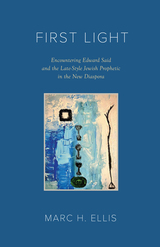 First Light: Encountering Edward Said and the Late-Style Jewish Prophetic in the New Diaspora
Marc H. Ellis
Bridwell Press, 2023 Encountering Edward Said on Yom Kippur: Reflections on the Late-Style Jewish Prophetic is a fascinating and controversial collection of journals and meditations on the plight and possibility of the prophetic witness in the modern world. In these pages, the Jewish theologian, Marc H. Ellis, explores the prophetic through his encounters with the late Palestinian intellectual, Edward Said, as a way of thinking through the stakes of contemporary Jewish history. His unexpected encounter with Said on Yom Kippur provides a fascinating window to explore the dangers and possibilities of present-day Jewish life and its future. Ellis applies Said’s idea of late-style to the Jewish prophetic – what Ellis names the Late-Style Jewish Prophetic – to mean the reappearance and coming home of the Jewish prophetic as it undergoes its own deconstruction and re-emergence. At turns deeply personal and creatively theoretical, Ellis doesn’t shy away from the forbidden terrains of self questioning and progressive posturing, even with people and movements he identifies with. The result is a sensitive and provocative exploration filled with questions and responses rather than definitive answers.
 First Light: Kanaka 'Oiwi Resistance to Settler Science at Mauna a Wakea
Iokepa Casumbal-Salazar
University of Minnesota Press, 2025 Understanding the Hawai‘i Island summit of Mauna a Wākea as a place of ancestral connection, cultural resurgence, and political resistance for Native Hawaiians
First Light is a site-specific study of Native Hawaiian resistance to the construction of the Thirty Meter Telescope (TMT) on the summit of Mauna a Wākea, the sacred mountain on the island of Hawai‘i. Drawing on personal interviews, oral histories, archival research, participant observation, and popular, legal, scientific, and Indigenous discourses, Iokepa Casumbal-Salazar explores both the campaign to build the observatory and the movement against it. He asks how astronomers have become stewards of Mauna a Wākea while Kānaka ‘Ōiwi (Aboriginal Hawaiians), in protest, are recast as obstructing progress and clinging to ancient superstitions. Contextualizing contemporary resistance to telescope expansion within the past 132 years of struggle against U.S. empire in Hawai‘i, Casumbal-Salazar argues the Kanaka-led efforts to protect their ancestral lands did not begin with the TMT and only become legible when understood in the broader history of resistance to U.S. settler hegemony as told through the voices and actions of kiaʻi ʻāina (land defenders). First Light explores how settler science, capital, and law have been mobilized in ways that rationalize industrial development projects like the TMT and promote a vision of “coexistence” that enables the dehumanization of Kānaka ‘Ōiwi and their alienation from ʻāina. Challenging the assumptions and aggressions of neoliberal environmental policy, settler multiculturalism, and U.S. military occupation, First Light reinforces calls for a moratorium on new telescope development and a literacy in Kanaka ‘Ōiwi movements for life, land, and ea (independence, sovereignty). Retail e-book files for this title are screen-reader friendly with images accompanied by short alt text and/or extended descriptions.
 The First Line
Jean-Marie Laclavetine
Seagull Books, 2025 A sharp, witty send-up of the literary world, set in the world of book publishing—a must-read for anyone who’s ever dreamt of (or dreaded) getting published. Cyril Cordouan is the beleaguered editor at Fulmen, a distinguished publishing house known for its solid but not particularly popular literary titles. Every day, Cyril faces an avalanche of subpar manuscripts, struggling to find a glimmer of quality amid the piles of drivel. Rejections are a routine part of his job, but aspiring authors don’t take kindly to their works being dismissed, and one distraught writer tragically ends his life after his manuscript is declined. Devastated, Cyril decides to create an outlet for these rejected writers. Can group therapy for the hopelessly hopeful cure Cyril’s woes? Not quite. Between vengeful widows, surprise bestsellers, and a crippling crisis of conscience, Cyril’s life is a hilarious disaster. With sharp wit and keen insight, Laclavetine, himself an industry insider, offers a satirical look at the literary world along with thought-provoking commentary on the nature of literary ambition, rejection, and the often ridiculous realities of the publishing industry.
 First Love: The Affections of Modern Fiction
Maria DiBattista
University of Chicago Press, 1991 All of us remember our First Love. In this brilliant and often passionate book, Maria DiBattista shows that the yearning for the freshness of First Love, and the sadness of that yearning, are central to modern literature. DiBattista offers a sweeping and wholly original reinterpretation of modern fiction, allowing us to see the romantic affections that lie behind the seemingly most ironic of modernist texts.
DiBattista argues that modernity reinvented First Love as a myth of creative initiative, as its characteristic response to a pervasive sense of historical belatedness. Anxious that its own creations can never be more than diminished forms of mightier originals, modernity idolizes First Love as the beginning that can never be repeated. First Love hence epitomizes the dream of a new self-incarnation. From Turgenev's First Love to the formative works of Virginia Woolf, Gertrude Stein, E. M. Forster, and Vladimir Nabokov, First Love confirms the birth of an artistic vocation. For modern men and women intent on becoming the original authors of their own lives, First Love becomes paradigmatic of those life-altering moments that transform the undifferentiated sequence of days into a fateful narrative.
DiBattista focuses on the enunciation of First Love in the fiction of Thomas Hardy, D. H. Lawrence, James Joyce, and Samuel Beckett. In reading their works, DiBattista dramatically revises the accepted view of irony as the dominant tone of modernism. First Love constitutes, she shows, a new apprehension of the world characterized not by the frigid distances of irony but by a belief in the creative individual who may begin the world anew, as if for the first time.
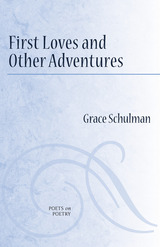 First Loves and Other Adventures
Grace Schulman
University of Michigan Press, 2009 Grace Schulman's acclaimed poetry is often about joy, the celebration of the miraculous, and the birth of beauty from adversity. In her new prose collection, she explores the passion for reading and other disciplines that led her to exult in her craft. In First Loves and Other Adventures Schulman explores how she became a writer; her wide-ranging influences; and some of the many writers and works that have enchanted her over the years, ranging from Genesis and Song of Songs in the King James Bible to T. S. Eliot to Walt Whitman. These reflections on her art and career touch on a variety of other disciplines, including science, the novel, music, and art, and their relation to poetry as a field. Her belief that art transcends formal boundaries is a recurring theme throughout her discussion of these influences, as well as in her own work. Grace Schulman is the author of six books of poems. Among her honors are the Aiken Taylor Award for poetry, the Delmore Schwartz Memorial Award, a Guggenheim Fellowship, and New York University's Distinguished Alumni Award. Her poems have won three Pushcart Prizes, and her collection Days of Wonder was selected by Library Journal as one of the best poetry books of 2002. Schulman is the former director of the Poetry Center and former poetry editor of the Nation and currently is Distinguished Professor of English at Baruch College, City University of New York. A volume in the POETS ON POETRY series, which collects critical works by contemporary poets, gathering together the articles, interviews, and book reviews by which they have articulated the poetics of a new generation.
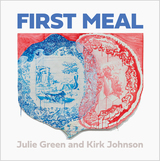 First Meal
Julie Green
Oregon State University Press, 2023 Wrongful convictions haunt the American criminal justice system, as revealed in recent years by DNA and other investigative tools. And every wrongfully convicted person who walks free, exonerated after years or decades, carries part of that story. From those facts, artist Julie Green posed a seemingly simple question: When you have been denied all choice, what do you choose to eat on the first day of freedom? In the small details of life at such pivotal moments, a vast new landscape of the world can emerge, and that is the core concept of First Meal. Partnering with the Center on Wrongful Convictions at Northwestern University’s Pritzker School of Law, Green and her coauthor, award-winning journalist Kirk Johnson, have created a unique melding of art and narration in the portraits and stories of twenty-five people on the day of their release. Food and punishment have long been intertwined. The tradition of offering a condemned person a final meal before execution, for example, has been explored by psychologists, filmmakers, and others—including Green herself in an earlier series of criminal-justice themed paintings, The Last Supper. First Meal takes on that issue from the other side: food as a symbol of autonomy in a life restored. Set against the backdrop of a flawed American legal system, First Meal describes beauty, pain, hope and redemption, all anchored around the idea—explored by writers from Marcel Proust to Michael Pollan—that food touches us deeply in memory and emotion. In Green’s art, state birds and surreal lobsters soar over places where wrongful convictions unfolded, mistaken witnesses shout their errors, glow-in-the-dark skylines evoke homecoming. Johnson’s essays take us inside those moments—from the courtrooms where things went wrong to the pathways of faith and resilience that kept people sane through their years of injustice. First Meal seeks to inform and spread awareness, but also celebrate the humanity that unites us, and the idea that gratitude and euphoria—even as it mixes with grief and the awareness of loss—can emerge in places we least expect.
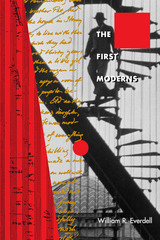 The First Moderns: Profiles in the Origins of Twentieth-Century Thought
William R. Everdell
University of Chicago Press, 1997 A lively and accessible history of Modernism, The First Moderns is filled with portraits of genius, and intellectual breakthroughs, that richly evoke the fin-de-siècle atmosphere of Paris, Vienna, St. Louis, and St. Petersburg. William Everdell offers readers an invigorating look at the unfolding of an age.
"This exceptionally wide-ranging history is chock-a-block with anecdotes, factoids, odd juxtapositions, and useful insights. Most impressive. . . . For anyone interested in learning about late 19th- and early 20th- century imaginative thought, this engagingly written book is a good place to start."—Washington Post Book World
"The First Moderns brilliantly maps the beginning of a path at whose end loom as many diasporas as there are men."—Frederic Morton, The Los Angeles Times Book Review
"In this truly exciting study of the origins of modernist thought, poet and teacher Everdell roams freely across disciplinary lines. . . . A brilliant book that will prove useful to scholars and generalists for years to come; enthusiastically recommended."—Library Journal, starred review
"Everdell has performed a rare service for his readers. Dispelling much of the current nonsense about 'postmodernism,' this book belongs on the very short list of profound works of cultural analysis."—Booklist
"Innovative and impressive . . . [Everdell] has written a marvelous, erudite, and readable study."-Mark Bevir, Spectator
"A richly eclectic history of the dawn of a new era in painting, music, literature, mathematics, physics, genetics, neuroscience, psychiatry and philosophy."—Margaret Wertheim, New Scientist
"[Everdell] has himself recombined the parts of our era's intellectual history in new and startling ways, shedding light for which the reader of The First Moderns will be eternally grateful."—Hugh Kenner, The New York Times Book Review
"Everdell shows how the idea of "modernity" arose before the First World War by telling the stories of heroes such as T. S. Eliot, Max Planck, and Georges Serault with such a lively eye for detail, irony, and ambiance that you feel as if you're reliving those miraculous years."—Jon Spayde, Utne Reader
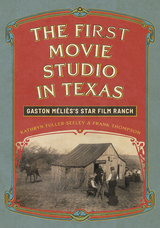 The First Movie Studio in Texas: Gaston Méliès's Star Film Ranch
Kathryn Fuller-Seeley and Frank Thompson
University of Texas Press, 2026 The story of the Star Film Ranch and its pioneering crew, who created the first “authentic” Westerns filmed in Texas. In 1910, the Méliès Star Film Company of Manhattan set up a moving-picture studio outside San Antonio, the first in Texas. Determined to make the most authentic Westerns possible, the company filmed there for a little over a year. In that brief time, it created more than seventy single-reel films, leaving a lasting mark on moviemaking. Film historians Kathryn Fuller-Seeley and Frank Thompson return to a moment when on-location filmmaking was emerging as an artform. We meet producer Gaston Méliès, older brother of early-cinema legend Georges Méliès, and his cast and crew of young innovators, old hands, and genuine cowboys—like seventeen-year-old Edith Storey, the tomboy star who helped to ignite modern celebrity culture, and Francis Ford, who learned the art of film directing on the job and mentored his younger brother, Hollywood legend John Ford. The First Movie Studio in Texas traces the company’s trials and accomplishments, its influence on the depiction of race and gender in Western filmmaking, its surviving works, and its crowning achievement: The Immortal Alamo (1911), the earliest cinematic depiction of that famous battle. Finally recovered from the shadows, the forgotten Méliès brother proves to be one of the key founders of the Western myth on screen.
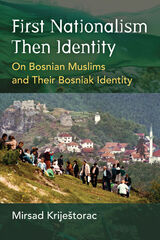 First Nationalism Then Identity: On Bosnian Muslims and Their Bosniak Identity
Mirsad Kriještorac
University of Michigan Press, 2022 First Nationalism Then Identity focuses on the case of Bosnian Muslims, a rare historic instance of a new nation emerging. Although for Bosnian Muslims the process of national emergence and the assertion of a new salient identity have been going on for over two decades, Mirsad Kriještorac is the first to explain the significance of the whole process and how the adoption of their new Bosniak identity occurred. He provides a historical overview of Yugoslav and Bosnian Slavic Muslims’ transformation into a full-fledged distinct and independent national group as well as addresses the important question in the field of nationalism studies about the relationship between and workings of nationalism and identity. While this book is noteworthy for ordinary readers interested in the case of Bosnian Muslims, it is an important contribution to the scholarly debate on the role of nationalism in the political life of a group and adds an interdisciplinary perspective to comparative politics scholarship by drawing from anthropology, history, geography, and sociology.
First Nations Gaming in Canada
Yale D. Belanger
University of Manitoba Press, 2011 While games of chance have been part of the Aboriginal cultural landscape since before European contact, large-scale commercial gaming facilities within First Nations communities are a relatively new phenomenon in Canada. First Nations Gaming in Canada is the first multidisciplinary study of the role of gaming in indigenous communities north of the 49th parallel. Bringing together some of Canada’s leading gambling researchers, the book examines the history of Aboriginal gaming and its role in indigenous political economy, the rise of large-scale casinos and cybergaming, the socio-ecological impact of problem gambling, and the challenges of labour unions and financial management. The authors also call attention to the dearth of socio-economic impact studies of gambling in First Nations communities while providing models to address this growing issue of concern.
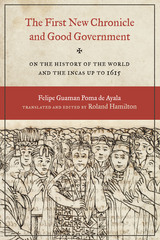 The First New Chronicle and Good Government: On the History of the World and the Incas up to 1615
By Felipe Guaman Poma de Ayala
University of Texas Press, 2009 One of the most fascinating books on pre-Columbian and early colonial Peru was written by a Peruvian Indian named Felipe Guaman Poma de Ayala. This book, The First New Chronicle and Good Government, covers pre-Inca times, various aspects of Inca culture, the Spanish conquest, and colonial times up to around 1615 when the manuscript was finished. Now housed in the Royal Library, Copenhagen, Denmark, and viewable online at www.kb.dk/permalink/2006/poma/info/en/frontpage.htm, the original manuscript has 1,189 pages accompanied by 398 full-page drawings that constitute the most accurate graphic depiction of Inca and colonial Peruvian material culture ever done. Working from the original manuscript and consulting with fellow Quechua- and Spanish-language experts, Roland Hamilton here provides the most complete and authoritative English translation of approximately the first third of The First New Chronicle and Good Government. The sections included in this volume (pages 1–369 of the manuscript) cover the history of Peru from the earliest times and the lives of each of the Inca rulers and their wives, as well as a wealth of information about ordinances, age grades, the calendar, idols, sorcerers, burials, punishments, jails, songs, palaces, roads, storage houses, and government officials. One hundred forty-six of Guaman Poma's detailed illustrations amplify the text.
 First Peoples, First Contacts: Native Peoples of North America
J. C. H. King
Harvard University Press, 1999 From the Big-Game Hunters who appeared on the continent as far back as 12,000 years ago to the Inuits plying the Alaskan waters today, the Native peoples of North America produced a culture remarkable for its vibrancy, breadth, and diversity--and for its survival in the face of almost inconceivable trials. This book is at once a history of that culture and a celebration of its splendid variety. Rich in historical testimony and anecdotes and lavishly illustrated, it weaves a magnificent tapestry of Native American life reaching back to the earliest human records.
A recognized expert in North American studies, Jonathan King interweaves his account with Native histories, from the arrival of the first Native Americans by way of what is now Alaska to their later encounters with Europeans on the continent's opposite coast, from their exchanges with fur traders to their confrontations with settlers and an ever more voracious American government. To illustrate this history, King draws on the extensive collections of the British Museum--artwork, clothing, tools, and artifacts that demonstrate the wealth of ancient traditions as well as the vitality of contemporary Native culture. These illustrations, all described in detail, form a pictorial document of relations between Europeans and Native American peoples--peoples as profoundly different and as deeply related as the Algonquians and the Iroquois, the Chumash of California and the Inuipat of Alaska, the Cree and the Cherokee--from their first contact to their complicated coexistence today.
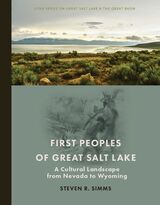 First Peoples of Great Salt Lake: A Cultural Landscape from Nevada to Wyoming
Steven R. Simms
University of Utah Press, 2023 Great Salt Lake is a celebrated, world-recognized natural landmark. It, and the broader region bound to it, is also a thoroughly cultural landscape; generations of peoples made their lives there. In an eminently readable narrative, Steven Simms, one of the foremost archaeologists of the region, traces the scope of human history dating from the Pleistocene, when First Peoples interacted with the lapping waters of Lake Bonneville, to nearly the present day. Through vivid descriptions of how people lived, migrated, and mingled, with persistence and resilience, Simms honors the long human presence on the landscape.
First Peoples of Great Salt Lake takes a different approach to understanding the ancients than is typical of archaeology. De-emphasizing categories and labels, it traces changing environments, climates, and peoples through the notion of place. It challenges the "Pristine Myth," the cultural bias that Indigenous peoples were timeless, changeless, primitive, and the landscapes they lived in sparsely populated and perpetually pristine. First Peoples and their descendants modified the forests and understory vegetation, shaped wildlife populations, and adapted to long-term climate change. Native Americans of Great Salt Lake were very much part of their world, and the story here is one of long continuity through dramatic cultural change.
 First Person Jewish
Alisa S. Lebow
University of Minnesota Press, 2008 Documentaries have increasingly used the first person, with a number of prominent filmmakers finding critical and commercial success with this intimate approach. Jewish filmmakers have particularly thrived in this genre, using it to explore disparate definitions of the self in relation to the larger groups of family and community. In First Person Jewish, Alisa S. Lebow examines more than a dozen films from Jewish artists to reveal how the postmodern impulse to turn the lens inward intersects provocatively (and at times unwittingly) with historical tropes and stereotypes of the Jew. Focusing her efforts on Jewish filmmakers working on the margins, Lebow analyzes the work of Jonathan Caouette, Chantal Akerman, and Alan Berliner, among others, also including a discussion of her own first person film Treyf (1998), made with Cynthia Madansky. The filmmakers in this study, Lebow argues, are confronting a desire to both define and reimagine contemporary Jewishness. Using a multidisciplinary approach to first person films, Lebow shows how this form of self-expression is challenging both autobiography and documentary and, in the process, changing the art of cinema and recording the cultural shifts of our time. Alisa S. Lebow is a filmmaker and lecturer in film and TV studies at Brunel University.
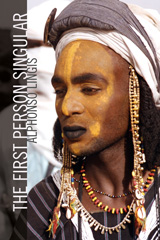 The First Person Singular
Alphonso Lingis
Northwestern University Press, 2007 Alphonso Lingis’s singular works of philosophy are not so much written as performed, and in The First Person Singular the performance is characteristically brilliant, a consummate act of philosophical reckoning. Lingis’s subject here, aptly enough, is the subject itself, understood not as consciousness but as embodied, impassioned, active being. His book is, at the same time, an elegant cultural analysis of how subjectivity is differently and collectively understood, invested, and situated.
The subject Lingis elaborates in detail is the passionate subject of fantasy, of obsessive commitment, of noble actions, the subject enacting itself through an engagement with others, including animals and natural forces. This is not the linguistic or literary subject posited by structuralism and post-structuralism, nor the rational consciousness posited by post-Enlightenment philosophy. It is rather a being embodied in both a passionate, intensifying activity and a cultural collective made up of embodied others as well as the social rituals and practices that comprise this first person singular.
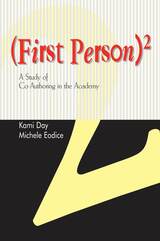 First Person Squared: A Study of Co-Authoring in the Academy
Kami Day & Michele Eodice
Utah State University Press, 2001 In (First Person)2, Day and Eodice offer one of the few book-length studies of co-authoring in academic fields since Lunsford and Ede published theirs over a decade ago. The central research here involves in-depth interviews with ten successful academic collaborators from a range of disciplines and settings. The interviews explore the narratives of these informants' experience—what brought them to collaborate, what cognitive and logistical processes were involved as they worked together, what is the status of collaborated work in their field, and so on—and situate these informants within the broader discussion of collaboration theory and research as it has been articulated over the last ten years. As the study develops, Day and Eodice become most interested in the affective domain of co-authorship, and they find the most promising explorations of that domain in the work of feminist theorists in composition.
 The First Primary: New Hampshire's Outsize Role in Presidential Nominations
David W. Moore
University of New Hampshire Press, 2015 Since 1952, the primary election in a small, not very diverse New England state has had a disproportionate impact on the U.S. presidential nomination process and the ensuing general election. Although just a handful of delegates are at stake, the New Hampshire primary has become a massive media event and a reasonably reliable predictor of a campaign’s ultimate success or failure. In The First Primary, Moore and Smith offer a comprehensive history of the state’s primary, an analysis of its media coverage and impact, and a description of the New Hampshire electorate, along with a discussion of how that electorate reflects or diverges from national opinions on candidates and issues. A book for political scientists and political junkies, media and policy professionals, and all students of American government, The First Primary ably fills the gaps in our understanding of New Hampshire’s outsize role in the nomination process.
First Principles and Ordinances
Samuel M. Brown
Neal A. Maxwell Institute for Religious Scholarship, 2014 Religion is not lived alone. A fresh focus on our relationships with God and other people can transform our understanding and experience of the Latter-day Saint gospel basics of faith, repentance, baptism, and the gift of the Holy Ghost. In First Principles and Ordinances, Samuel M. Brown begins the work of outlining a relationship-grounded theology by highlighting continuity between the gospel’s first principles and ordinances and the highest ordinances of LDS temple worship. After encountering Brown’s tapestry woven of personal stories, scripture, LDS history, and perspectives of other religious traditions, you’ll never read the Fourth Article of Faith the same way again. First Principles and Ordinances is the latest book in the Neal A. Maxwell Institute’s “Living Faith” series.
 The First Professional Revolutionist: Filippo Michele Buonarroti, 1761–1837
Elizabeth L. Eisenstein
Harvard University Press This is a relatively brief, interpretive treatment of the man whom Bakunin called “the greatest conspirator of the century” but whom most English-speaking scholars know, if at all, as an obscure, misspelled name. This is the only English biography of Buonarroti and the only book in any language to treat him as “the first professional revolutionist.” It provides a detailed historiographical analysis of recent Italian Buonarrotian research, bearing on a wide variety of different special aspects of modern European history. It throws light on the conspiratorial underground of the early nineteenth century, on the relationship between the French Revolution and nineteenth century radical movements, on the historiography of the French Revolution, and on the development of the ideology of the totalitarian Left. Perhaps the main contribution made by this study is to provide precise factual data on aspects of pre-Marxian radicalism that have been heretofore treated in a vague, overgeneralized fashion.
Buonarroti is regarded as the focal point for a preliminary investigation into the origins of an important but neglected profession which developed during the early nineteenth century. In the introduction, a distinction is drawn between the “amateur” revolutionist—the doctor, lawyer, or merchant who played a prominent role in various particular revolutions—and the frequently unemployed professional who attempted to create a situation that would make possible the practice of his craft and who had a vested interest in “revolution” in general but did not necessarily play a part in any particular revolution.
In the following chapters, the entire course of Buonarroti’s long career is surveyed chronologically, in an effort to account for the emergence of this new type of man. He is viewed as a youthful disciple of Rousseau, studying law at the University of Pisa; as a follower of Robespierre who served as a Jacobin agent in Corsica and Oneglia and was granted French citizenship by the National Convention; as a colleague of Babeuf and later author of the classic account of the Conspiracy of the Equals; as a political prisoner during the Empire who was involved in anti-Bonapartist plots; as the arch-conspirator whose agents infiltrated the revolutionary secret societies of Metternich’s Europe; as Mazzini’s rival in the Risorgimento; and finally, as the patriarch venerated by radical Frenchmen, who indoctrinated a new generation of young Parisians while directing political propaganda and agitation against the Orleanist Regime and reshaping the mythology of the French Revolution. At each of these stages of Buonarroti’s career, his ideological orientation is analyzed, his present position in historiography examined, and his actual historical contribution suggested.
The concluding chapter offers a reappraisal of the historical significance of Buonarroti’s life and work. As a secular fundamentalist who took the words of the eighteenth-century philosophers literally and as a devout Jacobin who had seen in the First Republic his “heavenly city” materialize on earth, Buonarroti was incapable of coming to terms with the post-Thermidorian world. He achieved a new career by remaining frozen in the heroic pose of 1793 while outliving his times by over four decades. Although he dedicated his life to preparing for the great day that would restore the First Republic and thus shake the world, he failed to accomplish the mission he had set himself. However, he succeeded as a prototype. Others were eventually inspired by his example to adopt a similar vocation, with fateful consequence to all of Western civilization.
The study concludes with a bibliographical essay containing a brief note on the probable role of the Italian Communist Party in stimulating Buonarrotian research in Italy and extensive critical discussion of selected scholarly literature on the various phases of Buonarroti’s career.
 The First Relationship: Infant and Mother, With a New Introduction
Daniel N. Stern
Harvard University Press, 2004 Daniel Stern's pathbreaking video-based research into the intimate complexities of mother-infant interaction has had an enormous impact on psychotherapy and developmental psychology. His minute analyses of the exchanges between mothers and babies have offered empirical support and correction for many theories of development. In the complex and instinctive choreography of "conversations," including smiles, gestures, and gazing, Stern discerned patterns of both emotional harmony and emotional incongruity that illuminate children's relationships with others in the larger world.
Now a noted authority on early development, Stern first reviewed his unique methods and observations in The First Relationship. Intended for parents as well as for therapists and researchers, it offers a lucid and nontechnical overview of the author's key ideas and encapsulates the major themes of his subsequent books.
"When I reread The First Relationship I was astonished to find in it almost all the ideas that have guided my work in the subsequent decades. At first I didn't know whether to be depressed or delighted. As I thought it over, I am encouraged by the realization that I had some basic perspective at the very beginning that was sufficiently well founded to guide twenty-five years of observation and ideas...This book makes it possible to see, or foresee, the unfolding of an intrinsic design."
--from the new introduction by Daniel Stern
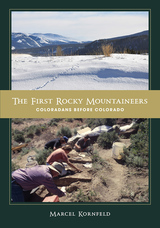 The First Rocky Mountaineers: Coloradans before Colorado
Marcel Kornfeld
University of Utah Press, 2013 Based on archaeological research in Colorado’s Middle Park—a high mountain basin initially encountered by Europeans in the early 1800s and occupied for centuries by the Ute people—The First Rocky Mountaineers is a prehistory of the earliest people of the region at the conclusion of the Ice Age. The Utes and their predecessors lived and thrived for 12,000 years in this high mountain setting, an environment that demanded unique adaptive strategies because of cold stress and hypoxic conditions. People of Middle Park coped with some of the most extreme conditions of any prehistoric population in North America, dealing with the stressors of high elevations and low temperatures by intensifying food acquisition, constructing shelters, and tailoring sophisticated warm clothing. The archaeological record of these early Coloradans, while still meager, provides a wealth of information about lifeways in the Rocky Mountain high country.
The first inhabitants of Rocky Mountain high country left a rich record of shelters, tools, and projectile points as well as food residues in the form of bison bone, all dating between 12,000 and 9,000 years ago. This record provides a robust database for interpreting their lifeways and unique adaptations. Kornfeld offers the first treatment of the original Middle Park and Rocky Mountain human populations from a biocultural perspective. This approach suggests that both biological and cultural processes frame the outcome of a successful human adaptation. While such a process may be resisted by some anthropologists investigating low-elevation groups, it is essential when trying to understand the dynamics of those living in the high country.
Chosen by Foreword as the 2014 bronze winner in science.
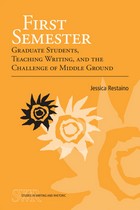 First Semester: Graduate Students, Teaching Writing, and the Challenge of Middle Ground
Jessica Restaino
Southern Illinois University Press, 2012 Jessica Restaino offers a snapshot of the first semester experiences of graduate student writing teachers as they navigate predetermined course syllabi and materials, the pressures of grading, the influences of foundational scholarship, and their own classroom authority. With rich qualitative data gathered from course observations, interviews, and correspondence, Restaino traces four graduate students’ first experiences as teachers at a large, public university. Yet the circumstances and situations she relates will ring familiar at widely varying institutions. First Semester: Graduate Students, Teaching Writing, and the Challenge of Middle Ground presents a fresh and challenging theoretical approach to understanding and improving the preparation of graduate students for the writing classroom. Restaino uses a three-part theoretical construct—labor, action, and work, as defined in Hannah Arendt’s work of political philosophy, The Human Condition—as a lens for reading graduate students’ struggles to balance their new responsibilities as teachers with their concurrent roles as students. Arendt’s concepts serve as access points for analysis, raising important questions about graduate student writing teachers’ first classrooms and uncovering opportunities for improved support and preparation by university writing programs.
 The First Social Democracy: The Democratic Republic of Georgia, 1918–1921
Stephen F. Jones
Harvard University Press The enthralling, forgotten story of how the world’s first social democracy took shape in the wake of the Russian Revolution.
Following the collapse of the Russian Empire, the small nation of Georgia established its independence in May 1918. Its leaders surprised the world by creating the first social democratic state. Based on a combination of parliamentarianism and direct democracy, it was a representative government of the peasants and workers themselves, with ballots in their hands.
The First Social Democracy is the definitive history of a government that should inspire social democrats today. Stephen F. Jones chronicles how the founders of the new state navigated myriad challenges, including territorial threats from abroad, internal ethnic conflicts, and geopolitical rivalries between the imperial Ottomans, the British, and Germans. In the midst of these existential challenges, Georgia’s social democrats set about writing a constitution to put the country on a distinctive path of genuine self-government—protecting democratic rights, promoting political pluralism, and championing equality. Jones brings to life the passionate debates that shaped Georgia’s democracy during a moment of acute global instability.
The Democratic Republic of Georgia was strangled in its crib. Just four days after the constitution was ratified, its capital fell to the Red Army. Under Soviet rule, the republic was lost to history. Soviet scholars were forbidden to research this Georgian story, and Western scholars had little interest in a small and peripheral state that was independent for only three years. Recovering a forgotten experiment in democratic citizenship and statecraft, Jones reminds us of those audacious times when Georgians created and defended political freedom against the rise of Soviet communism.
 The First Socialist Society: A History of the Soviet Union from Within, Second Enlarged Edition
Geoffrey Hosking
Harvard University Press, 1993 The First Socialist Society is the compelling and often tragic history of what Soviet citizens lived through from 1917 to 1993, told with great sympathy and perception. Tracing the evolution of the Soviet political system from its origins in 1917, Geoffrey Hosking shows how power has rarely been transmitted outside a tightly knit ruling elite and explains the forms of contact that have existed between rulers and ruled. He emphasizes the experience of the peasantry, urban workers, and professional people, showing how, more often than is commonly realized in the West, they have resisted repression and deprivation. He ranges over the character and role of religion, law, education, and literature within Soviet society; and the significance and fate of various national groups. As the story unfolds, we come to understand how the ideas of Marxism changed, taking on almost unrecognizable forms by unique political and economic circumstances.
Hosking’s analysis of this vast and complex country begins by asking how it was that the first socialist revolution took place in backward, autocratic Russia. Why were the Bolsheviks able to seize power and hold on to it? The core of the book lies in the years of Stalin’s rule: how did he exercise such unlimited power, and how did the various strata of society survive and come to terms with his tyranny? Later chapters recount Khrushchev’s efforts to reform the worst features of Stalinism and the unpredictable effects of his attempts within the East European satellite countries, bringing out elements of socialism that had been obscured or overlaid in the Soviet Union itself.
In this second enlarged edition, Hosking charts the remarkable events following the fall of the Berlin Wall in November 1989 through the formation of the Commonwealth of Independent States in December 1991, relating these momentous changes to earlier Soviet history. From changes in style in the early days of glasnost to changes in substance as the reforms under perestroika transformed the political system, Hosking shows the boldness of Gorbachev’s program as well as its ultimate result: the dissolution of the Soviet Union.
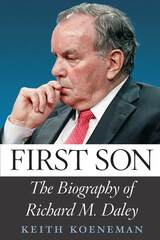 First Son: The Biography of Richard M. Daley
Keith Koeneman
University of Chicago Press, 2013 "Mayor Richard M. Daley dropped the bomb at a routine news conference at City Hall on Tuesday. With no prelude or fanfare, Mr. Daley announced that he would not seek re-election when his term expires next year. 'Simply put, it's time,' he said." New York Times, September 7, 2010 With those four words, an era ended. After twenty-two years, the longest-serving and most powerful mayor in the history of Chicago—and, arguably, America—stepped down, leaving behind a city that was utterly transformed, and a complicated legacy we are only beginning to evaluate. In First Son, Keith Koeneman chronicles the sometimes Shakespearean, sometimes Machiavellian life of an American political legend. Making deft use of unprecedented access to key players in the Daley administration, as well as Chicago's business and cultural leaders, Koeneman draws on more than one hundred interviews to tell an up-close, insider story of political triumph and personal evolution. With Koeneman as our guide, we follow young Daley from his beginnings as an average Bridgeport kid thought to lack his father's talent and charisma to his unlikely transformation into an iron-fisted leader. Daley not only escaped the giant shadow of his father but also transformed Chicago from a gritty, post-industrial Midwestern capital into a beautiful, sophisticated global city widely recognized as a model for innovative metropolises throughout the world. But in spite of his many accomplishments, Richard M. Daley's record is far from flawless. First Son sets the dramatic improvement of certain parts of the city against the persistent realities of crime, financial stress , failing public housing, and dysfunctional schools. And it reveals that while in many ways Daley broke with the machine politics of his father, he continued to reward loyalty with favors, use the resources of city government to overwhelm opponents, and tolerate political corruption. A nuanced portrait of a complex man, First Son shows Daley to be sensitive yet tough, impatient yet persistent, a street-smart fighter and detail-driven policy expert who not only ran Chicago, but was Chicago.
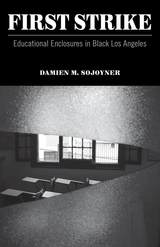 First Strike: Educational Enclosures in Black Los Angeles
Damien M. Sojoyner
University of Minnesota Press, 2016 California is a state of immense contradictions. Home to colossal wealth and long portrayed as a bastion of opportunity, it also has one of the largest prison populations in the United States and consistently ranks on the bottom of education indexes. Taking a unique, multifaceted insider’s perspective, First Strike delves into the root causes of its ever-expansive prison system and disastrous educational policy. Recentering analysis of Black masculinity beyond public rhetoric, First Strike critiques the trope of the “school-to-prison pipeline” and instead explores the realm of public school as a form of “enclosure” that has influenced the schooling (and denial of schooling) and imprisonment of Black people in California. Through a fascinating ethnography of a public school in Los Angeles County, and a “day in the life tour” of the effect of prisons on the education of Black youth, Damien M. Sojoyner looks at the contestation over education in the Black community from Reconstruction to the civil rights and Black liberation movements of the past three decades. Policy makers, school districts, and local governments have long known that there is a relationship between high incarceration rates and school failure. First Strike is the first book that demonstrates why that connection exists and shows how school districts, cities and states have been complicit and can reverse a disturbing and needless trend. Rather than rely upon state-sponsored ideological or policy-driven models that do nothing more than to maintain structures of hierarchal domination, it allows us to resituate our framework of understanding and begin looking for solutions in spaces that are readily available and are immersed in radically democratic social visions of the future.
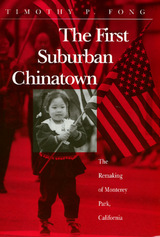 The First Suburban Chinatown: The Remaking of Monterey Park, California
Timothy P. Fong
Temple University Press, 1994 Monterey Park, California, only eight miles east of downtown Los Angeles, was dubbed by the media as the "First Suburban Chinatown." The city was a predominantly white middle-class bedroom community in the 1970s when large numbers of Chinese immigrants transformed it into a bustling international boomtown. It is now the only city in the United States with a majority Asian American population. Timothy P. Fong examines the demographic, economic, social, and cultural changes taking place there, and the political reactions to the change. Fong, a former journalist, reports on how pervasive anti-Asian sentiment fueled a series of initiatives intended to strengthen "community control," including a movement to make English the official language. Recounting the internal strife and the beginnings of recovery, Fong explores how race and ethnicity issues are used as political organizing tools and weapons. In the series Asian American History and Culture, edited by Sucheng Chan, David Palumbo-Liu, Michael Omi, K. Scott Wong, and Linda Trinh Võ.
 First Supplement to James E. Walsh’s Catalogue of the Fifteenth-Century Printed Books in the Harvard University Library
David R. Whitesell
Harvard University Press In 1994, the late James E. Walsh reported that the Harvard collection of fifteenth-century printed books, the third largest in North America, “comprises 3,517 editions in 4,187 copies.” Ten years later the count has risen to 3,627 editions in 4,389 copies. Walsh’s pioneering catalogue was published in five volumes between 1991 and 1997. This supplement describes 202 new incunabula at Harvard: 67 complete or nearly complete copies and 135 single leaves or fragments, representing a total of 173 editions, including 110 not in Walsh’s original five volumes.
The initial section of the First Supplement consists of selected additions and corrections to the Walsh catalogue. The following section, “New Entries,” details single leaves and fragments which were previously given only highly selective coverage. The supplement concludes with cumulative references, indices, and concordances. The apparatus follows the Walsh model, and the book is designed to be used both on its own and in conjunction with the five original volumes.
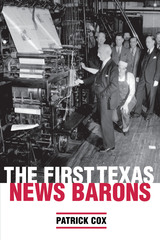 The First Texas News Barons
By Patrick Cox
University of Texas Press, 2005 Newspaper publishers played a crucial role in transforming Texas into a modern state. By promoting expanded industrialization and urbanization, as well as a more modern image of Texas as a southwestern, rather than southern, state, news barons in the early decades of the twentieth century laid the groundwork for the enormous economic growth and social changes that followed World War II. Yet their contribution to the modernization of Texas is largely unrecognized. This book investigates how newspaper owners such as A. H. Belo and George B. Dealey of the Dallas Morning News, Edwin Kiest of the Dallas Times Herald, William P. Hobby and Oveta Culp Hobby of the Houston Post, Jesse H. Jones and Marcellus Foster of the Houston Chronicle, and Amon G. Carter Sr. of the Fort Worth Star-Telegram paved the way for the modern state of Texas. Patrick Cox explores how these news barons identified the needs of the state and set out to attract the private investors and public funding that would boost the state's civic and military infrastructure, oil and gas industries, real estate market, and agricultural production. He shows how newspaper owners used events such as the Texas Centennial to promote tourism and create a uniquely Texan identity for the state. To balance the record, Cox also demonstrates that the news barons downplayed the interests of significant groups of Texans, including minorities, the poor and underemployed, union members, and a majority of women.
First the Seed: The Political Economy of Plant Biotechnology
Jack Ralph Kloppenburg, Jr.
University of Wisconsin Press, 2005 First the Seed spotlights the history of plant breeding and shows how efforts to control the seed have shaped the emergence of the agricultural biotechnology industry. This second edition of a classic work in the political economy of science includes an extensive, new chapter updating the analysis to include the most recent developments in the struggle over the direction of crop genetic engineering.
1988 Cloth, 1990 Paperback, Cambridge University Press
Winner of the Theodore Saloutos Award of the Agricultural History Society
Winner of the Robert K. Merton Award of the American Sociological Association
 First the Transition, then the Crash: Eastern Europe in the 2000s
Edited by Gareth Dale
Pluto Press, 2011 The 1989-91 upheavals in Eastern Europe sparked a turbulent process of social and economic transition. Two decades on, with the global economic crisis of 2008-10, a new phase has begun.
This book explores the scale and trajectory of the crisis through case studies of the Czech Republic, Hungary, Latvia, Poland, Russia, Ukraine and the former Yugoslavia. The contributors focus upon the relationships between geopolitics, the world economy and class restructuring.
The book covers the changing relationship between business and states; foreign capital flows; financialisation and asset price bubbles; austerity and privatisation; and societal responses, in the form of reactionary populism and progressive social movements.
Challenging neoliberal interpretations that envisage the transition as a process of unfolding liberty, the dialectic charted in these pages reveals uneven development, attenuated freedoms and social polarisation.
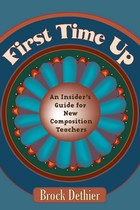 First Time Up: An Insider'S Guide For New Composition Teachers
Brock Dethier
Utah State University Press, 2005 "First time up?"—an insider’s friendly question from 1960s counter-culture—perfectly captures the spirit of this book. A short, supportive, practical guide for the first-time college composition instructor, the book is upbeat, wise but friendly, casual but knowledgeable (like the voice that may have introduced you to certain other firsts). With an experiential focus rather than a theoretical one, First Time Up will be a strong addition to the newcomer’s professional library, and a great candidate for the TA practicum reading list. Dethier, author of The Composition Instructor’s Survival Guide and From Dylan to Donne, directly addresses the common headaches, nightmares, and epiphanies of composition teaching—especially the ones that face the new teacher. And since legions of new college composition teachers are either graduate instructors (TAs) or adjuncts without a formal background in composition studies, he assumes these folks as his primary audience. Dethier’s voice is casual, but it conveys concern, humor, experience, and reassurance to the first-timer. He addresses all major areas that graduate instructors or new adjuncts in a writing program are sure to face, from career anxiety to thoughts on grading and keeping good classroom records. Dethier’s own eclecticism is well-represented here, but he reviews with considerable deftness the value of contemporary scholarship to first-time writing instructors—many of whom will be impatient with high theory. Throughout the work, he affirms a humane, confident approach to teaching, along with a true affection for college students and for teachers just learning to deal with them.
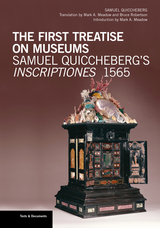 The First Treatise on Museums: Samuel Quiccheberg’s Inscriptiones, 1565
Samuel Quiccheberg
J. Paul Getty Trust, The, 2014 A new translation of a seminal sixteenth-century book on the collection and display of objects.
Samuel Quiccheberg’s Inscriptiones, first published in Latin in 1565, is an ambitious effort to demonstrate the pragmatic value of curiosity cabinets, or Wunderkammern, to princely collectors in sixteenth-century Europe and, by so doing, inspire them to develop their own such collections. Quiccheberg shows how the assembly and display of physical objects offered nobles a powerful means to expand visual knowledge, allowing them to incorporate empirical and artisanal expertise into the realm of the written word. But in mapping out the collectability of the material world, Quiccheberg did far more than create a taxonomy. Rather, he demonstrated how organizing objects made their knowledge more accessible; how objects, when juxtaposed or grouped, could tell a story; and how such strategies could enhance the value of any single object.
Quiccheberg’s descriptions of early modern collections provide both a point of origin for today’s museums and an implicit critique of their aims, asserting the fundamental research and scholarly value of collections: collections are to be used, not merely viewed. The First Treatise on Museums makes Quiccheberg’s now rare publication available in an English translation. Complementing the translation are a critical introduction by Mark A. Meadow and a preface by Bruce Robertson.
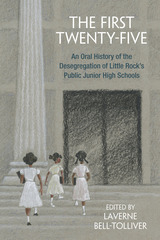 The First Twenty-Five: An Oral History of the Desegregation of Little Rock’s Public Junior High Schools
LaVerne Bell-Tolliver
University of Arkansas Press, 2018 “It was one of those periods that you got through, as opposed to enjoyed. It wasn’t an environment that . . . was nurturing, so you shut it out. You just got through it. You just took it a day at a time. You excelled if you could. You did your best. You felt as though the eyes of the community were on you.”—Glenda Wilson, East Side Junior High Much has been written about the historical desegregation of Little Rock Central High School by nine African American students in 1957. History has been silent, however, about the students who desegregated Little Rock’s five public junior high schools—East Side, Forest Heights, Pulaski Heights, Southwest, and West Side—in 1961 and 1962. The First Twenty-Five gathers the personal stories of these students some fifty years later. They recall what it was like to break down long-standing racial barriers while in their early teens—a developmental stage that often brings emotional vulnerability. In their own words, these individuals share what they saw, heard, and felt as children on the front lines of the civil rights movement, providing insight about this important time in Little Rock, and how these often painful events from their childhoods affected the rest of their lives.
The First Urban Churches 1: Methodological Foundations
James R. Harrison
SBL Press, 2015 A fresh look at early urban churches
This collection of essays examines the urban context of early Christian churches in the first-century Roman world. A city-by-city investigation of the early churches in the New Testament clarifies the challenges, threats, and opportunities that urban living provided for early Christians. Readers will come away with a better understanding of how scholars assemble an accurate picture of the cities in which the first Christians flourished.
Features:
- Analysis of urban evidence of the inscriptions, papyri, archaeological remains, coins, and iconography
- Discussion of how to use different types of evidence responsibly
- Outline of what constitutes proper methodological use for establishing a nuanced, informed portrait of ancient urban life
The First Urban Churches 2: Roman Corinth
James R. Harrison
SBL Press, 2016
Investigate the challenges, threats, and opportunities experienced by the early church
Volume two of The First Urban Churches focuses on the urban context of Christian churches in first-century Roman Corinth. An investigation of the material evidence of Corinth helps readers today understand properly the challenges, threats, and opportunities that the early Corinthian believers faced in the city. The essays demonstrate decisively the difference that such an approach makes in grappling with the meaning and context of the Corinthian epistles in the New Testament.
Features:
- Analysis of urban evidence of the inscriptions, papyri, archaeological remains, coins, and iconography
- Proposed reeconstructions of the past and its social, religious, and political significance
- A nuanced, informed portrait of ancient urban life in Corinth
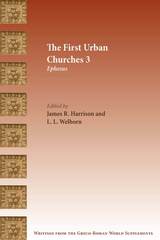 The First Urban Churches 3: Ephesus
James R. Harrison
SBL Press, 2018 Investigate the challenges, threats, and opportunities experienced by the early church in Ephesus
The third installment of The First Urban Churches focuses on the urban context of Christian churches in first-century Ephesus. As with previous volumes, contributors illustrate how an investigation of the material evidence will help readers understand properly the challenges, threats, and opportunities that the early Ephesian believers faced in that city. Brad Bitner, James R. Harrison, Michael Haxby, Fredrick J. Long, Guy M. Rogers, Michael Theophilos, Paul Trebilco, and Stephan Witetschek demonstrate decisively the difference that such an approach makes in grappling with the meaning and context of the New Testament writings, particularly Ephesians, Acts, and Revelation.
Features
- Analysis of urban evidence of the inscriptions, papyri, archaeological remains, coins, and iconography
- Proposed reconstructions of the past and its social, religious and political significance
- A nuanced, informed portrait of ancient urban life in Ephesus
The First Urban Churches 4: Roman Philippi
James R. Harrison
SBL Press, 2018 Investigate the challenges and opportunities experienced by the early church
This fourth installment of The First Urban Churches, edited by James R. Harrison and L. L. Welborn, focuses on the urban context of Christian churches in first-century Roman Philippi. The international team of New Testament and classical scholars contributing to the volume present essays that use inscriptions, papyri, archaeological remains, coins, and iconography to examine the rivalries, imperial context, and ecclesial setting of the Philippian church.
Features:
- Analysis of the material and epigraphic evidence relating to first- and second-century CE Roman Philippi
- Examination of important passages from Philippians within their ancient urban context
- Investigation of the social composition and membership of the Philippian church from the archaeological and documentary evidence
The First Urban Churches 5: Colossae, Hierapolis, and Laodicea
James R. Harrison
SBL Press, 2019 A fresh examination of early Christianity by an international team of New Testament and classical scholars
Volume 5 of The First Urban Churches investigates the urban context of Christian churches in first-century Roman Colossae, Hierapolis, and Laodicea. Building on the methodologies introduced in the first volume and supplementing the in-depth studies of Corinth, Ephesus, and Philippi (vols. 2-4), essays in this volume challenge readers to reexamine preconceived understandings of the early church and to grapple with the meaning and context of Christianity in its first-century Roman colonial context.
Features:
- Analysis of urban evidence found in inscriptions, papyri, archaeological remains, coins, and iconography
- Proposed reconstructions of the past and its social, religious, and political significance
- A nuanced, informed portrait of ancient urban life in the cities of the Lycus Valley
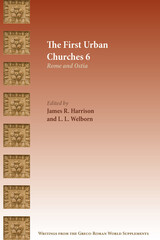 The First Urban Churches 6: Rome and Ostia
James R. Harrison
SBL Press, 2021 An examination of early Roman Christianity by New Testament and classical scholars
Building on the methodologies introduced in the first volume of The First Urban Churches and supplementing the in-depth studies of Corinth, Ephesus, Philippi, Colossae, Hierapolis, and Laodicea (vols. 2–5), essays in this volume challenge readers to reexamine what we know about the early church within Rome and the port city of Ostia. In the introductory section of the book, James R. Harrison discusses the material and documentary evidence of both cities, which sets the stage for the essays that follow. In the second section, Mary Jane Cuyler, James R. Harrison, Richard Last, Annelies Moeser, Thomas A. Robinson, Michael P. Theophilos, and L. L. Welborn examine a range of topics, including the Ostian Synagogue, Romans 1:2–4 against the backdrop of Julio-Claudian adoption and apotheosis traditions, and the epistle of 1 Clement. In the final section of this volume, Jutta Dresken-Welland and Mark Reasoner engage Peter Lampe’s magnum opus From Paul to Valentinus; Lampe wraps up the section and the volume with a response. Throughout, readers are provided with a rich demonstration of how the material evidence of the city of Rome illuminates the emergence of Roman Christianity, especially in the first century CE.
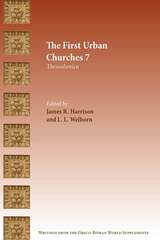 The First Urban Churches 7: Thessalonica
James R. Harrison
SBL Press, 2022 The First Urban Churches 7 includes essays focused on the development of early Christianity from the mid-first century through the sixth century CE in the ancient Macedonian city of Thessalonica. An international group of contributors traces the emergence of Thessalonica’s house churches through a close study of the archaeological remains, inscriptions, coins, iconography, and Paul’s two letters to the Thessalonians. After a detailed introduction to the city, including the first comprehensive epigraphic profile of Thessalonica from the Hellenistic age to the Roman Empire, topics discussed include the Roman emperor’s divine honors, coins and inscriptions as sources of imperial propaganda, Thessalonian family bonds, Paul’s apostolic self-image, the role of music at Thessalonica and in early Christianity, and Paul’s response to the Thessalonian Jewish community. Contributors include D. Clint Burnett, Alan H. Cadwallader, Rosemary Canavan, James R. Harrison, Julien M. Ogereau, Isaac T. Soon, Angela Standhartinger, Michael P. Theophilos, and Joel R. White.
The First Urban Churches 8: Galatia and Lycaonia
James R. Harrison
SBL Press, 2025 This eighth volume of First Urban Churches explores the literary, archaeological, documentary, numismatic, and iconographic evidence from ancient Galatia and Lycaonia. Essays focus on the northern cities of Ancyra and Pessinous and the southern cities of Pisidian Antioch and Iconium. An introduction to the province of Galatia and contributions focused on various aspects of ancient benefaction, locals mistaking Paul and Barnabas for Zeus and Hermes, Paul’s maternal metaphor for his ministry, and more shed light on the rise of early Christianity in this region. D. Clint Burnett, Alan H. Cadwallader, Susan M. (Elli) Elliott, James R. Harrison, Peter Oakes, Wesley Redgen, Michael P. Theophilos, David Wyman, and Arjan Zuiderhoek present cutting-edge research that opens new interpretive possibilities for the Letter to the Galatians.
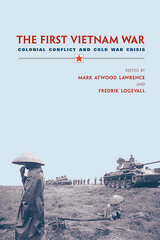 The First Vietnam War: Colonial Conflict and Cold War Crisis
Mark Atwood Lawrence
Harvard University Press, 2007 How did the conflict between Vietnamese nationalists and French colonial rulers erupt into a major Cold War struggle between communism and Western liberalism? To understand the course of the Vietnam wars, it is essential to explore the connections between events within Vietnam and global geopolitical currents in the decade after the Second World War.
In this illuminating work, leading scholars examine various dimensions of the struggle between France and Vietnamese revolutionaries that began in 1945 and reached its climax at Dien Bien Phu. Several essays break new ground in the study of the Vietnamese revolution and the establishment of the political and military apparatus that successfully challenged both France and the United States. Other essays explore the roles of China, France, Great Britain, and the United States, all of which contributed to the transformation of the conflict from a colonial skirmish to a Cold War crisis.
Taken together, the essays enable us to understand the origins of the later American war in Indochina by positioning Vietnam at the center of the grand clash between East and West and North and South in the middle years of the twentieth century.
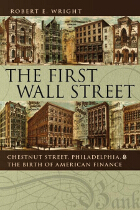 The First Wall Street: Chestnut Street, Philadelphia, and the Birth of American Finance
Robert E. Wright
University of Chicago Press, 2005 When Americans think of investment and finance, they think of Wall Street—though this was not always the case. During the dawn of the Republic, Philadelphia was the center of American finance. The first stock exchange in the nation was founded there in 1790, and around it the bustling thoroughfare known as Chestnut Street was home to the nation's most powerful financial institutions.
The First Wall Street recounts the fascinating history of Chestnut Street and its forgotten role in the birth of American finance. According to Robert E. Wright, Philadelphia, known for its cultivation of liberty and freedom, blossomed into a financial epicenter during the nation's colonial period. The continent's most prodigious minds and talented financiers flocked to Philly in droves, and by the eve of the Revolution, the Quaker City was the most financially sophisticated region in North America. The First Wall Street reveals how the city played a leading role in the financing of the American Revolution and emerged from that titanic struggle with not just the wealth it forged in the crucible of war, but an invaluable amount of human capital as well.
This capital helped make Philadelphia home to the Bank of the United States, the U.S. Mint, an active securities exchange, and several banks and insurance companies—all clustered in or around Chestnut Street. But as the decades passed, financial institutions were lured to New York, and by the late 1820s only the powerful Second Bank of the United States upheld Philadelphia's financial stature. But when Andrew Jackson vetoed its charter, he sealed the fate of Chestnut Street forever—and of Wall Street too.
Finely nuanced and elegantly written, The First Wall Street will appeal to anyone interested in the history of the United States and the origins of its unrivaled economy.
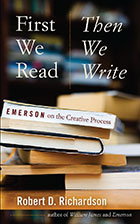 First We Read, Then We Write: Emerson on the Creative Process
Robert D. Richardson
University of Iowa Press, 2009 Writing was the central passion of Emerson’s life. While his thoughts on the craft are well developed in “The Poet,” “The American Scholar,” Nature, “Goethe,” and “Persian Poetry,” less well known are the many pages in his private journals devoted to the relationship between writing and reading. Here, for the first time, is the Concord Sage’s energetic, exuberant, and unconventional advice on the idea of writing, focused and distilled by the preeminent Emerson biographer at work today. Emerson advised that “the way to write is to throw your body at the mark when your arrows are spent.” First We Read, Then We Write contains numerous such surprises—from “every word we speak is million-faced” to “talent alone cannot make a writer”—but it is no mere collection of aphorisms and exhortations. Instead, in Robert Richardson’s hands, the biographical and historical context in which Emerson worked becomes clear.
Emerson’s advice grew from his personal experience; in practically every moment of his adult life he was either preparing to write, trying to write, or writing. Richardson shows us an Emerson who is no granite bust but instead is a fully fleshed, creative person disarmingly willing to confront his own failures. Emerson urges his readers to try anything—strategies, tricks, makeshifts—speaking not only of the nuts and bolts of writing but also of the grain and sinew of his determination. Whether a writer by trade or a novice, every reader will find something to treasure in this volume. Fearlessly wrestling with “the birthing stage of art,” Emerson’s counsel on being a reader and writer will be read and reread for years to come.
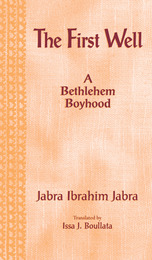 The First Well: A Bethlehem Boyhood
Jabra Ibrahim Jabra
University of Arkansas Press, 1995 The First Well is an engaging autobiographical account of Jabra’s boyhood in Bethlehem, where he was born in 1920, and later in Jerusalem, where he moved as a teenager with his parents.Through the eyes and heart of a sensitive, highly imaginative boy, Jabra describes the first sources of his artistic sensibility—the houses, fields, and orchards of his childhood and the Christian, Muslim, and Jewish cultures of Bethlehem and Jerusalem. The First Well is the story of his intellectual and spiritual growth nurtured and encouraged by his family, the Eastern Orthodox Church, and his teachers. His story is both captivatingly innocent and full of wisdom. Wordsworth’s observation, “The Child is father of the Man,” is entirely apt as Jabra’s literary and artistic interests take root and blossom. Here is a chronicle of the experiences and events he drew upon as he became one of the leading authors of the Arab world.
The First Woman in the Republic: A Cultural Biography of Lydia Maria Child
Carolyn L. Karcher
Duke University Press, 1998 For half a century Lydia Maria Child was a household name in the United States. Hardly a sphere of nineteenth-century life can be found in which Lydia Maria Child did not figure prominently as a pathbreaker. Although best known today for having edited Harriet A. Jacobs’s Incidents in the Life of a Slave Girl, she pioneered almost every department of nineteenth-century American letters—the historical novel, the short story, children’s literature, the domestic advice book, women’s history, antislavery fiction, journalism, and the literature of aging. Offering a panoramic view of a nation and culture in flux, this innovative cultural biography (originally published by Duke University Press in 1994) recreates the world as well as the life of a major nineteenth-figure whose career as a writer and social reformer encompassed issues central to American history.
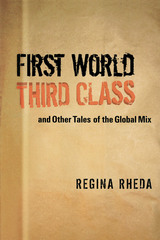 First World Third Class and Other Tales of the Global Mix
By Regina Rheda
University of Texas Press, 2005 Regina Rheda is a contemporary award-winning Brazilian writer whose original voice and style have won her many admirers. First World Third Class and Other Tales of the Global Mix presents some of her finest and most representative work to an English-speaking readership. Stories from the Copan Building consists of eight tales set in a famous residential building in São Paulo. The stories, like the apartment complex, are a microcosm of modern-day urban Brazil. They are witty, consistently caustic, and never predictable. Also in this volume is the poignant and often hilarious novel First World Third Class. It depicts young middle-class professionals and artists who, as opportunities in Brazil diminished, opted to leave their country, even if it meant taking menial jobs abroad. At the center of the narrative is Rita, a thirty-year-old aspiring filmmaker who migrates to England, and then Italy. She looks for work and love in all the wrong places, moving from city to city and from bed to bed. The last three stories in this collection also happen to be among the author's most recent. "The Enchanted Princess" is an ironic title for a postfeminist tale of a South American woman being wooed to marry an old-world gentleman who promises to take care of her every need. "The Sanctuary" concerns the living conditions of immigrant workers and farm animals. Equally piquant in nature, "The Front" deals with ecology, labor environments, and gender politics.
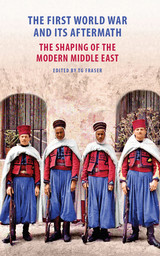 The First World War and Its Aftermath: The Shaping of the Modern Middle East
Edited by T.G. Fraser
Gingko, 2024 Gathers together leading scholars in the field to examine the impact of World War I on the Middle East, which is crucial to understanding the region’s current problems and the rise of groups like the Islamic State.
In addition to recounting the crucial international politics that drew fierce lines in the sands of the Middle East—a story of intrigue between the British, Russians, Ottomans, North Africans, Americans, and others—the contributors engage topics ranging from the war’s effects on women, the experience of the Kurds, sectarianism, the evolution of Islamism, and the importance of prominent intellectuals like Ziya Gökalp and Michel ‘Aflaq. They examine the dissolution of the Ottoman Empire, the exploitation of notions of Islamic unity and pan-Arabism, the influences of Woodrow Wilson and American ideals on Middle East leaders, and likewise the influence of Vladimir Lenin’s vision of a communist utopia. Altogether, they tell a story of promises made and promises broken, of the struggle between self-determination and international recognition, of centuries-old empires laying in ruin, and of the political poker of the twentieth century that carved up the region, separating communities into the artificial states we know today.
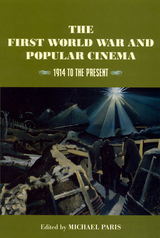 The First World War and Popular Cinema: 1914 to the Present
Paris, Michael
Rutgers University Press, 2000 The Great War played an instrumental role in the development of cinema, so necessary was it to the mobilization efforts of the combatant nations. In turn, after the war, as memory began to fade, cinema continued to shape the war's legacy and eventually to determine the ways in which all warfare is imagined. The First World War and Popular Cinema provides fresh insight into the role of film as an historical and cultural tool. Through a comparative approach, essays by contributors from Europe, Australia, Canada, and the United States enrich our understanding of cinematic depictions of the Great War in particular and combat in general. New historical research on both the uses of propaganda and the development of national cinemas make this collection one of the first to show the ways in which film history can contribute to our study of national histories. The contributors to the volume monitor popular perceptions of the war, the reshaping of the war's legacy, and the evolution of cinematic clichés that are perpetuated in filmmaking through the century. Some of the films they discuss are All Quiet on the Western Front, Gallipoli, The Grand Illusion, The Big Parade, Battle of the Somme, J'Accuse, Regeneration, and many more. The First World War and Popular Cinema is a vital addition to film studies and history, two fields only recently united in a productive way.
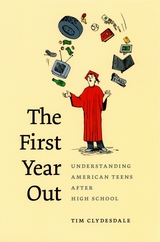 The First Year Out: Understanding American Teens after High School
Tim Clydesdale
University of Chicago Press, 2007 Wild parties, late nights, and lots of sex, drugs, and alcohol. Many assume these are the things that define an American teenager’s first year after high school. But the reality is really quite different. As Tim Clydesdale reports in The First Year Out, teenagers generally manage the increased responsibilities of everyday life immediately after graduation effectively. But, like many good things, this comes at a cost.
Tracking the daily lives of fifty young people making the transition to life after high school, Clydesdale reveals how teens settle into manageable patterns of substance use and sexual activity; how they meet the requirements of postsecondary education; and how they cope with new financial expectations. Most of them, we learn, handle the changes well because they make a priority of everyday life. But Clydesdale finds that teens also stow away their identities—religious, racial, political, or otherwise—during this period in exchange for acceptance into mainstream culture. This results in the absence of a long-range purpose for their lives and imposes limits on their desire to understand national politics and global issues, sometimes even affecting the ability to reconstruct their lives when tragedies occur.
The First Year Out is an invaluable resource for anyone caught up in the storm and stress of working with these young adults.
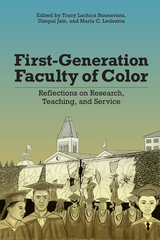 First-Generation Faculty of Color: Reflections on Research, Teaching, and Service
Tracy Lachica Buenavista
Rutgers University Press, 2023 First-Generation Faculty of Color: Reflections on Research, Teaching, and Service is the first book to examine the experiences of racially minoritized faculty who were also the first in their families to graduate college in the United States. From contingent to tenured faculty who teach at community colleges, comprehensive, and research institutions, the book is a collection of critical narratives that collectively show the diversity of faculty of color, attentive to and beyond race. The book is organized into three major parts comprised of chapters in which faculty of color depict how first-generation college student identities continue to inform how minoritized people navigate academe well into their professional careers, and encourage them to reconceptualize research, teaching, and service responsibilities to better consider the families and communities that shaped their lives well before college.
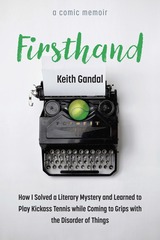 Firsthand: How I Solved a Literary Mystery and Learned to Play Kickass Tennis while Coming to Grips with the Disorder of Things
Keith Gandal
University of Michigan Press, 2024 Firsthand is an exploration—both suspenseful and comic—of the creative process in research writing. The book takes the reader through the ins and outs of a specific research journey, from combing through libraries and archives to the intellectual challenges involved with processing information that contradicts established ideas. More fundamentally, it addresses the somewhat mysterious portion of the intellectual process: the creative and serendipitous aspects involved in arriving at a fruitful research question in the first place.
Keith Gandal combines this scholarly detective story with a comic personal narrative about how a midlife crisis accidentally sent him on a journey to write a research monograph that many in his profession—including at times himself—were dubious about. While researching how Hemingway, Fitzgerald, and Faulkner faced their forgotten crises of masculinity, Gandal discovers that his own crisis is instrumental to his creative process. Incorporating stories from Gandal’s comic romp through the hyper-competitive world of middle-aged men’s tennis, adopting pitbulls, and discussing Michel Foucault, Firsthand gives readers an inside look at how to acquire accurate knowledge—about the world, about history, and about oneself.
 Firsting and Lasting: Writing Indians out of Existence in New England
Jean M. O’Brien
University of Minnesota Press, 2010 Across nineteenth-century New England, antiquarians and community leaders wrote hundreds of local histories about the founding and growth of their cities and towns. Ranging from pamphlets to multivolume treatments, these narratives shared a preoccupation with establishing the region as the cradle of an Anglo-Saxon nation and the center of a modern American culture. They also insisted, often in mournful tones, that New England’s original inhabitants, the Indians, had become extinct, even though many Indians still lived in the very towns being chronicled. In Firsting and Lasting, Jean M. O’Brien argues that local histories became a primary means by which European Americans asserted their own modernity while denying it to Indian peoples. Erasing and then memorializing Indian peoples also served a more pragmatic colonial goal: refuting Indian claims to land and rights. Drawing on more than six hundred local histories from Massachusetts, Connecticut, and Rhode Island written between 1820 and 1880, as well as censuses, monuments, and accounts of historical pageants and commemorations, O’Brien explores how these narratives inculcated the myth of Indian extinction, a myth that has stubbornly remained in the American consciousness. In order to convince themselves that the Indians had vanished despite their continued presence, O’Brien finds that local historians and their readers embraced notions of racial purity rooted in the century’s scientific racism and saw living Indians as “mixed” and therefore no longer truly Indian. Adaptation to modern life on the part of Indian peoples was used as further evidence of their demise. Indians did not—and have not—accepted this effacement, and O’Brien details how Indians have resisted their erasure through narratives of their own. These debates and the rich and surprising history uncovered in O’Brien’s work continue to have a profound influence on discourses about race and indigenous rights.
 Firsts Abroad: First-Generation Students' Journeys Outward and Upward
Jeremy Townley
Rutgers University Press Across the country, flagship universities and liberal arts colleges, regional state campuses and Ivy League institutions continue to adapt to a globalized economy. One key internationalization strategy is study abroad. But who gets to have an overseas experience? In Firsts Abroad, Jeremy Townley explores the stories of first-generation college students who participated in study abroad. Because of their multicultural, multilingual backgrounds, non-traditional paths to and through college, and hard-won life experiences, first-generation students possess knowledge, skills, and savvy developed in their families that help them take advantage of their time overseas. While abroad, these students also experience significant gains in social networks and cultural knowledge, as well as important transformations in worldview, that allow for the possibility of upward social mobility. This powerfully argued book reveals that study abroad, so important in a globalized world, may be most essential for students historically underserved by higher education.
First-Time: The Historical Vision of an African American People
Richard Price
University of Chicago Press, 2002 A classic of historical anthropology, First-Time traces the shape of historical thought among peoples who had previously been denied any history at all. The top half of each page presents a direct transcript of oral histories told by living Saramakas about their eighteenth-century ancestors, "Maroons" who had escaped slavery and settled in the rain forests of Suriname. Below these transcripts, Richard Price provides commentaries placing the Saramaka accounts into broader social, intellectual, and historical contexts.
First-Time's unique style of presentation preserves the integrity of both its oral and documentary sources, uniting them in a profound meditation on the roles of history and memory. This second edition includes a new preface by the author, discussing First-Time's impact and recounting the continuing struggles of the Saramaka people.
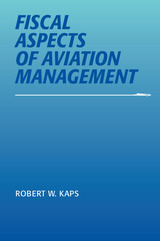 Fiscal Aspects of Aviation Management
Robert W. Kaps
Southern Illinois University Press, 2000 Although introductions to courses in finance exist for a variety of fields, Robert W. Kaps provides the first text to address the subject from an aviation viewpoint. Relying on his vast experience—twenty-plus years in the airline industry and more than thirty years in aviation—Kaps seeks not only to prepare students for careers in the aviation field but also to evoke in these students an excitement about the business. Specifically, he shows students how airlines, airports, and aviation are financed. Each chapter contains examples and illustrations and ends with suggested readings and references.
Following his discussion of financial management and accounting procedures, Kaps turns to financial management and sources of financial information. Here he discusses types of business organizations, corporate goals, business ethics, maximizing share price, and sources of financial information.
Kaps also covers debt markets, financial statements, air transport sector revenue generation, and air transport operating cost management, including cost administration and labor costs, fuel, and landing fees and rentals. He describes in depth air transport yield management systems and airport financing, including revenues, ownership, operations, revenue generation, funding, allocation of Air Improvement Program funds, bonds, and passenger facility charges.
Kaps concludes with a discussion of the preparation of a business plan, which includes advice about starting and running a business. He also provides two typical business plan outlines. While the elements of fiscal management in aviation follow generally accepted accounting principles, many nuances are germane only to the airline industry. Kaps provides a basic understanding of the principles that are applicable throughout the airline industry.
 The Fiscal Crisis of the States: Lessons for the Future
Steven D. Gold, Editor
Georgetown University Press, 1995 As the federal government has cut back its support for domestic services, state governments increasingly have been forced to assume a leadership position. In this book, prominent experts describe and analyze how state governments in the 1990s have coped with fiscal stress through changes in tax and spending policies, as well as through attempts to "reinvent government" by abandoning long-established policies. In an era when state budgets verge on the brink of deficit, state governments face the difficult task of reconciling the public's wish for low taxes with its desire for increased services—better schools, improved health systems, more prisons. This volume provides both a comparative overview of the fifty states as they try to meet conflicting needs and incisive case studies of six states with a reputation for being national leaders—California, Connecticut, Florida, Massachusetts, Michigan, and Minnesota. It explores how much substance there is to claims that states were successful in developing innovative policies. The Fiscal Crisis of the States draws upon research to analyze what is really happening in the state capitols. Boiling down the diverse experiences of various states into a number of important lessons, this book will be a valuable resource for academics, policymakers, and public administrators, as well as the general reader, to understand the reality of state fiscal policies.
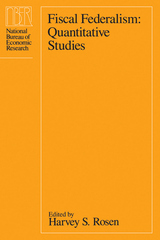 Fiscal Federalism: Quantitative Studies
Edited by Harvey S. Rosen
University of Chicago Press, 1988 We often think of fiscal decisions as being made by a single government, but in the United States the reality is that an astounding number of entities have the power to tax and spend. State, local, and federal governments all play crucial roles in the U.S. fiscal system, and the interrelation has been the source of continuing controversy. This fact is the focus of the seven papers and commentaries presented in this volume, the result of a conference sponsored by the NBER. The contributors use various quantitative tools to study policy issues, obtaining results that will interest policymakers and researchers working in the areas of taxation and public finance.
The first three papers study the distribution of power and responsibilities among the various levels of government. John Joseph Wallis and Wallace E. Oates look at the extend and evolution of decentralization in the state and local sector; Robert P. Inman examines the growth of federal grants and the structure of congressional decision making; and Jeffrey S. Zax investigates the effects of the number of government jurisdictions on aggregate local public debt and expenditures. The next three papers look at the deductibility of state and local taxes on federal tax returns. Using an econometric analysis, Douglas Holtz-Eakin and Harvey S. Rosen examine the effects of deductibility on revenue sources and level of expenditures. Lawrence B. Lindsey looks at how deductibility affects the level and type of taxation. George R. Zodrow uses a two-sector general equilibrium model to investigate revenue effects of deductibility. Finally, Charles R. Hulten and Robert M. Schwab analyze the problem of developing an accurate estimate of income for the state and local sector, finding that conventional accounting procedures have underestimated the income generated by a startling $100 billion.
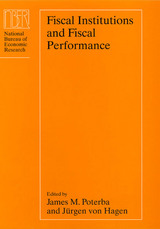 Fiscal Institutions and Fiscal Performance
Edited by James M. Poterba and Jürgen von Hagen
University of Chicago Press, 1999 The unprecedented rise and persistence of large-scale budget deficits in many developed and developing nations during the past three decades has caused great concern. The widespread presence of such deficits has proved difficult to explain. Their emergence in otherwise diverse nations defies particularistic explanations aimed at internal economic developments within a specific country.
Fiscal Institutions and Fiscal Performance shifts emphasis away from narrow economic factors to more broadly defined political and institutional factors that affect government policy and national debt. This collection brings together new theoretical models, empirical evidence, and a series of in-depth case studies to analyze the effect of political institutions, fiscal regulations, and policy decisions on accumulating deficits. It provides a fascinating overview of the political and economic issues involved and highlights the role of budgetary institutions in the formation of budget deficits.
 Fiscal Policy after the Financial Crisis
Edited by Alberto Alesina and Francesco Giavazzi
University of Chicago Press, 2013 The recent recession has brought fiscal policy back to the forefront, with economists and policy makers struggling to reach a consensus on highly political issues like tax rates and government spending. At the heart of the debate are fiscal multipliers, whose size and sensitivity determine the power of such policies to influence economic growth.
Fiscal Policy after the Financial Crisis focuses on the effects of fiscal stimuli and increased government spending, with contributions that consider the measurement of the multiplier effect and its size. In the face of uncertainty over the sustainability of recent economic policies, further contributions to this volume discuss the merits of alternate means of debt reduction through decreased government spending or increased taxes. A final section examines how the short-term political forces driving fiscal policy might be balanced with aspects of the long-term planning governing monetary policy.
A direct intervention in timely debates, Fiscal Policy after the Financial Crisis offers invaluable insights about various responses to the recent financial crisis.
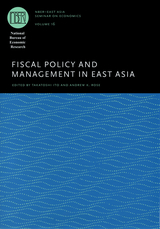 Fiscal Policy and Management in East Asia
Edited by Takatoshi Ito and Andrew K. Rose
University of Chicago Press, 2007 Managing fiscal policy—the revenues and spending of an individual nation—is among the most challenging tasks facing governments. Wealthy countries are constrained by complex regulation and taxation policies, while developing nations often face high inflation and trade taxes. In this volume, esteemed economists Takatoshi Ito and Andrew K. Rose, along with other leading experts, examine the problems and challenges facing public finance in East Asian developing countries as well as the United States and Japan.
Fiscal Policy and Management in East Asia explores the inefficient tax systems of many developing countries, the relationship between public and private sector economic behavior, and the pressing issue of future obligations that governments have undertaken to provide pensions and health care for their citizens. Featuring both overviews and analyses of the countries discussed, this book will be of value to economists and policymakers seeking to understand fiscal policy in a global context.
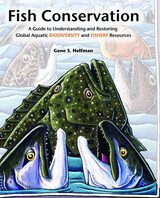 Fish Conservation: A Guide to Understanding and Restoring Global Aquatic Biodiversity and Fishery Resources
Gene S. Helfman
Island Press, 2007 Fish Conservation offers, for the first time in a single volume, a readable reference with a global approach to marine and freshwater fish diversity and fishery resource issues. Gene Helfman brings together available knowledge on the decline and restoration of freshwater and marine fishes, providing ecologically sound answers to biodiversity declines as well as to fishery management problems at the subsistence, recreational, and commercial levels. Written in an engaging and accessible style, the book:
considers the value of preserving aquatic biodiversity
offers an overview of imperiled fishes on a taxonomic and geographic basis
presents a synthesis of common characteristics of imperiled fishes and their habitats
details anthropogenic causes of decline
examines human exploitation issues
addresses ethical questions surrounding exploitation of fishes
The final chapter integrates topics and evaluates prospects for arresting declines, emphasizing the application of evolutionary and ecological principles in light of projected trends. Throughout, Helfman provides examples, explores case studies, and synthesizes available information from a broad taxonomic, habitat, and geographic range.
Fish Conservation summarizes the current state of knowledge about the degradation and restoration of diversity among fishes and the productivity of fishery resources, pointing out areas where progress has been made and where more needs to be done. Solutions focus on the application of ecological knowledge to solving practical problems, recognizing that effective biodiversity conservation depends on meeting human needs through management that focuses on long term sustainability and an ecosystem perspective.
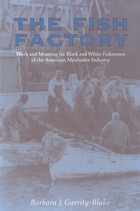 The Fish Factory: Work and Meaning for Black and White Fisherman of the American Menhaden Industry
Barbara Jean Garrity
University of Tennessee Press, 2005 Focusing on the menhaden fishermen of the southern coastal regions, The Fish Factory is an engaging and insightful exploration of what work means to different social groups employed within the same industry.
Since the nineteenth century, the menhaden industry in the South has been traditionally split between black crews and white captains. Using life histories, historical research, and anthropological fieldwork in Reedville, Virginia, and Beaufort, North Carolina, Barbara Garrity-Blake examines the relationship between these two groups and how the members of each have defined themselves in terms of their work. The author finds that for the captains and other white officers of the menhaden vessels—men “born and bred” for a life on the water—work is a key source of identity. Black crewmen, however, have insisted on a separation between work and self; they view their work primarily as a means of support rather than an end in itself.
In probing the implications of this contrast, Garrity-Blake describes captain/crew relations within both an occupational context and the context of race relations in the South. She shows how those at the bottom of the shipboard hierarchy have exercised a measure of influence in a relationship at once asymmetrical and mutually dependent. She also explores how each group has reacted to the advent of technology in their industry and, most recently, to the challenges posed by those proclaiming a conservationist ethic.
Fish for Life: Interactive Governance for Fisheries
Edited by Jan Kooiman, Svein Jentoft, Roger Pullin and Maarten Bavinck
Amsterdam University Press, 2005 One billion people around the world rely upon fish as their primary—and in many cases, their only—source of protein. At the same time, increasing demand from wealthier populations in the U.S. and Europe encourages dangerous overfishing practices along coastal waters. Fish for Life addresses the problem of overfishing at local, national, and global levels as part of a comprehensive governance approach—one that acknowledges the critical intersection of food security, environmental protection, and international law in fishing practices throughout the world.
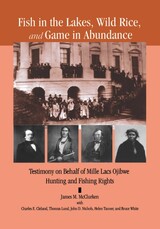 Fish in the Lakes, Wild Rice, and Game in Abundance: Testimony on Behalf of Mille Lacs Ojibwe Hunting and Fishing Rights
Edited by James M. McClurken
Michigan State University Press, 2000 On 13 August 1990 members of the Mille Lacs Band of Ojibwe filed a lawsuit against the State of Minnesota for interfering with the hunting, fishing, and gathering rights that had been guaranteed to them in an 1837 treaty with the United States. In order to interpret the treaty the courts had to consider historical circumstances, the intentions of the parties, and the treaty's implementation. The Mille Lacs Band faced a mammoth challenge. How does one argue the Native side of the case when all historical documentation was written by non- Natives? The Mille Lacs selected six scholars to testify for them. Published here for the first time, Charles Cleland, James McClurken, Helen Tanner, John Nichols, Thomas Lund, and Bruce White discuss the circumstances under which the treaty was written, the personalities involved in the negotiations and the legal rhetoric of the times, as well as analyze related legal conflicts between Natives and non- Natives. Justice Sandra Day O'Connor delivered the 1999 Opinion of the [United States Supreme] Court.
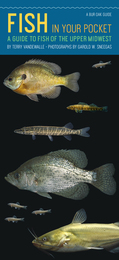 Fish in Your Pocket: A Guide to Fish of the Upper Midwest
Terry VanDeWalle
University of Iowa Press, 2017 Whether sitting in a boat with a rod and reel trying to outwit a largemouth bass or watching bluntnose minnows dart among the rocks of a sparkling stream, many people are attracted to fish. Hundreds of species can be found in the ponds, lakes, rivers, and streams of the Upper Midwest, from the beautifully colored orangethroat darter to the prehistoric-looking shovelnose sturgeon. This much-needed addition to Iowa’s popular series of laminated guides—the twenty-eighth in the series—describes twenty-nine fish species, including some of the most sought after game fish like bluegill and largemouth bass, as well as less common species like logperch and the snakelike American eel.
Terry VanDeWalle includes a thorough description of each species, and covers the Upper Midwest states of Kansas, Illinois, South Dakota, North Dakota, Iowa, Missouri, Indiana, Michigan, Minnesota, Ohio, Nebraska, and Wisconsin.
The careful descriptions and habitat and diet information in Fish inYour Pocket—enhanced with superb photographs by underwater photographer Garold Sneegas—make it extremely useful for anglers and naturalists alike.
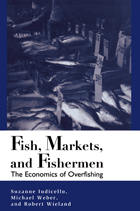 Fish, Markets, and Fishermen: The Economics Of Overfishing
Suzanne Iudicello, Michael Weber, and Robert Wieland
Island Press, 1999 A significant number of the world's ocean fisheries are depleted, and some have collapsed, from overfishing. Although many of the same fishermen who are causing these declines stand to suffer the most from them, they continue to overfish. Why is this happening? What can be done to solve the problem. The authors of Fish, Markets, and Fishermen argue that the reasons are primarily economic, and that overfishing is an inevitable consequence of the current sets of incentives facing ocean fishermen. This volume illuminates these incentives as they operate both in the aggregate and at the level of day-to-day decision-making by vessel skippers. The authors provide a primer on fish population biology and the economics of fisheries under various access regimes, and use that information in analyzing policies for managing fisheries. The book: - provides a concise statistical overview of the world's fisheries
- documents the decline of fisheries worldwide
- gives the reader a clear understanding of the economics and population biology of fish
- examines the management issues associated with regulating fisheries
- offers case studies of fisheries under different management regimes
- examines and compares the consequences of various regimes and considers the implications for policy making
The decline of the world's ocean fisheries is of enormous worldwide significance, from both economic and environmental perspectives. This book clearly explains for the nonspecialist the complicated problem of overfishing. It represents a basic resource for fishery managers and others-fishers, policymakers, conservationists, the fish consuming public, students, and researchers-concerned with the dynamics of fisheries and their sustenance.
Fish Trade in Medieval North Atlantic Societies: An Interdisciplinary Approach to Human Ecodynamics
Val Dufeu
Amsterdam University Press, 2018 Val Dufeu here reconstructs settlement patterns of fishing communities in Viking Age Iceland and proposes socio-economic and environmental models relevant to any study of the Vikings or the North Atlantic. She integrates written sources, geoarchaeological data, and zooarchaeological data to examine how fishing propelled political change in the North Atlantic. The evolution of survival fishing to internal fish markets to overseas fish trade mirrors wider social changes in the Vikings’ world.
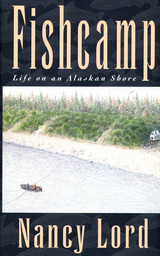 Fishcamp: Life On An Alaskan Shore
Nancy Lord
Island Press, 1997
"Summers, I live at fishcamp. June through August, Mondays and Fridays, my partner and I catch and sell salmon that pass our beach on their way to spawning streams. The rest of the week, and parts of May and September, Ken and I mend nets, comb the rocky shoreline for useful poles and cottonwood bark, do a thousand camp chores and projects. We live quite happily in a tiny cabin at the top of the beach." --from Fishcamp
For the past eighteen summers, Nancy Lord and her partner Ken have made a living, and made a life, fishing for salmon off the west side of Cook Inlet on the southern coast of Alaska. In Fishcamp, Lord provides a nuanced and engrossing portrait of their days and months in camp at the inlet.
Beginning with their arrival by plane on a freshly thawed lake, she describes their joys and tribulations as spring gives way to summer and the long months of summer unfold. With poetic cadence and magical tone, Lord draws the reader into life at camp, sharing experiences that range from the mundane to the sublime: the mending of nets; the muscle-wrenching labor of the catch; the exquisite pleasure of an improvised hot-tub; the often unnoticed bounty of the inlet's flora and fauna. Interwoven throughout the descriptions of quotidian adventure are threads of the deeper history of the region -- stories and legends of the native Dena'ina; anecdotes about past and current inlet residents; discussions of the lives of their neighbors, both human and animal, who, like them, live with fish.
Fishcamp is Nancy Lord's eloquent paean to the place she calls home. In clear and richly textured prose, she captures the simple beauty of a life lived with nature, "a part" rather than "apart." As Lord explains, she shows us in Fishcamp "something about what even one place and its infinitely varied life contributes to the connections among us all and to the wholes we call 'world' and 'culture.'...Wherever our places are and whatever we do in them, perhaps we might all begin to pay more attention to the little and big things that do indeed connect in profound ways to all the rest, miles and eons and cultures apart."
Fishcamp is a remarkable combination of personal, cultural, and natural history from what will surely be recognized as one of the most talented new voices of our time.
The Fisher King: A Novel
Anthony Powell
University of Chicago Press, 2004 Aboard the Alecto, prolific romance author Valentine Beals ruminates on the ship's most seemingly incongruous couple: a graceful, ethereal, virginal dancer named Barberina Rookwood and her lover, Saul Henchman, a crippled, emasculated war hero and photographer. Fancifully, Beals imagines Henchman to be the reembodiment of one of the most mysterious Arthurian legends, the Fisher King—the maimed and impotent ruler of a barren country of whom Perceval failed to ask the right questions. A myth with many permutations—and a blurred borderland between them—the Fisher King legend dovetails the various explanations Powell offers from his competing narrators as to why a talented young dancer would forsake her art to care for a feeble older man.
Ostensibly a novel about gossip on a cruise ship, The Fisher King is much more: a highly stylized narrative infused with Greek mythology, legend, and satire.
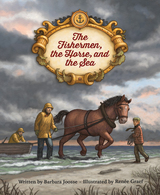 The Fishermen, the Horse, and the Sea
Barbara Joosse
Wisconsin Historical Society Press, 2021 Young Lester Smith is part of a fishing family on Lake Michigan. He loves playing on the beach with his little sister, helping Mama with chores, and watching the neighbor’s big horse pull Papa’s fishing boat onto shore. But Lester understands that the lake can be “soft as a kitten one day and terrible as a sea monster the next.” On the autumn equinox of 1895, a wicked storm rolls into Port Washington, damaging a schooner on the lake and putting the lives of its two crewmen in danger. Will Lester, his family, and the horse save the day?
This beautifully illustrated children’s book based on a true story recounts a dramatic rescue on Lake Michigan and introduces young readers to Lester Smith and his family, who founded Port Washington’s long-running and beloved Smith Bros. Fish Shanty. Educational materials including definitions, an illustrated map of Lake Michigan, and short biographies of the story’s featured characters supplement this engaging story for elementary-age readers.
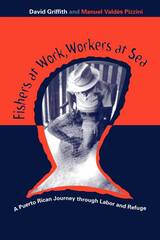 Fishers At Work, Workers At Sea: Puerto Rican Journey Thru Labor & Refuge
David Griffith and Manuel Valdés Pizzini
Temple University Press, 2002 Small-scale fishing, a house-hold based enterprise in Puerto Rico, rarely provides sufficient income for a family, but it anchors their culture and sense of themselves within that culture. Even when family members must engage in wage work to supplement house-hold income, they think of themselves as fishers. Liche typifies these wage workers: "When he was quite young, he left the island to struggle in other lands, to work, to raise a family, to send home the money he earned. Ten, twenty, thirty years passed...during which he did not once fish or even see the ocean. But in a boat-building factory in New Jersey, in a bakery in the Bronx, on the production line of a chemical factory, on dozens of construction sites, every single day he made a mental review of the waters, the isles and cays ...and entertained no thought that was not related to his return."
Fishers at Work, Workers at Sea describes Puerto Rican fishing families as they negotiate homeland and diaspora. It considers how wage work affects their livelihoods and identities at home and how these independent producers move in and out of global commodity markets. Drawing on some 100 life histories and years of fieldwork, David Griffith and Manuel Valdés Pizzini have developed a complex, often moving portrait of the men and women who fiercely struggle to hang onto the coastal landscapes and cultural heritage tied to the Caribbean Sea.
Fishes of Arkansas
Henry W. Robison
University of Arkansas Press, 2019 The second edition of Fishes of Arkansas, in development for more than a decade, is an extensive revision and expansion of the first edition, including reclassifications, taxonomic changes, and descriptions of more than thirty new species.
An invaluable reference for anyone interested in the state’s fish population—from professional ichthyologists, fisheries biologists, and managers of aquatic resources, to amateur naturalists and anglers—this new edition provides updated taxonomic keys as well as detailed descriptions, photographs, and line drawings to aid identification of the state’s 243 fish species. There is also much information on the distribution and biology of each species, including descriptions of habitat, foods eaten, reproductive biology, and conservation status.
This project and the preparation of this publication was funded in part by a grant from the Arkansas Game and Fish Commission.
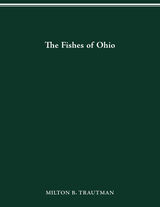 FISHES OF OHIO
Milton B. Trautman
Ohio State University Press, 1982 “In 1957, Milton B. Trautman . . . authored one of the finest regional fish books. His first edition of The Fishes of Ohio was unique in its approach by documenting historical changes in fish distribution in the face of man's encroachment and alteration of aquatic ecosystems. . . . Now, 24 years later, a revised edition of this classic work has been made available.
“The objectives of [this] edition are to demonstrate and explain distributional changes from 1750 to 1980, and to provide keys to the 166 species of Ohio fishes. These aims are admirably achieved. The natural factors influencing distribution of fishes are discussed in Part I, which relates the geology, physiography, topography, hydrology, and climatic history of the regions. . . . Part II reviews changes that have occurred from 1750 until 1980, and is an excellent chronicle of modern man's alternation and manipulation of essentially every aquatic ecosystem in Ohio. . . . Part III is a listing of species, synonomy and nomenclatorial history of Ohio’s fishes. . . . Part IV is an informative section of the systematics and nomenclature of fishes that is very useful to beginning students of ichthylogy. The glossary and family and species keys contained in Part V are excellent. Part VI contains the major content of the book, the 166 species accounts. . . .
“The updated range maps, a central focus of Trautman's approach, are excellent and obviously the result of endless efforts. Ohio is one of the most thoroughly surveyed of all states and to translate these data to visual understanding is an unenviable task for which the reader should be deeply appreciative. . . . Also of exceptional quality are the species illustrations originally rendered by Mrs. E. R. Weeks and Trautman himself for the 1957 edition. They are among the best of their kind in a fish reference work, and serve well to facilitate identification of specimens in hand. . . .
“Anyone concerned with or otherwise interested in the fishes, aquatic environments, or general natural history of Ohio or eastern North America should consider this book a valued addition to their library.”
—Ohio Journal of Science
Fishes of South Dakota
By Reeve M. Bailey and Marvin O. Allum
University of Michigan Press, 1962 This book assembles information on the fish fauna of South Dakota into a conveniently usable form. Ninety-three species are described with precise data on distribution and measurements. Additionally, this book attempts (1) to collect and identify published records of South Dakota fishes, (2) to present keys for the identification of fishes known or expected to occur in South Dakota, (3) to record original distributional data based on 137 fish collections taken throughout the state, (4) to solve some problems involving the systematic status of certain South Dakota species, (5) to clarify or extend information on the distribution of several species in the adjoining Plains area, and (6) to determine the geographic sources of origin of South Dakota fishes and to interpret routes of postglacial dispersal.
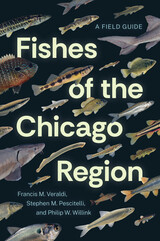 Fishes of the Chicago Region: A Field Guide
Francis M. Veraldi, Stephen M. Pescitelli, and Philip W. Willink
University of Chicago Press, 2025 “A treasure of hardcore fish intelligence and delightful tidbits of fish history.”—Dale Bowman, Chicago Sun-Times
Fish don’t heed state boundaries, and neither does this comprehensive, photo-filled guide to the diverse species of Chicago and beyond.
Encompassing southern Lake Michigan, northeastern Illinois, and adjacent areas of Indiana, Michigan, and Wisconsin, the Chicago Region is home to rare habitats supporting diverse fish populations. From small creeks to large rivers and from small ponds to one of the world’s largest freshwater ecosystems, Lake Michigan, these systems are home to some 164 fish species representing 31 families. In this essential field guide, the most complete and up-to-date reference for fishes in the Chicago Region, we meet them all—lampreys, sturgeon, paddlefish, gars, drum, darters, perches, sticklebacks, sculpins, and more. Written by leading local ecologists and featuring a pictorial family key, color photographs, detailed species distribution maps, and natural history observations unique to the region, this go-to guide belongs on the shelf—and in the boat—of every angler, naturalist, fisheries manager, and biologist.
Fishes of the Great Basin: A Natural History
John W. Sigler
University of Nevada Press, 2014 Naturalists and recreational anglers will welcome the paperback edition of this comprehensive volume, first published in 1986, which describes every species in the lakes and streams of the Great Basin. Includes an updated checklist of established species, discussion of threatened and endangered species, glossary, bibliography, and index.
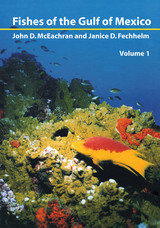 Fishes of the Gulf of Mexico, Vol. 1: Myxiniformes to Gasterosteiformes
By John McEachran and Janice D. Fechhelm
University of Texas Press, 1998 The Gulf of Mexico is the ninth largest body of water in the world and contains over 15 percent of all known species of marine fishes. This diverse fish fauna has been the subject of many publications, but, until now, no work has ever surveyed all known species, including the deep sea fishes and those of the southern Gulf. This book is the first of two volumes that will cover the entire fish fauna of the Gulf of Mexico. An introductory section that outlines the Gulf's geographical setting, geological origin, current patterns, tides, sediments, meteorology, ecology, and biological exploration is followed by a key for the forty-four orders of fishes known from the Gulf. Keys and descriptions are provided for families, which are arranged phylogenetically, and for the species, which are arranged alphabetically, described, and distinguished from similar species. All but a few species are illustrated.
Fishes of the Gulf of Mexico, Volume 2: Scorpaeniformes to Tetraodontiformes
By John D. McEachran and Janice D. Fechhelm
University of Texas Press, 2006 This book is the second of two volumes that cover the entire fish fauna of the Gulf of Mexico. It includes the orders Scorpaeniformes, Perciformes, Pleuronectiformes, and Tetraodontiformes. Keys and descriptions are provided for the families, which are arranged phylogenetically, and for the species, which are arranged alphabetically, described (including distribution and life history), and distinguished from similar species. All but a few species are illustrated. The volume also includes a biogeographical synopsis of the fishes of the Gulf of Mexico.
Fishes of the Minnesota Region
Gary L. Phillips, William D. Schmid, and James C. Underhill
University of Minnesota Press, 1982 Fishes of the Minnesota Region was first published in 1982. Minnesota Archive Editions uses digital technology to make long-unavailable books once again accessible, and are published unaltered from the original University of Minnesota Press editions. From Northern Pike to the Walleye, this is the definitive guide to all of Minnesota's 149 kinds of fishes. Illustrated with over 80 color photographs, this book will appeal to enthusiastic anglers as well as curious naturalists. Along with a guide to identification, the authors cover habitat, distribution, conservation, and even some recipes. If you catch a fish from one of Minnesota's 10,000 lakes you'll find a description of it in this book.
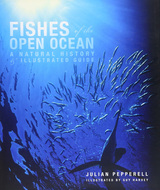 Fishes of the Open Ocean: A Natural History and Illustrated Guide
Julian Pepperell
University of Chicago Press, 2010 Between the surface of the sea and depths of two hundred meters lies a remarkable range of fish, generally known as pelagics, or open-ocean dwellers. These creatures are among the largest, fastest, highest-leaping, and most migratory fish on the entire planet. Beautifully adapted to their world, they range from tiny drift fish and plankton-straining whale sharks to more streamlined predators such as tuna, marlin, sailfish, and wahoo.
Fishes of the Open Ocean, from leading marine biologist and world authority on the subject Julian Pepperell, is the first book to comprehensively describe these fishes and explore the complex and often fragile world in which they live. In what will be the definitive book on the subject for years to come—and, with over three hundred color images, the most lavishly produced as well—Pepperell details the environment and biology of every major species of fish that inhabits the open ocean, an expanse that covers 330 million cubic miles and is the largest aquatic habitat on the Earth. The first section of the book introduces the various evolutionary forms these fish have taken, as well as the ways in which specific species interact and coevolve with others in the food web. A chapter on commercial and sport fisheries explores the human element in this realm and considers such issues as sustainability, catch-and-release initiatives, and the risks of extinction.
The second section of the book provides species accounts of open ocean dwellers organized by group, with overviews and general descriptions that are inclusive of range and distribution, unique physiological and morphological attributes, and the role of each species within its ecosystem. Global distribution maps, original illustrations from renowned artist and scientist Guy Harvey, and truly stunning images from some of the world’s leading underwater photographers round out this copiously illustrated volume.
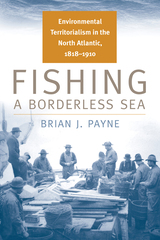 Fishing a Borderless Sea: Environmental Territorialism in the North Atlantic, 1818-1910
Brian J. Payne
Michigan State University Press, 2010 Over the centuries, processing and distribution of products from land and sea has stimulated the growth of a global economy. In the broad sweep of world history, it may be hard to imagine a place for the meager little herring baitfish. Yet, as Brian Payne adeptly recounts, the baitfish trade was hotly contested in the Anglo-American world throughout the nineteenth century. Politicians called for wars, navies were dispatched with guns at the ready, vessels were seized at sea, and violence erupted at sea.
Yet, the battle over baitfish was not simply a diplomatic or political affair. Fishermen from hundreds of villages along the coastline of Atlantic Canada and New England played essential roles in the construction of legal authority that granted or denied access to these profitable bait fisheries.
Fishing a Borderless Sea illustrates how everyday laborers created a complex system of environmental stewardship that enabled them to control the local resources while also allowing them access into the larger global economy.
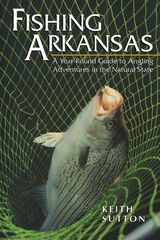 Fishing Arkansas: A Year-Round Guide to Angling Adventures in the Natural State
Keith Sutton
University of Arkansas Press, 2000 Fishing Arkansas is a comprehensive guide to the angling opportunities that the Natural State offers to its 500,000–700,000 licensed fisherman as well as to visitors to the state. In addition to conveying the very drama and excitement of the fishing experience itself, the month-by-month organiziation of the book allows the reader a detailed look at the life histories of many Arkansas sport fish, the best lakes and streams in which to find them, and the most successful tactics and tackle to use.
Enhanced by Sutton's excellent photographs, the guide includes twelve sections on popular game fish, such as largemouth and smallmouth bass, crappie, catfish, bluegill, and trout. It also provides an introduction to often-overlooked species like bowfin, gar, carp, paddlefish, and pickerel. Hundreds of valuable fishing tips gleaned from decades of on-the-water experience and interviews with dozens of guides, biologists, and expert anglers enhance the engaging narraive. From the glistening trout in the cold tailwaters of the White River, to feisty catfish on the muddy bayou bottoms of the Delta region, Keith Sutton has served up a tempting array of the fish that can be sought and caught on hook and line in the teeming waters of Arkansas.
Fishing by Obstinate Isles: Modern and Postmodern British Poetry and American Readers
Keith Tuma
Northwestern University Press, 1998 Fishing by Obstinate Isles explores the relations of recent British and American poetries, challenging American views of a British poetry dominated by antimodernism while discussing the role of rhetorics of national identity on both sides of the Atlantic in the persistence of these views. Devoting its most extensive commentary to a collection of British modernist and postmodernist poets, it attacks the relegation of British poetry to the zones of the quaint, making a compelling case for renewed engagements with fields of British poetry deserving of attention.
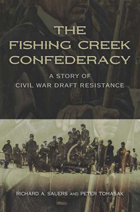 The Fishing Creek Confederacy: A Story of Civil War Draft Resistance
Richard A. Sauers and Peter Tomasak
University of Missouri Press, 2012 Media Kit
One hundred fifty years after the Civil War, Abraham Lincoln is thought of as one of the best presidents of the United States. However, most Americans forget that he was elected with only 40 percent of the popular vote. Many Democratic newspapers across the North mistrusted Lincoln’s claim that he would not abolish slavery, and the lukewarm support evidenced by them collapsed after Lincoln announced his preliminary Emancipation Proclamation in the fall of 1862. The advent of a national draft in the spring of 1863 only added fuel to the fire with anti-Lincoln Democrats arguing that it was illegal to draft civilians. Many newspaper editors advocated active resistance against the draft.
Governor Andrew Gregg Curtin of Pennsylvania was a staunch supporter of the Lincoln administration. The commonwealth supplied more than 360,000 white soldiers and 9,000 black soldiers during the conflict. However, there was sustained opposition to the war throughout the state, much of it fanned by the pens of Democratic newspaper editors. Though most opposition was disorganized and spontaneous, other aspects of the antiwar sentiment in the state occasionally erupted as major incidents.
In The Fishing Creek Confederacy, Richard A. Sauers and Peter Tomasak address the serious opposition to the draft in Columbia County, Pennsylvania, in 1864. Egged on by the anti-Lincoln newspaper editors, a number of men avoided the draft and formed ad hoc groups to protect themselves from arrest. The shooting of a Union lieutenant confronting draft evaders in July 1864 resulted in military intervention in the northern townships of the county. The troops arrested more than one hundred men, sending about half of them to a prison fort near Philadelphia. Some of these men were subjected to military trials in Harrisburg, the state capital, that fall and winter. The arrests led to bitter feelings that were slow to die. The military intervention eventually impacted a Pennsylvania gubernatorial election and led to a murder trial.
Sauers and Tomasak describe the draft in Pennsylvania and consider how Columbia County fit into the overall draft process. Subsequent chapters take the reader through the events of the summer of 1864, including the interaction of soldiers and civilians in the county, the prison experiences of the men, and the trials. Later chapters cover the August 1865 Democratic rally at Nob Mountain and the effects of the draft episode after the war was over, including its influence on the 1872 election for governor, the 1891 murder trial, and the formation of the official Democratic version of the events, which has been used by historians ever since.
The Fishing Creek Confederacy is the first book to address this episode and its aftermath in their entirety. Sauers and Tomasak present the story and try to disentangle the often contradictory nature of the sources and how both amateur and professional historians have used them.
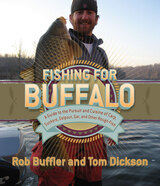 Fishing for Buffalo: A Guide to the Pursuit and Cuisine of Carp, Suckers, Eelpout, Gar, and Other Rough Fish
Rob Buffler
University of Minnesota Press, 2009 The definitive guide to the eccentric and surprisingly popular sport of rough fishing Is a carpsucker a carp or a sucker? Where can you find the largest eelpout in the United States? Can you catch creek chubs and fry them for supper? These questions and more are answered within the pages of Fishing for Buffalo. Rob Buffler and Tom Dickson dispel myths and rumors about rough fish with credible biological information while also demonstrating the joy of angling for nontraditional fish. Its wealth of information qualifies this book as a fishing bible for the growing number of rough fishing enthusiasts in the United States and makes it easy to identify the rough fish you may catch. It even includes a sampling of Dickson and Buffler’s favorite recipes, such as Burbot Boulangère and Deviled Grilled Cisco.Rough fish may be a lot of things—ugly, unruly, or elusive—but they are definitely not boring.
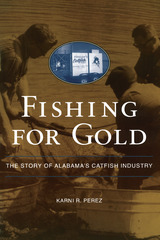 Fishing for Gold: The Story of Alabama's Catfish Industry
Karni R. Perez
University of Alabama Press, 2006 A captivating story of the industry's rise in Alabama.
With a wonderful ear for dialogue and in flowing narrative style, Karni Perez weaves together oral histories collected from early hatchery owners, catfish farmers, processors, and researchers to recount the important contributions made by Alabamians to the channel catfish industry. Perez describes the struggles and glories of fish culture from its early days as an experimental venture to the thriving present-day commercial enterprise that supplies warmwater fish for the American food industry.
As Perez states, "The catfish industry started out in Alabama as a do-it-yourself and figure-it out-yourself kind of enterprise." We hear how men who were mostly cattle farmers learned to nudge male and female fish into spawning in crudely constructed aquaria, how growers discovered the dissolved oxygen needs of their "herd" when big die-offs occurred, how Lenson Montz and Otis Breland designed the first paddle aerator to remedy the problem, how farmers eventually trained a bottomfeeding species to rise to the water surface to eat so their numbers could be better estimated. In one dramatic story, we learn how a man experimenting with the first skinning machine lost a piece of his hand in front of a crowd of horrified locals. (After it was retrieved from the skin basket, it was reattached by a town doctor and healed perfectly.) Ironically, the man was a representative of the engineering firm tasked with designing the machine; he had never before seen a catfish in his life. The machine was modified and became an essential component of modern fish processing.
In addition to telling the remarkable stories of individual contributions by farmers and researchers, Perez explains the positive effects played by improved public infrastructure, continued biological research, state legislation, and federal recognition of aquaculture as agriculture.
From Chapter Three: "You're crazy," the bank officer declared with a friendly chuckle. "Why, the Warrior River is full of catfish for anyone who wants them. There are more in there than people will ever eat. And you think you're going to go sell them when folks can go get them for nothing? That's just a bunch of dreams!" From Chapter Two: “A crop duster's error, a visit by a curious feed company researcher, a fluke of the weather, a coincidental encounter at a gas station. . . . How could the three men, or anyone else for that matter, guess that these chance circumstances would play into the birth of an industry that would mushroom over the next forty or so years into one of the largest contributors to the state's economy and that of the entire southeastern United States?”
Fishing for Growth: Export-led Development in Peru
Michael Roemer
Harvard University Press, 1970 In this first in-depth study of export-led growth in Peru, Michael Roemer demonstrates that, given the right conditions, primary product export industries can stimulate rapid and sustained economic growth in less developed countries—a possibility that has been either ignored or rejected by much development literature. Indeed, Peru's export-oriented economy succeeded in promoting diversification and industrialization, not in spite of, but because of its exports of primary products, especially fish meal. The most dramatic effect of this dynamic industry, according to the author, has been the establishment of a substantial capital-goods sector in Peru.
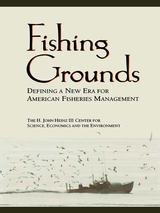 Fishing Grounds: Defining A New Era For American Fisheries Management
The H. John Heinz III Center for Science
Island Press, 2000 Fisheries management today is highly contentious. The interests of fishers and fish processors, coastal communities, the government, and environmental organizations are often different and can even be mutually incompatible. Fishing Grounds offers a comprehensive assessment of the legal, social, economic and biological context of marine fisheries management in the United States. Drawing on interviews with stakeholders from all sides of the issue, the authors seek common ground -- and points of unresolved controversy -- among the diversity of interests and viewpoints involved. Chapters examine: - history and background
- status of marine fisheries
- fishery productivity from biological, social, and economic perspectives
- ownership of fishery resources
- management structures and incentives
- the roles of science and evaluation
Each chapter begins with legal, technical, and conceptual background to help readers understand the sets of issues involved and follows that with a balanced presentation of stakeholder views. Fishing Grounds presents a useful overview of fisheries management options and positions regarding those options, providing valuable insight into the opinions and concerns of stakeholders and the sets of incentives to which those stakeholders respond. It is an important work for fisheries management professionals in industry, government agencies, and nongovernmental organizations, as well as for students and researchers involved with fisheries and fisheries management.
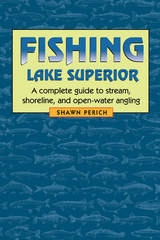 Fishing Lake Superior: A complete guide to stream, shoreline, and open-water angling
Shawn Perich
University of Minnesota Press, 2002 A complete angler’s guide to fishing Lake Superior. Experienced fisherman Shawn Perich provides proven tactics for catching steelhead, lake trout, salmon, and walleye, as well as accurate information for boaters, shorecasters, and stream anglers. Fishing Lake Superior gives clear advice about when, where, and how to hook the big one.
Let veteran outdoorsman Shawn Perich be your personal guide to the challenge of fishing Lake Superior.
“Written by an accomplished angler, Fishing Lake Superior is an informative and entertaining reference to all aspects of Lake Superior fishing.” Mike Toth, Sports Afield
“Fabulous! A lot of good advice, even for people who have been fishing a long time.” Kevin Bovee, Lake Superior Steelhead Association
“I’ve been a steelheader for 50-odd years, and I’m surprised that a young fella knows this much about it. His information is accurate and concise.” Jim Keuten, Owner, Jim’s Bait, Duluth, Minnesota
Shawn Perich is a free-lance writer and avid angler who lives on the North Shore. His first book, The North Shore: A Four Season Guide to Minnesota’s Favorite Destination, is a carry-along guide for planning trips along Lake Superior’s magnificent North Shore.
Shawn has served as the editor of the Cook County Herald in Grand Marais and as the editor of Fins and Feathers magazine. His work has appeared in Sports Afield, Fly Rod and Reel, and Outdoor News.
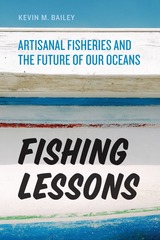 Fishing Lessons: Artisanal Fisheries and the Future of Our Oceans
Kevin M. Bailey
University of Chicago Press, 2018 Fish bones in the caves of East Timor reveal that humans have systematically fished the seas for at least 42,000 years. But in recent centuries, our ancient, vital relationship with the oceans has changed faster than the tides. As boats and fishing technology have evolved, traditional fishermen have been challenged both at sea and in the marketplace by large-scale fishing companies whose lower overhead and greater efficiency guarantee lower prices. In Fishing Lessons, Kevin M. Bailey captains a voyage through the deep history and present course of this sea change—a change that has seen species depleted, ecosystems devastated, and artisanal fisheries transformed into a global industry afloat with hundreds of billions of dollars per year.
Bailey knows these waters, the artisanal fisheries, and their relationship with larger ocean ecology intimately. In a series of place-based portraits, he shares stories of decline and success as told by those at the ends of the long lines and hand lines, channeling us through the changing dynamics of small-scale fisheries and the sustainability issues they face—both fiscal and ecological. We encounter Paolo Vespoli and his tiny boat, the Giovanni Padre,in the Gulf of Naples; Wenche, a sea Sámi, one of the indigenous fisherwomen of Norway; and many more. From salmon to abalone, the Bay of Fundy to Monterey and the Amazon, Bailey’s catch is no fish tale. It is a global story, casting a net across waters as vast and distinct as Puget Sound and the Chilean coast. Sailing across the world, Bailey explores the fast-shifting current of how we gather food from the sea, what we gain and what we lose with these shifts, and potential solutions for the murky passage ahead.
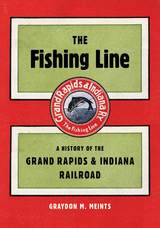 The Fishing Line: A History of the Grand Rapids & Indiana Railroad
Graydon M. Meints
Michigan State University Press, 2018 With roots in Fort Wayne, Indiana, the Grand Rapids & Indiana Railroad—nicknamed “The Fishing Line” for its connections to attractive Michigan tourist areas—was organized in the mid–nineteenth century to take advantage of the lucrative logging business of the vast forests of the northern Lower Peninsula of Michigan and other potential freight traffic. Once built into northern Michigan, it had an important role in developing the region’s tourist industry. Financed and built by officials of the mighty Pennsylvania Railroad system, the GR&I eventually was merged into that company. Using a plethora of newspapers, public documents, and other primary source materials, Meints has crafted an engaging narrative that is easily accessible to the lay reader as well as specialists in railroad and local history. Tracing a thorough corporate history of a fascinating but little-known regional line from its beginning through the early twentieth century, The Fishing Line: A History of the Grand Rapids & Indiana Railroad is a must-read.
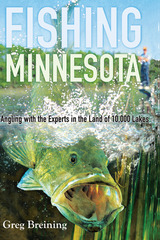 Fishing Minnesota: Angling with the Experts in the Land of 10,000 Lakes
Greg Breining
University of Minnesota Press, 2003 An insider’s look at the skills and thrills of fishing Fishing is more than catching fish. It is travel, nature, adventure, friendships, and discovery. In Fishing Minnesota, Greg Breining tags along with expert anglers and reports what they have spent years learning. He fishes for Lake Superior steelhead with Shawn Perich, small-stream smallmouth bass with Tim Holschlag, stream trout with Jay Bunke, and north-country muskies with Mark Windels. Along the way, Breining comes to understand not only how they catch fish, but why they go to the trouble. Nowhere else will you find a comprehensive how-to guide for fishing Minnesota’s many lakes and streams, full of tips from the region’s best tournament anglers, most experienced fisheries biologists, and never-fail professional guides. Breining shares their secrets on such topics as how to snell a yarn fly, where to find the biggest muskies in any lake, and how to pick the best minnows for Mille Lacs. Breining gives us that coveted experience of being in the boat with the pros.
Fishing Southern Illinois
Art Reid
Southern Illinois University Press, 1986 “Now, let’s find out where those fish are and how to catch a few,” says Art Reid in his Preface. And that is the essence of this comprehensive guide to fishing in Southern Illinois. In the colorful language of one who has fished the waters and swapped tales over many a campfire, Reid draws upon more than 25 years of experience fishing the United States and several foreign countries. Liberally spiced with anecdotes, this book tells not only where the fish are and how to catch them but who catches them: no history of fishing in Southern Illinois would be complete without an abundance of profiles of the colorful people who for years have been dedicated anglers. The stories are fun and related with verve, the people fascinating, and the information as complete as a fisherman could find anywhere.
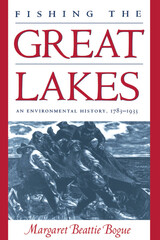 Fishing the Great Lakes: An Environmental History, 1783–1933
Margaret Beattie Bogue
University of Wisconsin Press, 2000 Fishing the Great Lakes is a sweeping history of the destruction of the once-abundant fisheries of the great "inland seas" that lie between the United States and Canada. Though lake trout, whitefish, freshwater herring, and sturgeon were still teeming as late as 1850, Margaret Bogue documents here how overfishing, pollution, political squabbling, poor public policies, and commercial exploitation combined to damage the fish populations even before the voracious sea lamprey invaded the lakes and decimated the lake trout population in the 1940s.
From the earliest records of fishing by native peoples, through the era of European exploration and settlement, to the growth and collapse of the commercial fishing industry, Fishing the Great Lakes traces the changing relationships between the fish resources and the people of the Great Lakes region. Bogue focuses in particular on the period from 1783, when Great Britain and the United States first politically severed the geographic unity of the Great Lakes, through 1933, when the commercial fishing industry had passed from its heyday in the late nineteenth century into very serious decline. She shows how fishermen, entrepreneurial fish dealers, the monopolistic A. Booth and Company (which distributed and marketed much of the Great Lakes catch), and policy makers at all levels of government played their parts in the debacle. So, too, did underfunded scientists and early conservationists unable to spark the interest of an indifferent public. Concern with the quality of lake habitat and the abundance of fish increasingly took a backseat to the interests of agriculture, lumbering, mining, commerce, manufacturing, and urban development in the Great Lakes region. Offering more than a regional history, Bogue also places the problems of Great Lakes fishing in the context of past and current worldwide fishery concerns.
 Fishing Wars and Environmental Change in Late Imperial and Modern China
Micah S. Muscolino
Harvard University Press, 2009 Among the environmental challenges facing us is alleviating the damage to marine ecosystems caused by pollution and overfishing. Coming to grips with contemporary problems, this book argues, depends on understanding how people have historically generated, perceived, and responded to environmental change. This work explores interactions between society and environment in China’s most important marine fishery, the Zhoushan Archipelago off the coast of Zhejiang and Jiangsu, from its nineteenth-century expansion to the exhaustion of the most important fish species in the 1970s.
This history of Zhoushan’s fisheries illuminates long-term environmental processes and analyzes the intersections of local, regional, and transnational ecological trends and the array of private and state interests that shaped struggles for the control of these common-pool natural resources. What institutions did private and state actors use to regulate the use of the fishery? How did relationships between social organizations and the state change over time? What types of problems could these arrangements solve and which not? What does the fate of these institutions tell us about environmental change in late imperial and modern China? Answering these questions will give us a better understanding of the relationship between past ecological changes and present environmental challenges.
Fishtastic!: A Tale of Magic and Friendship
Tess Weaver, illustrated by Jennifer Black Reinhardt
University of Iowa Press, 2021 All the trout at the Fishtastic Theater School can breathe out of water—except for Etta, the school’s costume designer. No matter how hard she tries, Etta can’t unlock her Fishtastic magic. When the theater troupe swims down the Iowa River to perform at Iowa City’s Hancher Auditorium, Etta discovers something very important that they’ve left behind. Can Etta save the show even though she’s not magical?
Inspired by the fish sculptures installed along the walkways welcoming visitors to Hancher, Fishtastic! is a delightful blend of lovable characters and whimsical watercolor illustrations that celebrate the joy of discovering your own path to enchantment.
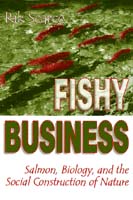 Fishy Business
Rik Scarce
Temple University Press, 2000 Leaping waterfalls, struggling through rocky shallows, only the strongest salmon survive to spawn a new generation. These remarkable fish seem to be pure nature, unfathomable, all instinct. But are they? For more than a century biologists have tried to unlock the mystery of salmon we know. For sociologist Rik Scarce, salmon represent an opportunity to probe the relationship of science, society, and nature.
About Pacific salmon -- a game fish and food source that is protected and manages for economic and environmental abundance -- Scarce writes, "What other living thing receives such extensive attention from science and society, is used in so many ways, yet retains so much of what we would like to think is its 'wild' character?" He shows how political, bureaucratic, and economic forces have directed salmon science for their own purposes and how control remains a central feature in salmon biology.
Identifying a countertrend rooted in environmental activism, Scarce also argues that an ecocentric perspective is gaining ground even as pressures mount simultaneously to save endangered salmon populations and to bring every last salmon to market. Thus, while external forces control much of the biologists' work, a movement is underway to free biology from political and economic pressures. In rich, ethnographic detail, Scarce develops this portrait of a science struggling with nature and itself. The old-line "fisheries biologists" tell how they work under immense pressure to unravel the unknowns of salmon existence to fulfill objectives of politically-motivated funding agencies. In contrast, the new breed of "conservation biology" researchers struggles to maintain the genetic diversity of salmon populations while minimizing the ways humans determine the fate of the salmon.
Fishy Business provides new ways for regarding about human interactions with other species, from appealing ones like wolves, whales, and redwood tress to less popular ones like snail darters and kangaroo rats. Society struggles to decide what parts of nature matter and why. Ultimately, Scarce argues, nature is a social product: what shall we make of it?
Fission
Helga Konigsdorf
Northwestern University Press, 2000 Under the influence of the medication crucial to her existence, the narrator--like Konigsdorf herself suffering from a degenerative disease--is visited and prodded into an examination of her life by an apparition of Lise Meitner, the Jewish physicist who helped discover atomic fission but was forced to flee Germany before Kristallnacht. Reflecting on her roles as lover, wife, mother, and woman, the narrator asks: How much have I done? Enough? What is left in the end? What will last?
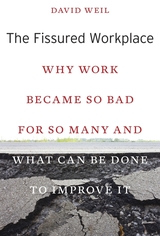 The Fissured Workplace: Why Work Became So Bad for So Many and What Can Be Done to Improve It
David Weil
Harvard University Press, 2014 For much of the twentieth century, large companies employing many workers formed the bedrock of the U.S. economy. Today, as David Weil’s groundbreaking analysis shows, large corporations have shed their role as direct employers of the people responsible for their products, in favor of outsourcing work to small companies that compete fiercely with one another. The result has been declining wages, eroding benefits, inadequate health and safety conditions, and ever-widening income inequality.
“Authoritative…[The Fissured Workplace] shed[s] important new light on the resurgence of the power of finance and its connection to the debasement of work and income distribution.”
—Robert Kuttner, New York Review of Books
“The kinds of workplace fissuring discussed here—subcontracting, franchising, and global supply chains—have been the subjects of a number of studies detailing the employment effects that Weil describes. The Fissured Workplace is unusual in bringing this research together into an integrated, detailed, and decidedly policy-oriented analysis…It makes a convincing case that the better regulation of fissured workplaces is a first step towards reversing the erosion of pay and conditions at the bottom of the labor market.”
—Virginia Doellgast, Times Higher Education
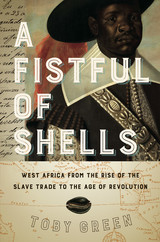 A Fistful of Shells: West Africa from the Rise of the Slave Trade to the Age of Revolution
Toby Green
University of Chicago Press, 2019 By the time the “Scramble for Africa” among European colonial powers began in the late nineteenth century, Africa had already been globally connected for centuries. Its gold had fueled the economies of Europe and the Islamic world for nearly a millennium, and the sophisticated kingdoms spanning its west coast had traded with Europeans since the fifteenth century. Until at least 1650, this was a trade of equals, using a variety of currencies—most importantly, cowrie shells imported from the Maldives and nzimbu shells imported from Brazil. But, as the slave trade grew, African kingdoms began to lose prominence in the growing global economy. We have been living with the effects of this shift ever since.
With A Fistful of Shells, Toby Green transforms our view of West and West-Central Africa by reconstructing the world of these kingdoms, which revolved around trade, diplomacy, complex religious beliefs, and the production of art. Green shows how the slave trade led to economic disparities that caused African kingdoms to lose relative political and economic power. The concentration of money in the hands of Atlantic elites in and outside these kingdoms brought about a revolutionary nineteenth century in Africa, parallel to the upheavals then taking place in Europe and America. Yet political fragmentation following the fall of African aristocracies produced radically different results as European colonization took hold.
Drawing not just on written histories, but on archival research in nine countries, art, oral history, archaeology, and letters, Green lays bare the transformations that have shaped world politics and the global economy since the fifteenth century and paints a new and masterful portrait of West Africa, past and present.
Fistula Politics: Birthing Injuries and the Quest for Continence in Niger
Heller, Alison
Rutgers University Press, 2019 Obstetric fistula is a birthing injury caused by prolonged obstructed labor that results in urinary and fecal incontinence. It is nearly non-existent in the Global North. In contrast Niger, in West Africa, has one of the highest rates of fistula in the world. In Western humanitarian and media narratives, fistula is presented as deeply stigmatizing, resulting in divorce, abandonment by kin, exile from communities, depression and suicide. In Fistula Politics, Alison Heller illustrates the inaccuracy of these popular narratives and shows how they serve the interests not of the women so affected, but of humanitarian organizations, the media, and local clinics.
 Fit Nation: The Gains and Pains of America's Exercise Obsession
Natalia Mehlman Petrzela
University of Chicago Press, 2022 How is it that Americans are more obsessed with exercise than ever, and yet also unhealthier? Fit Nation explains how we got here and imagines how we might create a more inclusive, stronger future.
If a shared American creed still exists, it’s a belief that exercise is integral to a life well lived. A century ago, working out was the activity of a strange subculture, but today, it’s almost impossible to avoid exhortations to exercise: Walk 5K to cure cancer! Awaken your inner sex kitten at pole-dancing class! Sweat like (or even with) a celebrity in spin class! Exercise is everywhere.
Yet the United States is hardly a “fit nation.” Only 20 percent of Americans work out consistently, over half of gym members don’t even use the facilities they pay for, and fewer than 30 percent of high school students get an hour of exercise a day. So how did fitness become both inescapable and inaccessible?
Spanning more than a century of American history, Fit Nation answers these questions and more through original interviews, archival research, and a rich cultural narrative. As a leading political and intellectual historian and a certified fitness instructor, Natalia Mehlman Petrzela is uniquely qualified to confront the complex and far-reaching implications of how our contemporary exercise culture took shape. She explores the work of working out not just as consumers have experienced it, but as it was created by performers, physical educators, trainers, instructors, and many others.
For Petrzela, fitness is a social justice issue. She argues that the fight for a more equitable exercise culture will be won only by revolutionizing fitness culture at its core, making it truly inclusive for all bodies in a way it has never been. Examining venues from the stage of the World’s Fair and Muscle Beach to fat farms, feminist health clinics, radical and evangelical college campuses, yoga retreats, gleaming health clubs, school gymnasiums, and many more, Fit Nation is a revealing history that shows fitness to be not just a matter of physical health but of what it means to be an American.
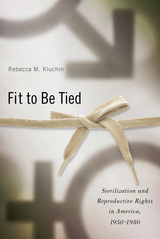 Fit to Be Tied: Sterilization and Reproductive Rights in America, 1950-1980
Kluchin, Rebecca M
Rutgers University Press, 2011 The 1960s revolutionized American contraceptive practice. Diaphragms, jellies, and condoms with high failure rates gave way to newer choices of the Pill, IUD, and sterilization. Fit to Be Tied provides a history of sterilization and what would prove to become, at once, socially divisive and a popular form of birth control. During the first half of the twentieth century, sterilization (tubal ligation and vasectomy) was a tool of eugenics. Individuals who endorsed crude notions of biological determinism sought to control the reproductive decisions of women they considered "unfit" by nature of race or class, and used surgery to do so. Incorporating first-person narratives, court cases, and official records, Rebecca M. Kluchin examines the evolution of forced sterilization of poor women, especially women of color, in the second half of the century and contrasts it with demands for contraceptive sterilization made by white women and men. She chronicles public acceptance during an era of reproductive and sexual freedom, and the subsequent replacement of the eugenics movement with "neo-eugenic" standards that continued to influence American medical practice, family planning, public policy, and popular sentiment.
 Fitness Fiesta!: Selling Latinx Culture through Zumba
Petra R. Rivera-Rideau
Duke University Press, 2024 As a fitness brand, Zumba Fitness has cultivated a devoted fan base of fifteen million participants spread across 180 countries. In Fitness Fiesta! Petra R. Rivera-Rideau analyzes how Zumba uses Latin music and dance to create and sell a vision of Latinness that’s tropical, hypersexual, and party-loving. Rivera-Rideau focuses on the five tropes that the Zumba brand uses to create this Latinness: authenticity, fiesta, fun, dreams, and love. Closely examining videos, ads, memes, and press coverage as well as interviews she conducted with instructors, Rivera-Rideau traces how Zumba Fitness constructs its ideas of Latinx culture by carefully balancing a longing for apparent authenticity with a homogenization of a marketable “south of the border”-style vacation. She shows how Zumba Fitness claims to celebrate Latinx culture and diversity while it simultaneously traffics in the same racial and ethnic stereotypes that are used to justify racist and xenophobic policies targeting Latinx communities in the United States. In so doing, Rivera-Rideau demonstrates not only the complex relationship between Latinidad and neoliberal, postracial America but also what that relationship means for the limits and possibilities of multicultural citizenship today.
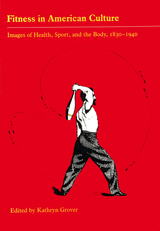 Fitness in American Culture: Images of Health, Sport, and the Body, 1830-1940
Kathryn Grover
University of Massachusetts Press, 1989 The quest for physical health and fitness has a long history in the United States. From spinach to shredded wheat to patent medicines, from calisthenics to bicycling to organized sports, Americans have searched vigorously and with great imagination for health, vitality, and physical perfection. Focusing on the period from 1830 to 1940, this collection of essays by six distinguished historians explores Americans' fascination with health and sport, a preoccupation that continues even today in the current diet and fitness craze. In his introduction, Harvey Green discusses one of the major ironies of this period: that the "progress" and achievements Americans sought in the economic and technological spheres were in fact endangering their health and weakening the entire body politic. The rapid technological changes taking place in the world forced many people to alter fundamentally their thinking about the importance of health and physical fitness not just for themselves as individuals but also for the good of society. Other topics explored include changing attitudes toward fitness and wellness, how advertising reflected health concerns, iron as a symbol of vitality and strength, the increasing specialization of foods, and the advent of organized and competitive sports.
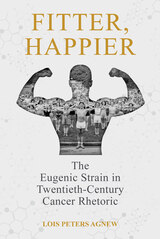 Fitter, Happier: The Eugenic Strain in Twentieth-Century Cancer Rhetoric
Lois Peters Agnew
University of Alabama Press Fitter, Happier: The Eugenic Strain in Twentieth-Century Cancer Rhetoric is a thought-provoking exploration of the relationship between cancer rhetoric, American ideals, and eugenic influences in the twentieth century. This groundbreaking work delves into the paradoxical interplay between acknowledging the genuine threat of cancer and the ingrained American ethos of confidence and control. Agnew’s meticulous research traces the topic’s historical context, unveiling how cancer discourses evolved from a hushed personal concern to a public issue thanks to the rise of cancer research centers and advocacy organizations. However, she unearths a troubling dimension to these discussions—subtle yet persistent eugenic ideologies that taint cancer arguments and advocacy groups. By dissecting prevailing cancer narratives, Agnew brings into focus how ideals rooted in eliminating imperfections and embracing progress converge with concerns for safeguarding societal fitness. Fitter, Happier scrutinizes the military origins and metaphors that permeate government policies and medical research, the transformation of cancer’s association with melancholy into a rallying cry for a positive outlook, and the nuanced implications of prevention-focused dialogues. Reflecting on the varied experiences of actual cancer patients, Agnew resists the neat assimilation of these stories into a eugenic framework. Agnew’s insights prompt readers to contemplate the societal meanings of disease and disability as well as how language constructs our shared reality.
Fitting In and Getting Happy: How Conformity to Societal Norms Affects Subjective Well-being
Olga Stavrova
Campus Verlag, 2014 Do unemployment, religiosity, or morality play a role in people’s perception of happiness and well-being? Using large-scale survey data from more than seventy countries, Olga Stavrova shows in Fitting In and Getting Happy that to a large extent happiness depends on a match between individuals’ attributes and the sociocultural characteristics of the environment in which they live. The first systematic, theory-driven investigation of cross-cultural variability in the causes and correlates of happiness, this book also provides a comprehensive overview of prior theoretical and empirical literature on happiness and life satisfaction, and suggests a number of avenues for further research in the fields of subjective well-being studies and cross-cultural comparative studies.
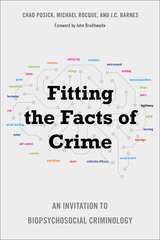 Fitting the Facts of Crime: An Invitation to Biopsychosocial Criminology
Chad Posick, Michael Rocque, and J.C. Barnes
Temple University Press, 2022 Biosocial criminology—and biosocial criminologists—focuses on both the environmental and biological factors that contribute to antisocial behavior. Importantly, these two domains are not separate parts of an equation but pieces of the same puzzle that fit together for a complete picture of the causes of crime/antisocial behavior. Fitting the Facts of Crime applies a biopsychosocial lens to the “13 facts of crime” identified by John Braithwaite in his classic book, Crime, Shame and Reintegration. The authors unpack established facts—about gender and sex, age, environment, education, class, social bonds and associations, stress, and other influences—providing both empirical research and evidence from biopsychosocial criminology to address the etiology behind these facts and exactly how they are related to deviant behavior. With their approach, the authors show how biopsychosocial criminology can be a unifying framework to enrich our understanding of the most robust and well-established topics in the field. In so doing, they demonstrate how biological and psychological findings can be responsibly combined with social theories to lend new insight into existing inquiries and solutions. Designed to become a standard text for criminology in general, Fitting the Facts of Crime introduces key concepts and applies them to real-world situations.
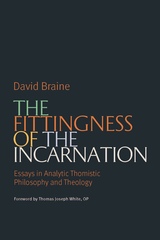 The Fittingness of the Incarnation: Essays in Analytic Thomistic Philosophy and Theology
David Braine, David
Catholic University of America Press, 2025 The Fittingness of the Incarnation collects David Braine's best unpublished philosophical and theological essays. The essays contained herein are representative of Braine's careful, rich and distinctive work. As one of the more interesting philosophers of his generation, David Braine offered a realist account of the world - God's existence, the human person, and language - through his major works, and these essays help follow through on some of those thoughts, explain underlying metaphysical or epistemological principles, and we see many of these applied in his theological essays. Additionally, the book includes Braine's plans for books on the realism of St. Thomas Aquinas, which helps us see again his vision for a unified philosophical account, and the Incarnation, which shows how Braine's philosophical anthropology informs. Altogether, the book contributes the final papers of David Braine to the fields at large.
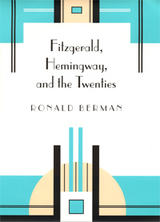 Fitzgerald, Hemingway, and the Twenties
Ronald Berman
University of Alabama Press, 2002 A noted scholar offers fresh ways of looking at two legendary American authors. Both F. Scott Fitzgerald and Ernest Hemingway came into their own in the 1920s and did some of their best writing during that decade. In a series of interrelated essays, Ronald Berman considers an array of novels and short stories by both authors within the context of the decade's popular culture, philosophy, and intellectual history. As Berman shows, the thought of Fitzgerald and Hemingway went considerably past the limits of such labels as the Jazz Age or the Lost Generation. Both Fitzgerald and Hemingway were avid readers, alive to the intellectual currents of their day, especially the contradictions and clashes of ideas and ideologies. Both writers, for example, were very much concerned with the problem of untenable belief—and also with the need to believe. In this light, Berman offers fresh readings of such works as Fitzgerald's The Great Gatsby, "Bernice Bobs Her Hair," and "The Diamond as Big as the Ritz" and Hemingway's "The Killers," A Farewell to Arms, and The Sun Also Rises. Berman invokes the thinking of a wide range of writers in his considerations of these texts, including William James, Alfred North Whitehead, Walter Lippman, and Edmund Wilson. Berman's essays are driven and connected by a focused line of inquiry into Fitzgerald's and Hemingway's concerns with dogma both religious and secular, with new and old ideas of selfhood,and, particularly in the case of Hemingway, with the way we understand, explain, and transmit experience.
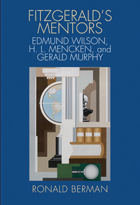 Fitzgerald's Mentors: Edmund Wilson, H. L. Mencken, and Gerald Murphy
Ronald Berman
University of Alabama Press, 2012 A fresh and compelling study of F. Scott Fitzgerald’s intellectual friendship with Edmund Wilson, H. L. Mencken, and Gerald Murphy Fitzgerald was shaped through his engagements with key literary and artistic figures in the 1920s. This book is about their influence— and also about the ways that Fitzgerald defended his own ideas about writing. Influence was always secondary to independence. Fitzgerald’s education began at Princeton with Edmund Wilson. There Wilson imparted to Fitzgerald many ideas about education and literary values, among them respect for the classics and an acute awareness of literary tradition. In New York H. L. Mencken impressed upon Fitzgerald his belief in the stifling effect of public morality on writers. Furthermore, Mencken’s The American Language changed Fitzgerald’s thinking about the power of everyday language. After moving to France in 1924, Fitzgerald’s intellectual life took a very different turn. Gerald Murphy exposed him to the visual arts— including the work of Fernand Leger, Pablo Picasso, and Man Ray—and to people deeply interested in the perception of art in daily life. Equally important, Fitzgerald had many discussions about artistic values with both Gerald and Sara Murphy.
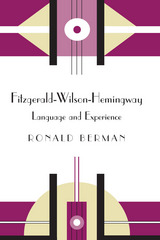 Fitzgerald-Wilson-Hemingway: Language and Experience
Ronald Berman
University of Alabama Press, 2003 In this study, Ronald Berman examines the work of the critic/novelist Edmund Wilson and the art of F. Scott Fitzgerald and Ernest Hemingway as they wrestled with the problems of language, experience, perception and reality in the "age of jazz." By focusing specifically on aesthetics—the ways these writers translated everyday reality into language—Berman challenges and redefines many routinely accepted ideas concerning the legacy of these authors.
Fitzgerald is generally thought of as a romantic, but Berman shows that we need to expand the idea of Romanticism to include its philosophy. Hemingway, widely viewed as a stylist who captured experience by simplifying language, is revealed as consciously demonstrating reality's resistance to language. Between these two renowned writers stands Wilson, who is critically influenced by Alfred North Whitehead, as well as Dewey, James, Santayana, and Freud.
By patiently mapping the correctness of these philosophers, historians, literary critics and writers, Berman aims to open a gateway into the era. This work should be of interest to scholars of American literature, philosophy and aesthetics; to academic libraries; to students of intellectual history; and to general readers interested in Fitzgerald, Hemingway and Wilson.
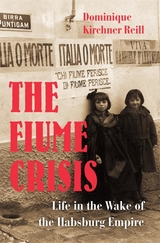 The Fiume Crisis: Life in the Wake of the Habsburg Empire
Dominique Kirchner Reill
Harvard University Press, 2020 Recasting the birth of fascism, nationalism, and the fall of empire after World War I, Dominique Kirchner Reill recounts how the people of Fiume tried to recreate empire in the guise of the nation.
The Fiume Crisis recasts what we know about the birth of fascism, the rise of nationalism, and the fall of empire after World War I by telling the story of the three-year period when the Adriatic city of Fiume (today Rijeka, in Croatia) generated an international crisis.
In 1919 the multicultural former Habsburg city was occupied by the paramilitary forces of the flamboyant poet-soldier Gabriele D’Annunzio, who aimed to annex the territory to Italy and became an inspiration to Mussolini. Many local Italians supported the effort, nurturing a standard tale of nationalist fanaticism. However, Dominique Kirchner Reill shows that practical realities, not nationalist ideals, were in the driver’s seat. Support for annexation was largely a result of the daily frustrations of life in a “ghost state” set adrift by the fall of the empire. D’Annunzio’s ideology and proto-fascist charisma notwithstanding, what the people of Fiume wanted was prosperity, which they associated with the autonomy they had enjoyed under Habsburg sovereignty. In these twilight years between the world that was and the world that would be, many across the former empire sought to restore the familiar forms of governance that once supported them. To the extent that they turned to nation-states, it was not out of zeal for nationalist self-determination but in the hope that these states would restore the benefits of cosmopolitan empire.
Against the too-smooth narrative of postwar nationalism, The Fiume Crisis demonstrates the endurance of the imperial imagination and carves out an essential place for history from below.
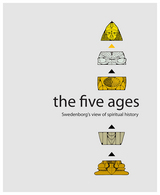 The Five Ages: Swedenborg's View of Spiritual History
Emanuel Swedenborg and P.L. Johnson
Swedenborg Foundation Publishers, 2009 The Five Ages: Swedenborg’s View of Spiritual History presents a compelling spiritual and psychological history of human evolution. It is a compilation of extracts from the works of the eighteenth-century Swedish philosopher and mystic Emanuel Swedenborg on the subject of the “world ages,” a concept that is found in many different cultures and mythologies. The Greeks and Romans called these epochs the Golden, Silver, Bronze and Iron Ages; Hindu mythology talks of the four yugas; Islam, meanwhile, refers to a pattern of the six major prophets. Similar timeframes appear in Norse, Persian, and Aztec mythology, but nowhere is this theme treated with such detail as in the works of Swedenborg. He divides human history into five biblically based ages: that of Adam, Noah, Moses, Jesus Christ, and a fifth one that is just unfolding, one predicted in the book of Revelation.
The Five Ages brings together passages from over twenty different works by Swedenborg, neatly linking them with an engaging and informative commentary in which P. L. Johnson compares and contrasts Swedenborg’s ideas with those from other cultures, placing them in the context of historical and archaeological knowledge gathered since Swedenborg’s time.
The book is illustrated throughout, featuring thirty helpful and charming black-and-white line drawings. It also contains a bibliography, a subject index, an index of quotations from the works of Swedenborg, and an appendix on “World Age Patterns.”
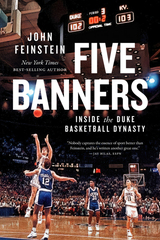 Five Banners: Inside the Duke Basketball Dynasty
John Feinstein
Duke University Press, 2024 On an early morning in 1983, after the worst loss of his career (109-66 against Virginia) and amid the cries of powerful athletics boosters calling for him to be fired, Duke men’s basketball coach Mike Krzyzewski went to breakfast at 2:00 a.m. to vent with friends. Sports journalist and Duke alumnus John Feinstein was at the table. For Coach K, "the night at Denny’s” would mark a turning point in his career and for the team, and eight years later, the Blue Devils would win their first NCAA national championship.
In Five Banners, Feinstein tells the inside history of Coach K’s forty-two-year career at Duke and its five NCAA championships, from the first, against Kansas in 1991, to the most recent, in 2015 against Wisconsin. With unparalleled access to Coach K, the team, and its staff, Feinstein takes readers on a mesmerizing ride into the locker room and onto the court. Full of intimate details, personal memories, and previously untold on- and off-court stories, it is a book that only Feinstein could write.
Feinstein explores a basketball legacy that begins with his days as an undergrad Duke Chronicle reporter covering coaches Bucky Waters and Neill McGeachy (who went 10-16 in one year as head coach), includes the “drought years” of the 1980s and the glory of the teams of the 1990s, and moves into the present day with Jon Scheyer’s succession. Drawing on new interviews, Feinstein highlights the voices of Grant Hill, Nolan Smith, Christian Laettner, Tommy Amaker, and Bobby Hurley, who each bring new insights on the championship years.
Throughout, Feinstein unveils the momentous force of college basketball as a game of intense relationships and intimate conversations. Candid, revelatory, and engrossing, Five Banners is an essential book for all Duke fans and anyone who loves the college game.
 Five Bay Landscapes: Curious Explorations of the Great Lakes Basin
Karen Lutsky and Sean Burkholder
University of Pittsburgh Press, 2022 Threatened by issues of environmental health, climate change, population growth, and industrial demands, the coastal zone of the Great Lakes reflects an increasingly dysfunctional relationship between the people of the basin and the resources that support them. Perhaps no place is the physical manifestation of this struggle more evident than in the basin’s shallow bays. While many regional and local responses to these issues focus on methods of control, Five Bay Landscapes argues that responses should begin with critical, experiential, and pluralistic understandings of place. Through a series of five narratives, each located on a bay within the Great Lakes, the authors share their practice of curious site explorations. These explorations, both written and visual, consider the nuances and systems of these shorelines along with the lessons these findings might offer for future design and planning interventions. Using the Great Lakes as a context, Five Bay Landscapes illuminates a dynamic and robust landscape system and establishes a series of methods for understanding, analyzing, and intervening within the changing landscape.
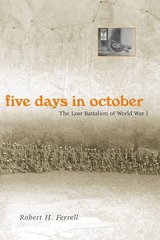 Five Days in October: The Lost Battalion of World War I
Robert H. Ferrell
University of Missouri Press, 2005 During American participation in World War I, many events caught the public’s attention, but none so much as the plight of the Lost Battalion. Comprising some five hundred men of the Seventy-seventh Division, the so-called battalion was entrapped on the side of a ravine in the Argonne Forest by German forces from October 2 to 7, 1918. The men’s courage under siege in the midst of rifle, machine-gun, mortar, and artillery fire (coming both day and night), with nothing to eat after the morning of the first day save grass and roots, and with water dangerous to obtain, has gone down in American history as comparable in heroism to the defense of the Alamo and the stand at the Little Big Horn of the troops of General George A. Custer. Now, in Five Days in October, historian Robert H. Ferrell presents new material—previously unavailable—about what really happened during those days in the forest. Despite the description of them as a lost battalion, the men were neither lost nor a battalion. The name was coined by a New York newspaper editor who, upon learning that a sizable body of troops had been surrounded, thought up the notion of a Lost Battalion—it possessed a ring sure to catch the attention of readers. The trapped men actually belonged to companies from two battalions of the Seventy-seventh, and their exact placement was well known, reported by runners at the outset of the action and by six carrier pigeons released by their commander, Major Charles W. Whittlesey, during the five days his men were there. The causes of the entrapment were several, including command failures and tactical errors. The men had been sent ahead of the main division line without attention to flanks, and because of that failure, they were surrounded. Thus began a siege that took the lives of many men, leading to the collapse of the colonel of the 308th Infantry Regiment and, many believe, to the suicide of Major Whittlesey three years later.
This book grew out of Ferrell’s discovery of new material in the U.S. Army Military History Institute at the Army War College from the papers of General Hugh A. Drum and in the National Archives in College Park, Maryland. The Drum papers contain the court-martial record of the lieutenant of a machine-gun unit attached to the battalions, who advised Major Whittlesey to surrender, while the Seventy-seventh Division files contain full accounts of the taut relations between the Lost Battalion’s brigade commander and the Seventy-seventh’s division commander. By including this material, Ferrell gives a new accounting of this intriguing affair. Five Days in October will be welcomed by all those interested in a fuller understanding of the story of the Lost Battalion.
Five Days of Bleeding
Ricardo Cortez Cruz
University of Alabama Press, 1995 Five Days of Bleeding is the black experience in sound, a fight to dance and celebrate cultural roots, and the struggle of a dark homeless woman, Zu-Zu Girl, to have voice in White America. Taunted by the violent character "Chops," Zu-Zu sings to keep her spirit alive in New York City's Central Park. Zu-Zu and the novel's narrator have a relationship which is transformed into a stormy, dreamlike urban affair. Their oppressive situation is depicted through multiple collages of sound and image, a funky mix of original and sampled cuts, both literary and musical.
The social chaos around them is remixed in a text consisting of street beats, classic breaks, and fresh-cool cadences. Bleeding proves that the loudest noises of moral panic can be gunshots, to be sure, but they can also be the very human sound of the music of hope and despair.
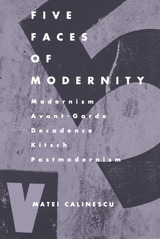 Five Faces of Modernity: Modernism, Avant-garde, Decadence, Kitsch, Postmodernism
Matei Calinescu
Duke University Press, 1987 Five Faces of Modernity is a series of semantic and cultural biographies of words that have taken on special significance in the last century and a half or so: modernity, avant-garde, decadence, kitsch, and postmodernism. The concept of modernity—the notion that we, the living, are different and somehow superior to our predecessors and that our civilization is likely to be succeeded by one even superior to ours—is a relatively recent Western invention and one whose time may already have passed, if we believe its postmodern challengers. Calinescu documents the rise of cultural modernity and, in tracing the shifting senses of the five terms under scrutiny, illustrates the intricate value judgments, conflicting orientations, and intellectual paradoxes to which it has given rise.
Five Faces of Modernity attempts to do for the foundations of the modernist critical lexicon what earlier terminological studies have done for such complex categories as classicism, baroque, romanticism, realism, or symbolism and thereby fill a gap in literary scholarship. On another, more ambitious level, Calinescu deals at length with the larger issues, dilemmas, ideological tensions, and perplexities brought about by the assertion of modernity.
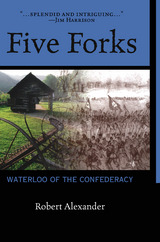 Five Forks: Waterloo of the Confederacy
Robert Alexander
Michigan State University Press, 2003
The Battle of Five Forks was one of the the last battles of the American Civil War. A week later, Lee surrendered. Two weeks later, Lincoln was dead. In this meditation on that battle, Alexander juxtaposes the story of the battle, which he tells through narrative, letters, and journal entries, with his own impressions, viewing the South through Northern eyes. In addition, he views contemporary American society through the story of the Civil War and specifically through the story of Five Forks. If it is true that we meet our past coming to us out of the future, then, Alexander posits, America is still grappling with issues unresolved by the Civil War. Those issues are not just the obvious ones of race and class, or of North vs. South, but also the more ephemeral issues surrounding the mythos Americans live by.
Alexander is not a historian, and this is much more a literary work than a battle story. However, the immediacy with which Alexander tells his tale leads the reader to experience Five Forks—the land, the smells, the cries—as if present there in 1865. Thus, he does not just describe a battle; he captures the spirit of all battles, all wars.
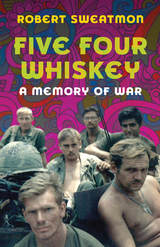 Five Four Whiskey: A Memory of War
Robert Sweatmon
Westholme Publishing, 2014 A Personal Reflection of a Frontline Soldier in Vietnam and Cambodia During the Cultural Maelstrom of the 1960s
In late 1969, twenty-year-old Robert Sweatmon received a letter informing him that he had ten days to report to the United States Army. Like thousands of others, he had been drafted. Assigned as a rifleman with a mechanized unit, the author began a year-long odyssey in the Southeast Asian wilderness that would change his and his fellow soldiers’ lives forever.
Taking its title from the nighttime radio code call and response between base camp and those on ambush patrol, Five Four Whiskey: A Memory of War is a moving account of life as a combat soldier in the Vietnam War. Set mostly in the sprawling woods and rubber plantations northwest of Saigon, the author explains what his unit was asked to do and what obstacles they faced, including an elusive but deadly enemy, multiple kinds of booby traps, and antitank mines. The author, a notable television personality following the war, does not sensationalize his account; rather, his book allows a new generation to understand the emotional and physical pressures of the times. Coming of age in the maelstrom of civil rights and the free love culture, the author and his fellow soldiers saw their idealism quickly vaporize in the face of the grim realities of war. Here they learned to compartmentalize their lives as a way to survive, but it was their strong bonds that ultimately kept them from succumbing to the madness that surrounded them. Kept in the field for almost the entire time of his tour, the author was in a unit selected to conduct a clandestine reconnaissance in Cambodia and then lead the 1970 invasion, where he was wounded. Following his convalescence, he was sent to Nui Ba Den, the fabled ghost mountain haunted by the spirit of a Vietnamese princess, until he received his papers that he had completed his combat service. At that moment, his year-long mental wall between soldier and civilian fell away as he counted the last terrifying hours before he was safely out of Vietnam. A tour-de-force of military memoir, written in an objective and often literary prose, Five Four Whiskey perfectly captures how ordinary civilian-soldiers survived an ordeal set in one of the most turbulent times in American history.
 The Five Health Frontiers: A New Radical Blueprint
Christopher Thomas
Pluto Press, 2022 'A brilliant exposé' - Danny Dorling
Covid-19 has exposed the limits of a neoliberal public health orthodoxy. But instead of imagining radical change, the left is stuck in a rearguard action focused on defending the NHS from the wrecking ball of privatization.
Public health expert Christopher Thomas argues that we must emerge from Covid-19 on the offensive - with a bold, new vision for our health and care. He maps out five new frontiers for public health and imagines how we can move beyond safeguarding what we have to a radical expansion of the principles put forward by Aneurin Bevan, the founder of the NHS, over 70 years ago.
Beyond recalibrating our approach to healthcare services, his blueprint includes a fundamental redesign of our economy through Public Health Net Zero; a bold new universal public health service fit to address the real causes of ill health; and a major recalibration in the efforts against the epidemiological reality of an era of pandemics.
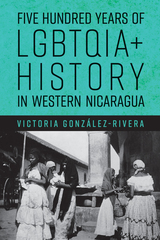 Five Hundred Years of LGBTQIA+ History in Western Nicaragua
Victoria González-Rivera
University of Arizona Press, 2024 This groundbreaking book reframes five hundred years of western Nicaraguan history by giving gender and sexuality the attention they deserve. Victoria González-Rivera decenters nationalist narratives of triumphant mestizaje and argues that western Nicaragua’s LGBTQIA+ history is a profoundly Indigenous one.
In this expansive history, González-Rivera documents connections between Indigeneity, local commerce, and femininity (cis and trans), demonstrating the long history of LGBTQIA+ Nicaraguans. She sheds light on historical events, such as Andres Caballero’s 1536 burning at the stake for sodomy. González-Rivera discusses how elite efforts after independence to “modernize” open-air markets led to increased surveillance of LGBTQIA+ working-class individuals. She also examines the 1960s and the Somoza dictatorship, when another wave of persecution emerged, targeting working-class gay men and trans women, leading to a more stringent anti-sodomy law.
The centuries prior to the post-1990 political movement for greater LGBTQIA+ rights demonstrate that, far from being marginal, LGBTQIA+ Nicaraguans have been active in every area of society for hundreds of years.
 Five Irish Writers: The Errand of Keeping Alive
John Hildebidle
Harvard University Press, 1989 Liam O'Flaherty, Kate O'Brien, Elizabeth Bowen, Sean O'Faolain, and Frank O'Connor--theirs were among the most distinctive voices in Irish fiction in the twentieth century. Born within a few years of each other near the turn of the century, they represented the first literary generation to come of age in the shadow of Ireland's twin monuments, Joyce's Ulysses and the poetry of William Butler Yeats, and their work has too long remained in that shadow.
Raised in different parts of Ireland and in widely differing milieux, all five lived through the turmoil of the revolution and civil war that gave birth to the Irish Republic and on into the disappointments of the thirties and forties. As their talents matured, each developed a unique vision of Ireland, comic or homely, angry or despairing. Despite its diversity, their fiction shares a sense of disillusionment, loneliness, and radical detachment from both culture and self.
John Hildebidle offers the first serious critical assessment of these writers. He examines the common themes and concerns that run through their work, among them family, war, the Troubles, myth, death, and exile. As he demonstrates, all five authors saw in the Ireland that grew out of the events of 1916-1923 a nation that stifled the creative energies and bright hopes of its youth, and their fiction can be seen as responding in diverse ways to that reality. Hildebidle's perceptive analysis of their works should do much to win these authors a place in the canon of modern fiction in English.
The extensive annotated bibliography includes writings by and about not only these five authors but also the Irish fiction writers who succeeded them.
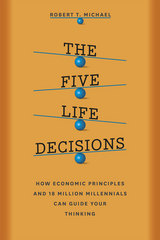 The Five Life Decisions: How Economic Principles and 18 Million Millennials Can Guide Your Thinking
Robert T. Michael
University of Chicago Press, 2016 Choices matter. And in your teens and twenties, some of the biggest life decisions come about when you feel the least prepared to tackle them.
Economist Robert T. Michael won’t tell you what to choose. Instead, he’ll show you how to make smarter choices. Michael focuses on five critical decisions we all face about college, career, partners, health, and parenting. He uses these to demonstrate how the science of scarcity and choice—concepts used to guide major business decisions and shape national legislation—can offer a solid foundation for our own lives. Employing comparative advantage can have a big payoff when picking a job. Knowing how to work the marketplace can minimize uncertainty when choosing a partner. And understanding externalities—the ripple of results from our actions—can clarify the if and when of having children.
Michael also brings in data from the National Longitudinal Survey of Youth, a scientific sample of 18 million millennials in the United States that tracks more than a decade of young adult choices and consequences. As the survey’s longtime principal investigator and project director, Michael shows that the aggregate decisions can help us understand what might lie ahead along many possible paths—offering readers insights about how their own choices may turn out.
There’s no singular formula for always making the right choice. But the adaptable framework and rich data at the heart of The Five Life Decisions will help you feel confident in whatever you decide.
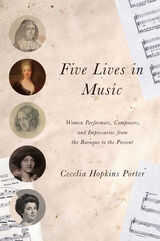 Five Lives in Music: Women Performers, Composers, and Impresarios from the Baroque to the Present
Cecelia Hopkins Porter
University of Illinois Press, 2014 Representing a historical cross-section of performance and training in Western music since the seventeenth century, Five Lives in Music brings to light the private and performance lives of five remarkable women musicians and composers. Elegantly guiding readers through the Thirty Years War in central Europe, elite courts in Germany, urban salons in Paris, Nazi control of Germany and Austria, and American musical life today, as well as personal experiences of marriage, motherhood, and widowhood, Cecelia Hopkins Porter provides valuable insights into the culture in which each woman was active. Porter begins with the Duchess Sophie-Elisabeth of Braunschweig-Lueneberg, a harpsichordist who also presided over seventeenth-century North German court music as an impresario. At the forefront of French Baroque composition, composer Elisabeth-Claude Jacquet de La Guerre bridged a widening cultural gap between the Versailles nobility and the urban bourgeoisie of Paris. A century later, Josephine Lang, a prodigiously talented pianist and dedicated composer, participated at various times in the German Romantic world of lieder through her important arts salon. Lastly, the twentieth century brought forth two exceptional women: Baroness Maria Bach, a composer and pianist of twentieth-century Vienna's upper bourgeoisie and its brilliant musical milieu in the era of Gustav Mahler, Richard Strauss, Arnold Schoenberg, and Erich Korngold; and Ann Schein, a brilliant and dauntless American piano prodigy whose career, ongoing today though only partially recognized, led her to study with the legendary virtuosos Arthur Rubinstein and Myra Hess. Mining musical autographs, unpublished letters and press reviews, interviews, and music archives in the United States and Europe, Porter probes each musician's social and economic status, her education and musical training, the cultural expectations within the traditions and restrictions of each woman's society, and other factors. Throughout the lively and focused portraits of these five women, Porter finds common threads, both personal and contextual, that extend to a larger discussion of the lives and careers of female composers and performers throughout centuries of music history.
 Five Manifestos for the Beautiful World: The Alchemy Lecture
Phoebe Boswell, Saidiya Hartman, Janaina Oliveira, Joseph M. Pierce, and Cristina Rivera Garza
Duke University Press, 2025 The second annual Alchemy Lecture brought together five artists, thinkers, and writers who proposed new ways of being and discussed radical visions for the future. Five Manifestos for the Beautiful World captures and expands these lectures to illuminate our path toward this possible beautiful world. Joseph M. Pierce (Cherokee Nation) asserts that “for this decolonial future to become possible, the guiding force must no longer be capital but relations.” Film curator Janaína Oliveira (Brazil) evokes music and movement as a means toward this relationality. Visual artist Phoebe Boswell (UK/Kenya) asks, “If we burn down the institution, what happens next?” Saidiya Hartman (US) prompts us to consider our capacity to burn, examining whether “the gift of pragmatism yields a profound tolerance of the unlivable.” Cristina Rivera Garza (US/Mexico) gives us the language of the future in the subjunctive, “the smuggler who crosses the border of the future bearing unknown cargo.” Each alchemist is intimately concerned with this cargo, our ability to bear its weight, and how we might find the beautiful world together.
The Five Megilloth and Jonah: The JPS Audio Version
JPS: The Jewish Publication Society
Jewish Publication Society, 2009 The JPS TANAKH: The Jewish Bible, audio version is a recorded version of the JPS TANAKH, the most widely read English translation of the Hebrew, or Jewish, Bible. Produced and recorded for The Jewish Publication Society (JPS) by The Jewish Braille Institute (JBI), this complete, unabridged audio version of the Five Megilloth and Jonah features over 2 hours of readings by 6 narrators.
These short books of the Bible, each read in connection with a Jewish holy day, constitute a literature unto themselves--a poetic, spiritual, and literary treasure.
The recordings in this series include readings of The Song of Songs, Ruth, Lamentations, Ecclesiastes, Esther, and Jonah.
 Five Men: Character Studies From The Roman Empire
Martin Percival Charlesworth
Harvard University Press In this sixth volume of the Martin Classical Lectures Professor Charlesworth sets before his readers certain types of people, their lives and their achievements, and the way in which they fitted into the scheme of the Roman Empire. As the type of native ruler, he chooses Agrippa I; as the philosopher, Musonius Rufus; as the adventurer, Josephus; and as the administrator, Agricola. To illustrate the type of Roman merchant, however, he has been obliged to give a composite picture, for there is no one figure in the world of commerce and travel in Roman times who stands out in the way the others did or of whom we have any long, connected account. By making each of his types seem a part not only of Roman life but of all history, he gives a skillfully indirect picture of Roman civilization to the beginning of our era and he arouses our interest in a past out of which we can still gain help for fashioning the present and the future.
Five Mountains: The Rinzai Zen Monastic Institution in Medieval Japan
Martin Collcutt
Harvard University Press, 1981 In Japan today, Zen monastic life is practiced substantially as it was practiced in medieval Japan or Sung dynasty China. More than twenty-one thousand Zen temples are active. This book examines the Zen monastery as a major institution in medieval Japanese society. Focusing on the Five Mountains network of officially sponsored Zen monasteries, it describes the transmission of Rinzai and Soto Zen to Japan, traces the patterns of secular patronage, and discusses in detail the Zen monastic environment, the monastic rule, the community, and the economy.
This is the first detailed study in any Western language of the social and institutional development of Zen Buddhism. Martin Collcutt’s illustrated text should be valuable to those interested in medieval Japanese history as well as students of Zen practice and Zen-related culture.
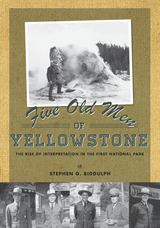 Five Old Men of Yellowstone: The Rise of Interpretation in the First National
Stephen Biddulph
University of Utah Press, 2013 Yellowstone has undergone a number of transitions in the 140 years since its national park designation in 1872. The period from the late 1930s through the early 1970s marked one of the most significant as the Park Service shifted focus from public recreation to interpretation and education. The vast wilderness and numerous awe-inspiring natural spectacles of the park became less objects of passive enjoyment and more subjects to be engaged, interpreted, and understood by visitors. The park was transformed from a playground into a classroom where active learning processes could take place. Charged with instituting these interpretive interactions were five remarkable ranger naturalists who served as both protectors and educators. Stephen Biddulph tells the story of the five men, his own father amongst them, tasked with inspiring a generation of visitors to the park.
Biddulph’s masterfully woven narrative—part biography, part historical narrative—offers both fascinating factual details about Yellowstone and charming colloquial story telling. The interpretive initiatives of the rangers—nature walks, campfire programs, game stalks, and auto caravans—are enlivened by the colorful personalities of the five men who conducted them. Historians will find that Five Old Men of Yellowstone provides a missing link in the park’s extensive literature, while its humor and sentiment make for an accessible book that will be enjoyed by park history buffs and curious visitors alike.
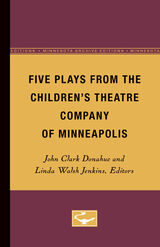 Five Plays from the Children’s Theatre Company of Minneapolis
John Clark Donahue and Linda Walsh Jenkins, Editors
University of Minnesota Press, 1975
Five Plays from the Children's Theatre Company of Minneapolis was first published in
1975. Minnesota Archive Editions uses digital technology to make long-unavailable books once again accessible, and are published unaltered from the original University of Minnesota Press editions.
Among the notable productions of the Children's Theatre Company of the Minneapolis Society of Fine Arts, a leading exponent of children's theater in this country, have been plays that are adaptations of classics in children's literature. This volume makes available the scripts of five of these adaptations, along with illuminating information about the productions and the company itself.
The plays include two adaptations by Frederick Gaines, two by Timothy Mason, and one by Richard Shaw. Mr. Gaines's plays are based on Washington Irving's The Legend of Sleepy Hollow and Charles Dickens's A Christmas Carol.One of Mr. Mason's plays, Kidnapped in London, is an adaptation of part of Master Skylark by John Bennett, and the other, Robin Hood: A Story of the Forest, is based on part of the Robin Hood legend. Mr. Shaw's play is an adaptation in Kabuki form of the Grimms' fairy tale Sleeping Beauty.
Linda Walsh Jenkins writes a general introduction and commentary. Background information about each play includes excerpts from discussions among directors, composers, designers, and playwrights about the plays themselves and about various phases of the development of the productions. Highlights of the history of the Children's Theatre Company and of the aims and accomplishments of its director, John Clark Donahue, are given, and these will be of particular interest to anyone in the children's theater field.
The photographic illustrations, which include a number in color, show various aspects of Children's Theatre Company productions. There are also musical examples from the original scores for the plays.
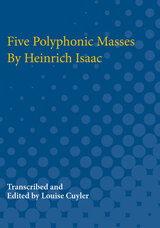 Five Polyphonic Masses By Heinrich Isaac
Transcribed and Edited by Louise Cuyler
University of Michigan Press, 1956 During the brilliant age that produced a Machiavelli and an Erasmus, Heinrich Isaac became one of the recognized masters of secular as well as religious music. Before his death in 1517 he had served both Lorenzo the Magnificent in Florence and Emperor Maximilian I in Vienna and Augsburg. His Choralis Constantinus ranks with Johann Sebastian Bach's Art of the Fugue as one of the epochal works in the history of music. But it is only with the publication of these Five Polyphonic Masses that the entire Formschneider first edition (Nürnberg, 1555) is at last made available to modern scholars and musicians.Unquestionably the most serious and most significant of Isaac's varied and numerous works are his Masses. Among his finest and most characteristic are these five magnificent settings for the Ordinary of the Mass, which appear at the close of Part III of the Choralis. In the present modern notation, after three centuries, they again take their place as music to be performed.
Five Portraits: Modernity and the Imagination in Twentieth-Century German Writing
Michael Bernstein
Northwestern University Press, 2000 In Five Portraits, one of the most acute critical thinkers of our time presents essays on five of the most important writers of the past hundred years: Rainer Maria Rilke, Paul Celan, Robert Musil, Martin Heidegger, and Walter Benjamin. The result is a remarkable examination of a moment when these writers, caught between the dream of creating an abiding masterpiece and the reality of a brutal culture fascinated by apocalyptic catastrophe, deliberately put themselves and their work at the center of the storm. Written in elegant and jargon-free prose, Michael Andre Bernstein's essays create a vivid image of an epoch whose aspirations and torments continues to shape the world we inhabit today.
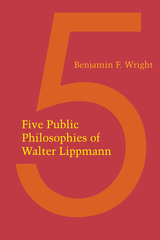 Five Public Philosophies of Walter Lippmann
By Benjamin F. Wright
University of Texas Press, 1973 Essayist, editor, columnist, author of many books, and winner of a special Pulitzer Prize citation in 1958 for his powers of news analysis, Walter Lippmann both appraised and influenced twentieth-century American politics. No other author of the century dealt with the persistent problems of politics from so many approaches, was so widely read, or varied so widely in his conclusions. Benjamin F. Wright’s study is the first book devoted to an exposition and analysis of Lippmann’s nine “books of political philosophy,” as James Reston called them. These books provide a fascinating study of changes in the political and economic ideas of the most important journalist of his time. Lippmann’s books published in 1913 and 1914 reflect the optimism of the Progressive Era, of faith in science and in the ability of people to choose their goals and attain them. In 1922 and 1925, while editor of the New York World, Lippmann wrote searching, often pessimistic analyses of what he believed to be the prevailing assumptions regarding the nature and role of public opinion. Although in the Coolidge era he relegated government to a minor role as mediator, he became an enthusiastic defender of the achievements of the early New Deal. Two years later in a longer look, he found the same New Deal following the path toward totalitarianism. Keynes was discarded and his place taken by the economics of Adam Smith, bolstered by the common law of Coke and the Constitution of the founders. Finally, in 1955, in the extremely popular and very engaging Public Philosophy, there is a lament for the “decline of the West” and a plea to return to the age of civility and natural law. In a final analytical chapter, Wright presents a critique of Lippmann’s historical understanding and the modern applications of the tradition of natural law. He also assesses Lippmann’s inability to translate the “public philosophy” into programs or institutional changes and the failure to account for the expansion of governmental functions together with the continued strength of constitutional democracy in the West.
Five Rings: The Super Bowl History of the New England Patriots (So Far)
Jerry Thornton
University Press of New England, 2018 Since 2001 the Patriots have played in eight Super Bowl championships and won five, a run of excellence unparalleled in all of professional sports. In a league designed to ensure that no one franchise can dominate over time, New England won for over a decade and a half. A dynasty that began with an improbable run to a championship in 2001 has rebuilt, rebooted, and retooled several times over, winning most recently in 2017. But during those years, no other franchise reached the same level of controversy, drama, and turmoil—or even came close. Jerry Thornton, bestselling author of From Darkness to Dynasty, provides an all-access pass to the Patriots’ years of unparalleled greatness from the unique perspective of an observant, obsessive, utterly dedicated fan.
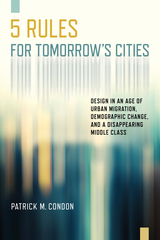 Five Rules for Tomorrow's Cities: Design in an Age of Urban Migration, Demographic Change, and a Disappearing Middle Class
Patrick M. Condon
Island Press, 2019 How we design our cities over the next four decades will be critical for our planet. If we continue to spill excessive greenhouse gas into the atmosphere, we will run out of time to keep our global temperature from increasing. Since approximately 80% of greenhouse gases come from cities, it follows that in the design of cities lies the fate of the world.
As urban designers respond to the critical issue of climate change they must also address three cresting cultural waves: the worldwide rural-to-urban migration; the collapse of global fertility rates; and the disappearance of the middle class. In Five Rules for Tomorrow’s Cities, planning and design expert Patrick Condon explains how urban designers can assimilate these interconnected changes into their work.
Condon shows how the very things that constrain cities—climate change, migration, financial stress, population change—could actually enable the emergence of a more equitable and resource-efficient city. He provides five rules for urban designers: (1) See the City as a System; (2) Recognize Patterns in the Urban Environment; (3) Apply Lighter, Greener, Smarter Infrastructure; (4) Strengthen Social and Economic Urban Resilience; and (5) Adapt to Shifts in Jobs, Retail, and Wages.
In Five Rules for Tomorrow’s Cities, Condon provides grounded and financially feasible design examples for tomorrow’s sustainable cities, and the design tools needed to achieve them.
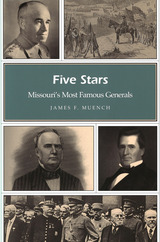 Five Stars: Missouri's Most Famous Generals
James F. Muench
University of Missouri Press, 2006 Missouri’s history is replete with strong and adventurous leaders, from Lewis and Clark to Harry S. Truman. It is no surprise, then, that the Show-Me State has produced a great number of military men and women, including thirty who attained the rank of general. In this clearly written and richly illustrated book, James F. Muench has profiled five of the best-known figures: Alexander William Doniphan, Sterling Price, Ulysses S. Grant, John J. Pershing, and Omar Bradley. These men represent a number of historical eras–from the Mexican-American War through World War II–and a variety of social and cultural backgrounds. Doniphan, who served in the Mexican-American War, and Price, who served in the Civil War on the Confederate side, were citizen soldiers who rose through the ranks of their local militias. Grant, who served in the Civil War on the Union side; Pershing, who served in World War I; and Bradley, who served in World War II, were professional soldiers who represented the trend in the modern army as general as manager and graduated from the United States Military Academy at West Point. While noting the diversity among the generals, Muench also is careful to emphasize the connections and commonalities among them. Five Stars: Missouri’s Most Famous Generals dedicates one chapter to each general. With lively, clear language, Muench gives readers an effective and entertaining primer on the lives and times of Missouri’s celebrated generals and their roles in American history, focusing in particular on their battlefield exploits. This book is sure to appeal to anyone interested in Missouri history, as well as those interested in military leadership.
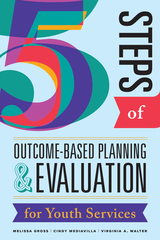 Five Steps of Outcome-Based Planning & Evaluation for Youth Services
Melissa Gross, Cindy Mediavilla, and Virginia A. Walter
American Library Association, 2022 Outcome-based planning and evaluation (OBPE), with its straightforward approach built on a flexible framework, is the perfect model to enable youth services professionals to deliver effective services regardless of uncertainties. An outcome-based approach can help youth services stay grounded in producing desired outcomes with and for youth through responsive programs, services, and processes that can adapt to changing conditions. Clarifying the relationship between planning, program development, and evaluation, the five simple steps outlined in this book will help youth services staff conduct solid community assessments and integrate OBPE into their work. Inside its pages you will learn - a short history of OBPE and its evolution;
- why it is crucially important to involve youth in all stages of program development, with guidance on navigating challenges;
- how to think about planning as the need to react quickly, whether due to natural or human-made disasters, changing demographics, or economic swings;
- the five steps of OBPE, from gathering information about your community and determining the outcomes that will serve your community to crafting accurate outcome statements, developing an evaluation plan, and maximizing the results of successful outcome-based programs;
- how to visualize the steps needed to successfully plan, implement, and evaluate an outcome-based program, using the template included in the book;
- ways to share your data to let people know the library’s important role in the community; and
- additional useful tools to bolster your work, including environmental scan forms and ideas for creating relevant family storytimes.
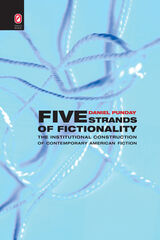 Five Strands of Fictionality: The Institutional Construction of Contemporary American Fiction
Daniel Punday
Ohio State University Press, 2010 Fictions, we are so often told, are everywhere in America today. The extravagant claims of advertising are everywhere, much of the day’s news concerns “pseudo-events” like rallies or ceremonies staged so that they can be reported on, and philosophers doubt even the possibility of any knowledge being objective. Thus we seem less and less able to distinguish between the real and the invented. In Five Strands of Fictionality: The Institutional Construction of Contemporary American Fiction, Daniel Punday examines the “postmodern” expansion of fictionality—the feeling today that the line between the real and the invented is harder to draw—and argues that this feeling reflects a struggle by different cultural groups to define how we tell and use “literary” stories. He discusses the literary texts of John Barth, Alice Walker, and Ishmael Reed; paraliterary forms like science fiction and electronic writing; and resolutely nonliterary texts, especially role-playing games, in terms of how each responds to the institution of literature through its definition of fictionality. For too long, postmodernism has been described by easy generalizations—relativist, indeterminate, commercialized—that have rendered the term nearly worthless. Punday applies a more nuanced understanding of fictionality to a variety of contemporary narrative forms that occupy different locations within postmodern literary culture. Approaching postmodernism as a configuration of institutions that legitimize fictionality, he illuminates the nature of creative writing and the conflicts between different literary groups in America today.
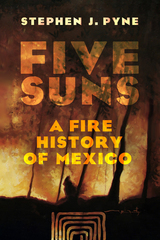 Five Suns: A Fire History of Mexico
Stephen J. Pyne
University of Arizona Press, 2024 A climate defined by wet and dry seasons, a mostly mountainous terrain, a biota prone to disturbances, a human geography characterized by a diversity of peoples all of whom rely on burning in one form or another: Mexico has ideal circumstances for fire, and those fires provide a unique perspective on its complex history.
Narrating Mexico’s evolution of fire through five eras, historian Stephen J. Pyne describes the pre-human, pre-Hispanic, colonial, industrializing (1880–1980), and contemporary (1980–2015) fire biography of this diverse and dynamic country. Creatively deploying the Aztec New Fire Ceremony and the “five suns” that it birthed, Pyne addresses the question, “Why does fire appear in Mexico the way it does?” Five Suns tells the saga through a pyric prism.
Mexico has become one of the top ten “firepowers” in the world today through its fire suppression capabilities, fire research, and industrial combustion, but also by those continuing customary practices that have become increasingly significant to a world that suffers too much combustion and too little fire.
Five Suns completes a North American fire-history trilogy written by Pyne over the past 40 years, complementing his histories of Canada and the United States.
 Five Tales for the Theatre
Carlo Gozzi
University of Chicago Press, 1989 For Count Carlo Gozzi (1720-1806), theater was a fabulous world apart, in which human beings, statues, and animals change places by magical transformations. Gozzi's stage becomes a multiscenic home for adventures, loves, enmities, and dazzling visual effects. This collection brings together for the first time modern English translations of five of Gozzi's most famous plays: The Raven, The King Stag, Turandot, The Serpent Woman, and The Green Bird, each annotated by the translators and preceded by the author's preface. Ted Emery's Introduction places Gozzi in his social and historical context, tracing his world view in both the content and the form of his tales.
In the ten works he called fiable or fairy tales, Gozzi intermingled characters from the traditional and improvised commedia dell'arte with exotic figures of his own invention. During Gozzi's lifetime, Goethe and Schiller translated and produced some of his dramas at the Weimar Theatre. In our century, the dramas have reasserted themselves under the direction of Max Reinhardt, Vsevolod Meyerhold, George Devine, and Benno Besson, as well as in operatic adaptations by Puccini and Prokofiev.
The powerful conflicts, the idyllic and fearsome settings, and the startling transformations in these plays offer exceptional opportunities to actors, directors, and designers. The lively translations are faithful to Gozzi's Italian, while being eminently playable for English-speaking audiences today. Two of the translations have already had highly successful stagings by Andrei Serban at the American Repertory Theatre and on tour.
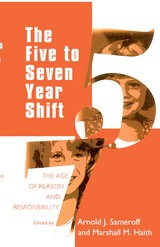 The Five to Seven Year Shift: The Age of Reason and Responsibility
Edited by Arnold J. Sameroff and Marshall M. Haith
University of Chicago Press, 1996 With increasing numbers of children suffering emotional, educational, and social failure on entering school, the years from five to seven have returned to prominence in developmental psychology. This volume collects state of the art research on child behavior in the school transition years.
Leading researchers in neurology, sociology, anthropology, education, and psychology assess what is now commonly known as the five to seven year shift. They consider how development is influenced by changes in neurobiological subsystems; cognition, emotion, and self-concept; concerns with peers and families; and school and cultural practices. They find that important transitions in behavior and environment do take place in this period, and are best described in terms of the qualitative increase in complexity due to interactions among ecological systems.
This volume increases our understanding of both child development and the study and treatment of children at home and at school. It will interest researchers, clinicians, and students of psychology and education.
 Five Tragic Hours: The Battle of Franklin
James Lee McDonough
University of Tennessee Press, 1984 On a November afternoon in 1864, the weary Gen. John Bell Hood surveyed the army waiting to attack the Federals at Franklin, Tennessee. He gave the signal almost at dusk, and the Confederates rushed forward to utter devastation. This book describes the events and causes of the five-hour battle in gripping detail, particularly focusing on the reasons for such slaughter at a time when the outcome of the war had already been decided.
The genesis of the senseless tragedy, according to McDonough and Connelly, lay in the appointment of Hood to command the Army of Tennessee. It was his decision to throw a total force of some 20,000 men into an ill-advised frontal assault against the Union troops. The Confederates made their approach, without substantial artillery support, on a level of some two miles. Why did Hood select such a catastrophic strategy? The authors analyze his reasoning in full. Their vivid and moving narrative, with statements from eyewitnesses to the battle, make compelling reading for all Civil War buffs and historians.
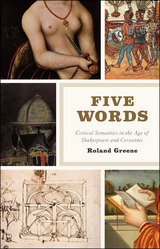 Five Words: Critical Semantics in the Age of Shakespeare and Cervantes
Roland Greene
University of Chicago Press, 2013 Blood. Invention. Language. Resistance. World. Five ordinary words that do a great deal of conceptual work in everyday life and literature. In this original experiment in critical semantics, Roland Greene considers how these words changed over the course of the sixteenth century and what their changes indicate about broader forces in science, politics, and other disciplines.
Rather than analyzing works, careers, or histories, Greene discusses a broad swath of Renaissance and transatlantic literature—including Shakespeare, Cervantes, Camões, and Milton—in terms of the development of these five words. Aiming to shift the conversation around Renaissance literature from current approaches to riskier enterprises, Greene also proposes new methods that take advantage of digital resources like full-text databases, but still depend on the interpreter to fashion ideas out of ordinary language. Five Words is an innovative and accessible book that points the field of literary studies in an exciting new direction.
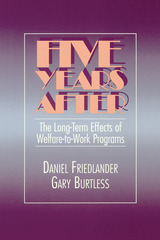 Five Years After: The Long-Term Effects of Welfare-to-Work Programs
Daniel Friedlander
Russell Sage Foundation, 1995 Friedlander and Burtless teach us why welfare reform will not be easy. Their sobering assessment of job training programs willenlighten a debate too often dominated by wishful thinking and political rhetoric. Look for their findings to be cited for many years to come. —Douglas Besharov, American Enterprise Institute A methodologically astute study that sheds considerable light on the potential for and limits to raising the employment and earnings of welfare recipients and provides benchmarks against which the impacts of later programs can be compared. —Journal of Economic Literature With welfare reforms tested in almost every state and plans for a comprehensive federal overall on the horizon, it is increasingly important for Americans to understand how policy changes are likely to affect the lives of welfare recipients. Five Years After tells the story of what happened to the welfare recipients who participated in the influential welfare-to-work experiments conducted by several states in the mid-1980s.The authors review the distinctive goals and procedures of evaluations performed in Arkansas, Baltimore, San Diego, and Virginia, and then examine five years of follow-up data to determine whether the initial positive impact on employment, earnings, and welfare costs held up over time. The results were surprisingly consistent. Low-cost programs that saved money by getting individuals into jobs quickly did little to reduce poverty in the long run. Only higher-cost educational programs enabled welfare recipients to hold down jobs successfully and stay off welfare. Five Years After ends speculation about the viability of the first generation of employment programs for welfare recipients, delineates the hard choices that must be made among competing approaches, and provides a well-documented foundation for building more comprehensive programs for the next generation. A sobering tale for welfare reformers of all political persuasions, this book poses a serious challenge to anyone who promises to end welfare dependency by cutting welfare budgets.
|
|
